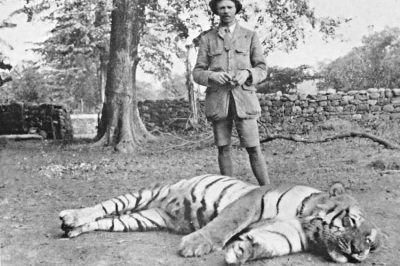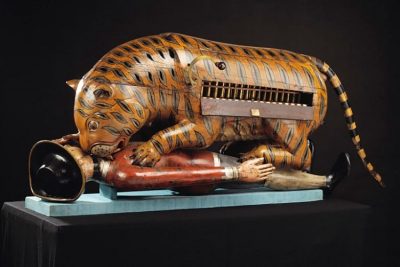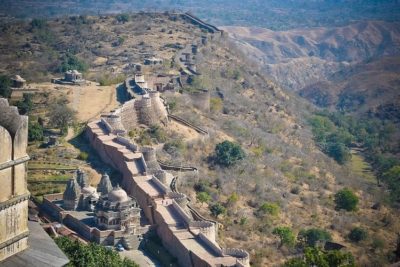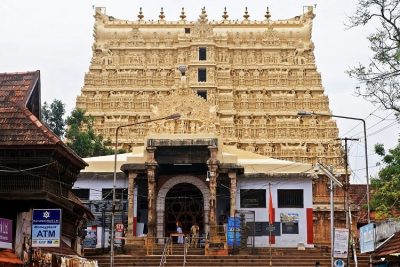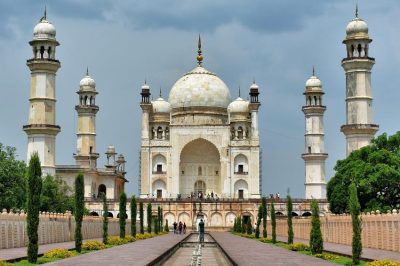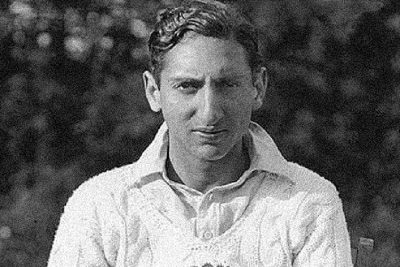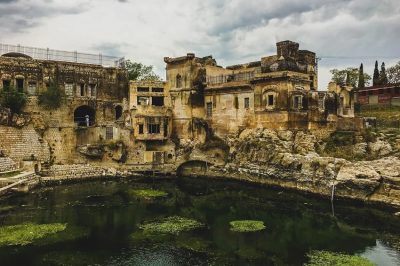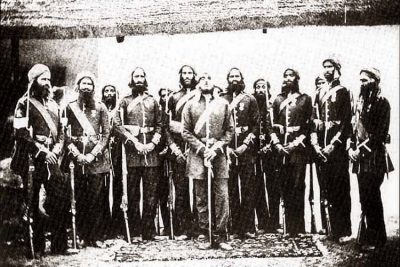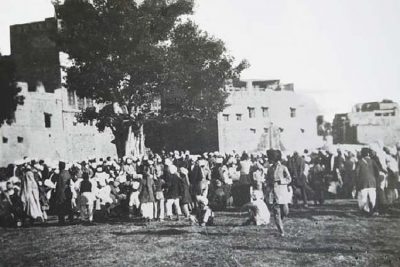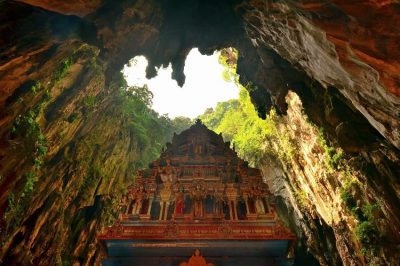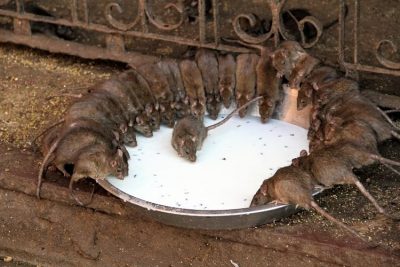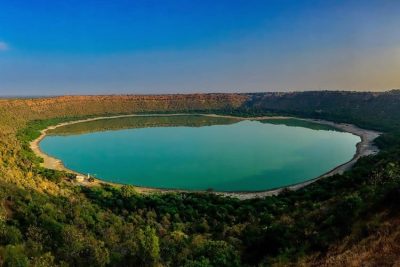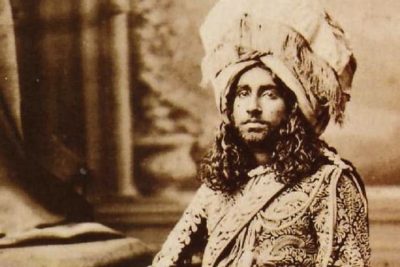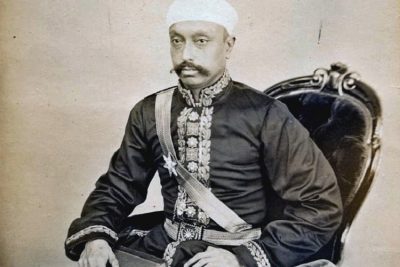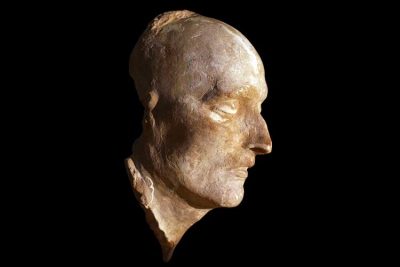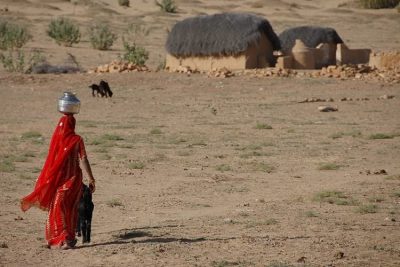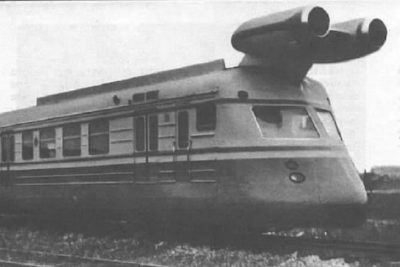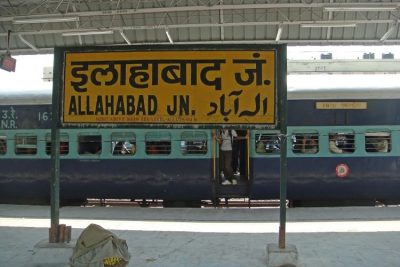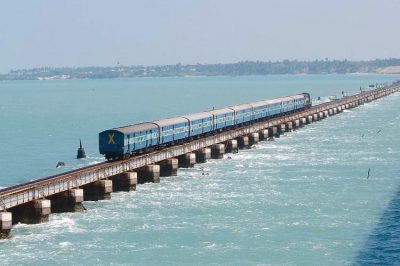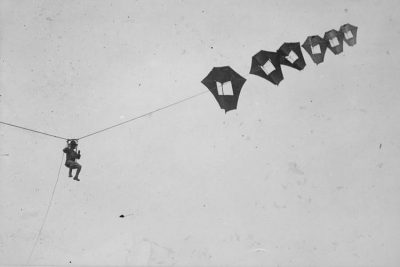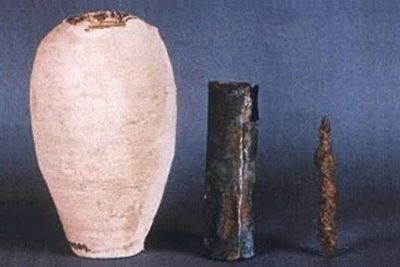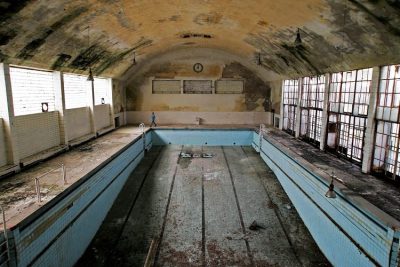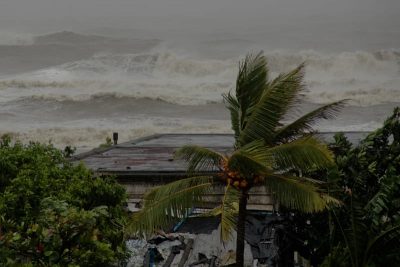The post Roopkund Lake: What are Hundreds of Bones Doing Around a Lake in Uttarakhand? appeared first on .
]]>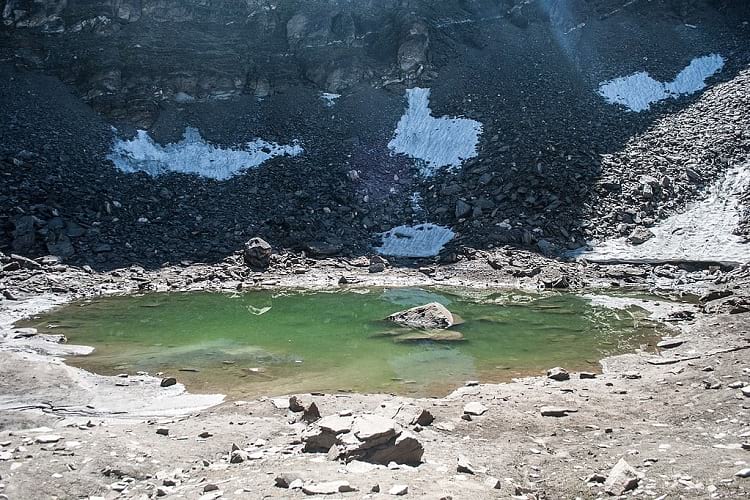
Roopkund lake. (Schwiki / Wikimedia Commons)
Roopkund is a glacial lake situated in the Himalayan range in the state of Uttarakhand, India. Also known as the Skeleton Lake, this beautiful Himalayan Lake is very shallow, with a substantial depth of approximately two meters. Owing to its mysterious nature, it is a popular location for trekkers and adventurous tourists.
A ranger belonging to Nanda Devi National Park discovered this lake filled with human remains, in 1942. Whenever the ice melts in this region, bones from hundreds of skeletons become visible on its bed. It is estimated that skeletons of 300 different people have been recuperated from this lake along with objects such as jewellery, wood, and some iron artefacts. A few of the skeletons had flesh still fixed to the bones mainly due to the cold and harsh conditions of the area.
Where did the skeletons in Roopkund come from?
The tales of the Skeleton lake were famous among the locals prior to its discovery. When the ranger’s discovery captured the attention of those who were interested, it raised a lot of unanswered questions. The British Empire speculated that the bodies were of Japanese soldiers, who had been trekking across India during the Second World War.
An investigating squad that was sent to the place at the time of discovery ruled out this possibility based on the fact that the remnants were too ancient to be from the war. Later, a radioactive carbon dating procedure revealed that these bodies were in fact from the mid-ninth century, around 850 AD.

Bones in Roopkund Lake. (Ashokyadav739 / Wikimedia Commons)
The mystery surrounding their death was theorized in 2013 by a few scientists. They speculated that the bodies belonged to two groups, one group was a closely related group, like a family, and the other consisted of unlike people. There was a significant difference in the heights of the bodies of the first group that was estimated to be a family, being much longer than the other group leading to a theory that the shorter group consisted of local people.
A DNA analysis showed that the taller group had origins from Iran and the shorter group, indeed, had local ancestry. This finding suggested that the family were likely to be pilgrims going through the area with the help of local guides when something unfortunate happened to them. The cause of their death had many speculative answers, like a landslide or a mass suicide.
However, a local legend provided details of the remains. According to him, the entourage of King of Kanauj, Raja Jasdhaval and his wife Rani Balampa who was pregnant at that time had set off to Nanda Devi Shrine to attend a festival that is celebrated after every twelve years. As they were on the move, the group was confronted by a strong hail storm. As there was nowhere to seek shelter in the open grounds, the whole group succumbed near the lake.

During summer when the ice begins to melts, bones belonging to hundreds of people become visible on its bed. (Ashokyadav739 / Wikimedia Commons)
Validating the story
Scientific analysis of the bones confirmed the legend’s explanation. The tests revealed that their heads and shoulders were struck with something blunt equal to the size of a cricket ball which cracked their skulls. Hence, it has been deduced that an unexpected hail storm in the area was the cause of their deaths. Their bodies remained frozen in the lake, at an altitude of 16,000 ft, for more than 1200 years until their discovery during the Second World War.

Roopkund lake can be reached after trekking through Bedni Bugyal. (Djds4rce / Wikipedia Commons)
The movement of tourists near the lake has proven to be disruptive to the environment surrounding the lake and the skeletons in them. The Indian Government has taken measures to preserve and protect this area. However, at times, the tourists tend to swipe a bone as a macabre souvenir that has been proven to be a loss this historic site. In order to preserve the bones, 3D scans of the bones are being done to digitally document them.
Enjoyed this article? Also, check out “The Unsolved Mystery Behind the Devil’s Tramping Ground in North Carolina“.
Not Recommended Visit:
Roopkund Lake | Uttarakhand
Fact Analysis:
STSTW Media strives to deliver accurate information through careful research. However, things can go wrong. If you find the above article inaccurate or biased, please let us know at [email protected].
RELATED
The post Roopkund Lake: What are Hundreds of Bones Doing Around a Lake in Uttarakhand? appeared first on .
]]>The post Champawat Tiger: The Killer of 436 Humans is a Case of Animal-Need Pitted against Human-Greed appeared first on .
]]>
The head of Champawat Tiger. (Nihal Neerrad S / Wikimedia Commons)
Today, the Asian Tigers are a threatened species with just about 3200 thriving units. The number was a lakh (hundred thousand) a century back. The most numerous subspecies, Bengal Tigers, is reduced to 2500 and is also endangered according to IUCN. Man’s itch for infrastructure development and professional hunting has led to this drastic depletion. Tigers are not the natural enemies of man, but may turn on him following injury, and the exigencies of living space. The story of the Champawat tiger, a Bengal tigress that killed 436 humans, is a classical example.
The killing started in Nepal and extended to Kumaon
In the 19th century British ruled India, a Bengal tigress in the Himalayan range of Western Nepal turned into a man-eater. A man of Tharu tribe from Rupal village was her first victim. Professional hunters were called and put on the mission to kill the tigress. But the tigress was too swift and cunning to be caught. Next, in an upscale measure, the army was put on job. Army gheraoed the tigress (who, post her death much later, would be named as Champawat Tiger), but she escaped by crossing over to an adjoining habitat.
Kumaon district, across river Sarda, became her new home, and a terror zone for the natives living there. For seven years, the tigress struck men women and children with brazen audacity, even during the day time, if the opportunity presented itself. An estimated 436 humans fell prey to the deviant wild cat.
Only hassled and handicapped tigers attack men
Tigers normally don’t attack humans for food. They do so only in some exceptional circumstances. In the case of Champawat tiger, it was a hunter’s bullet that failed to kill her but smashed her upper and lower right canines. This injury constrained her from catching its natural prey. And the pangs of hunger forced the tigress to an easier catch, the humans. Another contributing factor was the rampant deforestation done by the British government. The exercise done in the name of infrastructure development was a direct infringement on the living space of the wildlife.
Verily, a fight between man and nature
As man was busy asserting his power on nature, the Bengal tigress was out asserting her power on mankind. Best time for the kill was the day time, when men moved out for work. So, most of her attacks occurred during the day. Even those who rested in the 4 walls of their homes, weren’t spared. Human habitation became her food-spread which she walked into whenever hungry.
Surreptitious killings created mayhem
Ferocious canine teeth, brute power and the quick reflexes of a tiger can freeze any human with fear. The ears of a tiger can hear a wide range of frequencies from 0.2 kHz to 100 kHz, they also have a strong sense of smell. Ears can also rotate on base to catch sound from a particular direction. These endowments make the big cat a stealth killer. Time and again skilled hunters, police and military were engaged to kill the tigress, but to no avail. Orthodox and the God-fearing natives even started believing that it was some kind of a curse from the nether world. Gripped with fear, people stopped moving out of homes. Ironically, even homes weren’t safe. The tigress attacked people sleeping in huts, travelling on boats and even those who perched on trees.
Finally, the British administration couldn’t take it any longer. In the year 1907, the deputy commissioner of Nainital, Charles Henry Berthoud, was determined to do ‘something’. He went out to meet his friend, Jim Corbett.
Jim Corbett was tasked to kill the man-eater
Jim Corbett was a renowned hunter and a railroad worker of Irish lineage. Born and brought up in Kumaon hills, he had spent quality time with native hunters of Kaladhungi forests. Killing of a leopard at the age of 10 was his first landmark, and many more would follow. Berthoud wanted Jim to go after the Bengal tigress. Even though Jim had no hands-on experience of dealing with a man-eater, he agreed to give it a try. He didn’t have to wait for long to go ahead on the task. A fresh killing was reported just 5 days later. A woman astride a tree, plucking leaves for fodder, was pounced upon and killed. This happened in a town 60 miles away. Jim packed up, took six natives as helpers, and headed towards the town.
Village Champawat became the name and the nemesis
On reaching the destination, he saw villagers in a state of shock. As for the tigress, there were no signs of her. So, he decided to wait and watch. A nearby village, Champawat, was frequented by the tigress in the past. The village would go on to become the nemesis, as well as the enduring identity of the tigress as ‘Champawat tiger’. On the advice of the villagers, Jim moved towards this village and got the ultimate lead, a yet another kill. A 16-year-old girl was mauled by the tigress and dragged deep into the woods. The trail was marked by fresh blood. Jim followed the trail and found the victim’s skirt in a distant valley. In the near vicinity were seen scattered pieces of bones, and a severed human leg. Warm blood was still oozing from the leg. Obviously, the man-eater was somewhere near. The thought gave him a mix of hope and fear, and an alert Jim spent hours sitting in a hideout, his finger pressed to trigger. But the big cat eluded him, and he was forced to return.
Massive manpower was used in the final assault
On the day next, Jim reached the valley with a team of 300 villagers. The team spread out into a wall that forced Champawat tiger in a direction where Jim lay in wait. The human wall screamed, beat drums and used firearms to intimidate the animal. With a pounding heartbeat and loaded gun, Jim was now ready for a tryst with destiny. A tiger leaping with lightning speed would give him only a couple of seconds to take aim and shoot. Missing the aim would cost him life. So, for him, it was a matter of do-or-die.
The beast fell to the second round of firing
The moment of reckoning finally arrived. Jim saw some stripes emerge out of shadows. It was the tigress. Corbett fired a shot, which missed the mark. He fired again, this time it hit the animal. Third shot too was on target. But high on adrenaline, the big cat still surged for an attack. Out of ammunition, Jim ran for his life. Sprinting across the valley as fast as he could, he took a shotgun from a colleague, ran back to the hit-but-alive tiger, and fired a volley of bullets from 20 feet distance. With that, he called it a day.
Champawat Tiger made a world record
Death of the Bengal tigress was widely celebrated. But, for Jim Corbett, it was a solemn occasion. Death of the tiger weighed heavy on his mind even as there was relief and satisfaction of a job done. Post mortem findings revealed her broken canines, the prime reason for her turning into a man-eater. The tigress entered in Guinness Book of world records for killing the highest number of humans, i.e. 436. It is believed she may have killed more, as many cases may have gone unreported.
Many more man-eaters were put to death
Post the killing of the Champawat tiger, Jim Corbett was engaged in the extermination of other man-eating tigers too. The last man-eater he killed was in the year 1938, at 63 years of age. A celebrity, and bestselling author of 6 books, he was an animal lover and a committed conservationist at heart. The declining number of tiger population perturbed him even during his lifetime. So much so, he devoted the last 2 decades of his life for the protection of tiger species. Corbett national park at Nainital, Uttarakhand, committed to protecting the endangered Bengal tiger, is a fitting tribute to this outstanding naturalist, hunter, and lover of the wildlife.
Jim Corbett rooted for the conservation of wildlife
Tigers are “a large-hearted gentleman with boundless courage”, opined Jim. They turn man-eaters when wounded, and in some exceptional circumstances, he added. From the man-eating tigers in the past, to the threatened-with-extinction tigers at present, the time has come a full circle. The need of the hour is to conserve tigers at all cost. Otherwise, as Jim Corbett rightly said: if the tiger goes extinct, India will be poorer.
Enjoyed this article? Also, check out “Jim Corbett: A White Hunter Who Became Saviour of Tigers“.
Fact Analysis:
STSTW Media strives to deliver accurate information through careful research. However, things can go wrong. If you find the above article inaccurate or biased, please let us know at [email protected].
RELATED
The post Champawat Tiger: The Killer of 436 Humans is a Case of Animal-Need Pitted against Human-Greed appeared first on .
]]>The post Bibi ka Maqbara: The Taj of Deccan, Which Like the Original, Tells the Tale of Eternal Love appeared first on .
]]>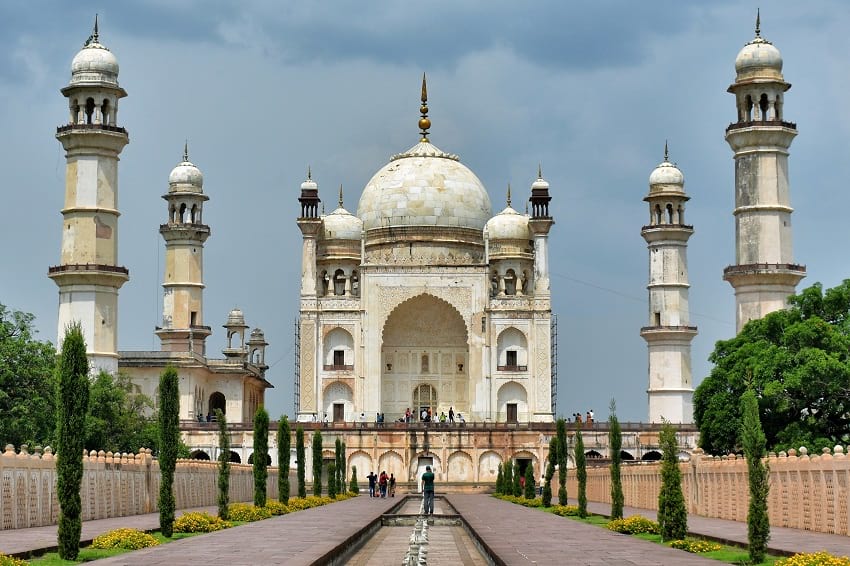
Bibi Ka Maqbara. (Abhideo21 / Wikimedia Commons)
Out of the seven wonders of the modern world, India proudly hosts and boasts of the Taj Mahal in the city of Agra. But did you know that there is another lesser-known monument in the country that is a spitting image of the world-famous Taj Mahal? The Bibi Ka Maqbara in Aurangabad bears a striking resemblance to the original ‘love memorial’ as far as its external appearance goes. Not only that, it also has a similar back story, involving a grief-stricken Mughal emperor and his deceased wife at the centre, which has now become a part of all the tales that tour guides narrate on a visit to this place.
Location of Bibi ka Maqbara
Bibi ka Maqbara is situated in Begumpura, just eight kilometres away from the culturally rich and historically important city of Aurangabad in Western Maharashtra. The magnificent doppelganger of the Taj Mahal in all its glory stands testimony to the fact that architecture played a vital role during the Mughal era. Although the city of Aurangabad is more famously known for its 2nd century BCE caves of Ajanta and Ellora, it is also slowly gaining more prominence as a tourist hub, owing to this 16th century Bibi ka Maqbara. Vacationers from all over the world gather at Begumpura to see this glorious memorial, which is also called the Taj Mahal of the Deccan.
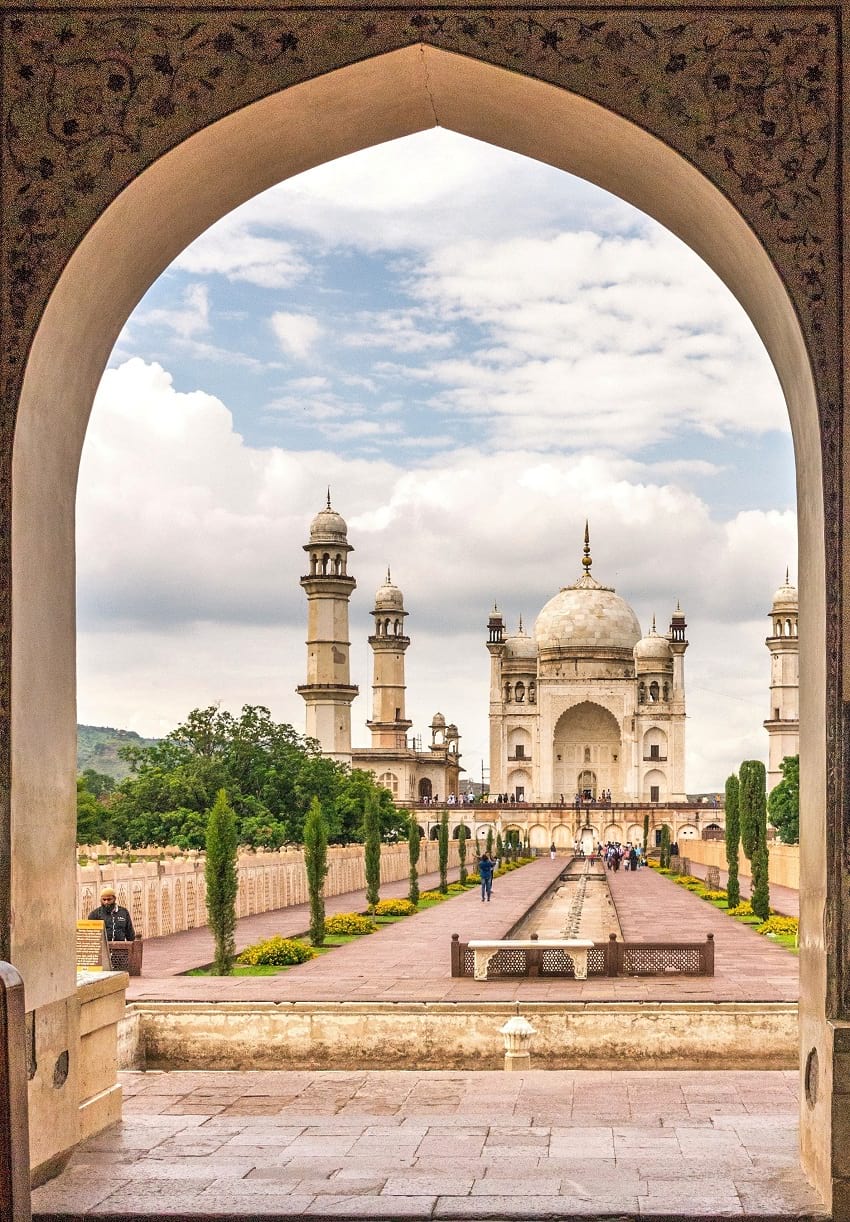
Bibi Ka Maqbara Is also called the Dakkhani Taj due to its strong resemblance with Taj Mahal. (Ruqayya noorin / Wikimedia Commons)
History associated with Bibi ka Maqbara
Bibi ka Maqbara, which literally translates to ‘Tomb of the Lady’, was commissioned by the last effective Mughal ruler Aurangzeb in the year 1660. It was erected in fond memory of his first wife Dilras Banu Begum. Princess Dilras Banu was the daughter of Persian Safavid dynasty prince Mirza Badi-uz-Zaman Safavi, who was later named the viceroy of Gujarat. Dilras Banu married Mughal prince Mahi-ud-din, who upon his ascension to the throne became known as Emperor Aurangzeb. Their matrimonial union took place in the year 1637 on May 8, amid much fanfare and grand celebrations in Agra at the residence of Mirza Badi-uz-Zaman Safavi, also titled Shah Nawaz Khan. After the couple’s time in Agra, the imperials returned to Aurangabad in Deccan, where Dilras Banu, who had now become the chief consort of the emperor, bore him five children – three girls and two boys – after almost four-year-gap periods.
Princess Zeb-un-Nissa was the eldest royal daughter, followed by Princess Zinat-un-Nissa and later Princess Zubdat-un-Nissa. Two princes Muhammad Azam Shah and Sultan Muhammad Akbar were born later after the royal daughters. Since these five children were the issues of his first and most beloved wife Empress Dilras Banu, Aurangzeb favoured them more over his other children from other wives. However, on September 11, 1657, after delivering their last son Sultan Muhammad Akbar, Dilras Banu Begum developed infections, from which she never recovered. A month later, on October 8, she died due to the postpartum fever developed during the complicated childbirth. Shortly afterwards, the eldest daughter Princess Zeb-un-Nissa was given the responsibility of looking after the neonate.

Inside Bibi Ka Maqbara. (Dr Murali Mohan Gurram / Wikimedia Commons)
With the sudden demise of his favorite wife at just 35 years of age, the bereaved Aurangzeb set a chain reaction of grief in the family, greatly affecting the elder son Muhammad Azam Shah the most. Three years after Queen Dilras Banu’s demise, in the year 1660 Aurangzeb commissioned the construction of a burial chamber, which would be the final resting place of his wife. Although Aurangzeb is never credited with having built grand structures during his long reign, he made an exception and followed in the footsteps of his father Shah Jahan. In memory of Empress Dilras Banu Begum, who was posthumously given the title Rabia-ud-Daurani, Aurangzeb ordered a mausoleum to be built in Aurangabad, the city named after him. The memorial came to be known as Bibi ka Maqbara, which became the largest monument that Aurangzeb had ever built.
Specifications of Bibi Ka Maqbara
The work on the edifice started in the year 1661 and carried on until 1669, bearing a striking similarity to the famous Taj Mahal, built during Shah Jahan’s reign. Aurangzeb’s mother Empress Mumtaz Mahal had also died during childbirth, much like his wife Dilras Banu; so his father Shah Jahan had built the Taj Mahal as an ode to their love, as Mumtaz’s final resting place. Hoping to rival the Taj, Aurangzeb ordered work on Bibi ka Maqbara to begin just like its more famous and larger, original structure. Attaullah Rashidi, the son of Ustad Ahmad Lahori, the chief designer of the Taj Mahal was hired to work on Bibi ka Maqbara, while Hanspat Rai was the principal engineer, assisting Attaullah in the construction work.
One third in size as compared to the Taj Mahal, Bibi ka Maqbara cost the royal family approximately six hundred and seventy thousand rupees, with necessary construction material coming in from all parts of the country. French jewel merchant and traveler Jean-Baptiste Tavernier during his travels to India, mentioned extensively in his journals about his first-hand account of the material imported for constructing the maqbara. Marble for the monument came in from the mines of Rajasthan, while loads of basaltic rock, sand, limestone and cement (for stucco decorations) were also ordered for its construction.
Built as per the Islamic style of architecture, the construction of Bibi ka Maqbara is based on the Quranic mentions of the four gardens of Paradise. Known as charbagh, the main mausoleum stands at its centre within an area of fifteen thousand square feet in total. The centrally enclosed edifice measures approximately 458 m by 275 m, flanked by axial ponds on its sides. Like the original structure, the Deccani copy is built on a high, square podium, with four minarets on all the four corners surrounding the dome. The main structure can be reached by a flight of steps on three sides just like the Taj.
While Taj Mahal is completely made out of pure white marble, the Taj of the South only has its dome and dado-level walls covered in marble. The rest of the structure above has a fine plaster polish to give it a marble-like appearance. Bibi ka Maqbara, though is not as magnificent as the Taj Mahal, it still is an exquisite piece of Mughal architecture, with a hint of Deccani architecture into its construction. Paler in comparison, Bibi ka Maqbara is almost similar to its forbearer except for one major difference. While the four minarets of the Taj Mahal are shorter than the onion dome, the approximately 72 feet high minarets of Bibi ka Maqbara are taller than the main central dome.
The entire hexagonal complex has its outside walls with arched recesses and bastions, fashioned as per the refined Mughal architecture. The marble on the tomb has intricate lattice screens, while geometric patterns adorn the dome’s canopy on the inside. Floral motifs beautify the interior walls of the structure and foliage designs embellish the exterior part. Finely done brass doors serve as the gateways to the inside of the structure. The entrance is followed by a series of fountains and water channels that are placed alongside the twelve-doored pavilions or baarah daaris.

The interior design inside the tomb. (Abhideo21 / Wikimedia Commons)
Tomb of Queen Dilras Banu Begum
The mortal remains of the late empress of Aurangabad are placed in a grave below the ground level. It is a low-barricaded, simple, octagonal structure, which is enclosed in elaborately designed marble screens on all sides. Stucco paintings and inscriptional Arabic patterns decorate the surrounding of the cenotaph. The underground grave of the empress is covered with a silk cloth, which is open for the tourists to see during visiting hours at Bibi ka Maqbara.

Tomb of Dilras Banu Begum. (Abhideo21 / Wikimedia Commons)
Controversy over ownership of Bibi ka Maqbara
Although the board at the entrance of Bibi ka Maqbara today credits Aurangzeb’s son Muhammad Azam Shah as the builder of the edifice, it was actually Aurangzeb’s original idea. Muhammad Azam Shah would only have been eight years of age when work on the structure began, possibly not sure what all of it actually meant. Azam Shah was only put in charge of overseeing the construction of the monument and its repair work on his father’s instructions later on in his life. While the war for the ascension to the throne of Agra was on between the sons of Shah Jahan (with Aurangzeb winning it), Aurangzeb was mostly away from his seat in the Deccan, leaving the construction work to Azam Shah only for namesake.
Bibi ka Maqbara might not be a world-renowned mausoleum, or might be called the ‘poor man’s Taj’ or even a cheap copy of the monument dedicated to love, but the towering structure in Aurangabad, erected in memory of Aurangzeb’s wife, continues to carry forward a legacy that is left behind by the Mughals in the southern part of the country.
Enjoyed this article? Also, check out “The Mahabat Maqbara and the Extraordinary Tomb of Bahar-ud-din Bhar“.
Fact Analysis:
STSTW Media strives to deliver accurate information through careful research. However, things can go wrong. If you find the above article inaccurate or biased, please let us know at [email protected].
RELATED
The post Bibi ka Maqbara: The Taj of Deccan, Which Like the Original, Tells the Tale of Eternal Love appeared first on .
]]>The post Jim Corbett: A White Hunter Who Became Saviour of Tigers appeared first on .
]]>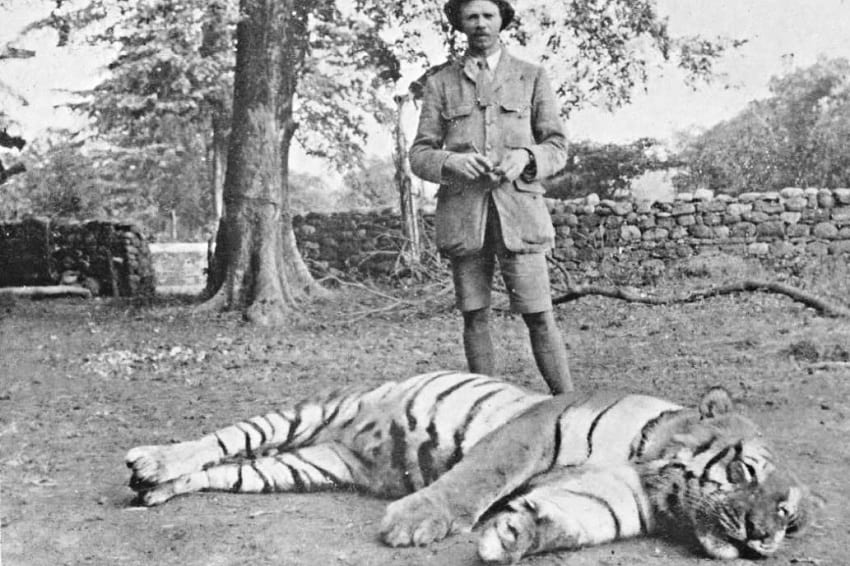
Jim Corbett with the freshly killed Tiger of Powalgarh. (Wikimedia Commons)
How many hats can a man wear in a lifetime? A railway employee, a contractor, a hunter, conservationist, family man, author, a celebrity, philanthropist, army officer, photographer. Jim Corbett, the British naturalist, born in colonial India as Edward James Corbett, wore all these hats. Tiger reserve of India, Jim Corbett National park, is a living testimony to this iconic Anglo Indian.
Jim Corbett’s father served at Dehradun and Nainital
Jim Corbett was born on 25th July 1875, at Nainital, in the Kumaon of Himalaya (present Uttarakhand). He was the 8th child of William Christopher Corbett and Mary Jane Corbett (2nd wife). William had married Ann Morrow while serving as Captain in the British army, at Dehradun in 1845. Ann died 2 years later, after giving birth to 3 children. In 1859 William left army service and became a postmaster in Nainital. There he met Mary Jane, a widow with 3 children, and married her. The newlyweds then had 6 children to look after and would be blessed with 8 more in the future.
In 1862, William shifted to Nainital. His sister and her husband died, leaving behind 8 children, of which, 4 would live with the Corbett family. On 21st April 1881, William died of a heart attack, leaving Mary Jane with the charge of 9 children, including the 6-year-old Jim.
Jim left studies to support his large family
Born and brought up in a big joint family, bonhomie and camaraderie came easy to Corbett. He had his schooling at Oak Openings School (now Birla Vidya Mandir, Nainital) but left studies at 18 to shoulder the family responsibilities. In 1892, he obtained a temporary job with the Bengal and North Western Railway as a fuel inspector at Manakpur, Punjab. Later, he became a trans-shipment contractor at Mokameh Ghat in Bihar, overseeing the movement of goods across the Ganges. His dedication to the welfare of his family would keep him from starting one himself, and he remained a bachelor all his life. His elder sister, who too didn’t marry, remained his companion and soulmate.
Served in the army during the world war 1
During the world war 1 he joined the army and commanded a unit of 500 men (Kumaon Labor Corps) in France. Promoted to the rank of major, he commanded the 114th Labour Battalion, in the third Afghan war (1919). For 16 years, from 1920 to 1936, he spent quality time, hunting and tracking in Tanganyika (present-day Tanzania), Africa. By 1930 he grew weary of hunting and found a better calling: shooting animals with 16 mm camera. Photography gave him greater joy than shooting with a firearm. He gave up hunting and took up the cause of conservation of wildlife.
Taking on man-eating tigers became his prime call
The defining part of Corbett’s career as a hunter, began with a Bengal tigress, in 1907. Killing it established his image as a devious hunter, and at the same time kindled in him an appreciation for wildlife. For, he realized that tigers turned man-eater when incapacitated due to injury or old age. The feline had lost two canine teeth to a bullet that failed to kill her. Unable to catch on her natural prey base, the big cat turned to an easier option – killing humans for food. Champawat had claimed 436 human lives and was a reigning terror in Kumaon area in 19th century India. Attempts at containing the cat had failed, and a jittery British government commissioned Jim Corbett into the task. Following a tip-off, he reached the village Champawat and saw remains of a woman victim. A human chain was formed to force the animal to move into anambush. A trap was laid and the tigress was shot down in a daredevil encounter. That was the end of the tigress, posthumously named as the Champawat man-eater.

Jim Corbett with the Leopard of Rudraprayag. (Wikimedia Commons)
Another credit for Jim was Panar Leopard (1910) that killed about 400 people. Jim’s first attempt was an anticipated shot in the dark. The hit animal was tracked in the wood with searchlights and killed in the second attempt.
Talla-Des man-eater that claimed 150 human lives in a span of 2 years, was exterminated it in 1929. Her two grown-up cubs were also killed. The man-eater was spotted through a blood trail leading to a thicket of ferns. Two rounds of bullets fire killed the animal on spot.
Jim Corbett narrates in his book The Jim Corbett Omnibus:
“When I saw the two tigers lying asleep I concluded that the man-eater had found a mate, but later, when my third shot flushed a third tiger, I knew I was dealing with a tigress and her two cubs. Which of the three was the mother and which the cubs it was not possible to say, for all three looked about the same size when I had viewed them over the sights of my rifle….The cubs had died for the sins of their mother.”
Man-eating leopard of Rudraprayag had killed 125 villagers. Leaving human bodies unburied in epidemics had (including Panar leopard) hooked it to the human flesh. Jim eliminated it in the year 1925.
Mohan man-eater, a terror in settlements of Kosi valley was killed in 1929. The tiger was sleeping. For once Jim reflected on ethics of gaming a sleeping life. But the fact of its being a man-eater prevailed.
A group of 3 man-eaters from Kumaon division, reported in 1929, was the next pick. The hunt led to Chowgarh Tigress and her grown-up cub, responsible for 64 killings. Jim began his hunt from Kala Agar forest. In his first attempt, the cub got killed. The thread of the mission was picked up in February 1930. Buffaloes, used as bait attracted 2 tigers and 2 leopards which were not man-eaters but got killed under that impression. The dogged search for the man-eater concluded on 11th April 1930. Jim suddenly found himself dangerously close to the man-eater. The tigress, just 8 feet away, could pounce on him any second. Jim gathered his wits and shot the animal dead. By any reckoning, it was the toughest challenge he faced in his lifetime.
Chukka man-eater was a male Bengal tiger that killed 3 boys of village Thuk in Ladhya Valley in 1937. After repeated attempts, it came under the firing range of Jim, perched on a tree at a strategic location. Two bullets were fired and the animal fell lifeless. This was 2nd last in Corbett’s man-eater kitty. The last one was the Thak man-eater, a Bengal tigress that killed 4 humans in 1938. It fell to Jim’s on 30th November 1938.
His experience as a hunter made him a lover of wildlife
Increasing empathy towards the wild during his hunting days made Corbett a staunch conservationist and he took up the cause of protecting wildlife from human interference. He worked tirelessly to establish Hailey National Park in 1936. The park, a beacon light of conserving forests and the wildlife, was later renamed Ramganga National Park and finally, after his name, as Jim Corbett National Park in 1957. Jim Corbett authored 6 books penning his life experiences and conveying his message of living in harmony with nature.
Jim Corbett National park
Located in scenic surroundings of Himalayan foothills and the Shivaliks, Jim Corbett National Park is a popular tourist destination in India. Spread in an area of 520 square kilometres at Nainital, Uttarakhand, it is home to a wide spectrum of wildlife. Project Tiger, launched in 1973 for the protection of the endangered species of Asian tiger, began from here. It is home to 650 species of birds and 5 species of deer. A good number of otters, crocodiles, elephants, pigs, tigers, leopards, bears and reindeer etc. make it a vibrant exposition of wildlife in its natural surroundings. Visitors to the park, go in a jeep/canter safari to see the wild in its pristine form.
Two houses of the Corbett family are tourist attractions
The winter house of the Corbett family was located in Kaladhungi, a forest area in the Himalayan foothills, popularly called Corbett’s village. The house was converted into a museum in 1967. Another house of Corbett’s, on the slopes of Ayarpatta hill in Nainital, named Gurney house is now owned by Varma-Dalmia family. Visitors to the national park, however, allowed to see this heritage home.
Criticism and controversies
In 1947, Jim Corbett, along with his elder sister, left India for Kenya, where he died at the age of 80. Corbett’s illustrious career has its own share of criticism. Some scholars feel he was just an extension of India’s colonial masters who raised hunting as a popular sport. This led to hunting on a wider scale. A large number of tigers survived a shoddy hunt, to live with injury and incapacitation. Such injured felines, they aver, turned on human beings. And, Jim was strategically positioned as the saviour of the forest dwellers. His positioning as a friend of villagers won the British government the goodwill of the local population. Those were the days of India’s freedom struggle when the colonial rulers were generally doubted by the Indians. Some have accused Jim of exaggeration in his writings. Another criticism is in respect of an Indochinese subspecies of tiger, panther tigris corbetti. The name, it is argued, is not after Jim Corbett as claimed by many. Actually, it is after a Researcher of Natural History, Gordon Barclay Corbet (Jim Corbett has ‘tt’). Jim has also been accused of killing many felines which were not man-eaters, and killing just for sport.
Overall, a perfect gentleman
Nevertheless, his image as one who saved men from tigers, and subsequently tigers from men, survives controversies. Villagers loved him and admired him in spite of being a white man. He is still fondly and reverentially remembered by the inhabitants of the places where he lived and worked. This, coupled with the body of work he gifted to the posterity, will keep Jim Corbett immortal in the annals of history.
Enjoyed this article? Also, check out “Tsavo Man-Eaters: A Pair of Rogue Lions That Killed Nearly 135 People“.
Fact Analysis:
STSTW Media strives to deliver accurate information through careful research. However, things can go wrong. If you find the above article inaccurate or biased, please let us know at [email protected].
RELATED
The post Jim Corbett: A White Hunter Who Became Saviour of Tigers appeared first on .
]]>The post The Mahabat Maqbara and the Extraordinary Tomb of Bahar-ud-din Bhar appeared first on .
]]>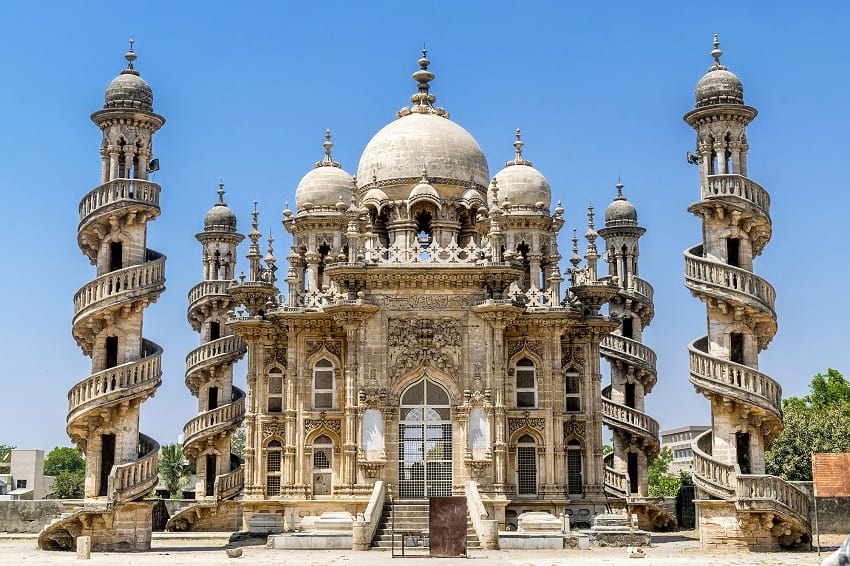
Mahabat Maqbara Mausoleum. (Kshitij Charania / Wikimedia Commons)
If you visit a busy intersection near the Mahatma Gandhi Road in Junagadh, you will come across the eye-catching architectural marvel known as the Mahabat Maqbara. It is a mausoleum of the sixth Nawab of the erstwhile princely state of Junagadh and one of his high-placed courtiers. However, unlike India’s most famous mausoleum, the Taj Mahal, few people in India or abroad have heard of the Mahabat Maqbara. That ought to change.
The Mahabat Maqbara
The Mahabat Maqbara is a mausoleum complex that comprises of two structures—the imposing Mahabat Maqbara, which was built above the tomb of Nawab Mahabat Khan II of Junagadh, who ruled from 1851 to 1882, and the fantastically eccentric tomb of his Wazir, Bahar-ud-din Bhar Hasainbhai.
Nawab Mahabat Khan II began construction the complex in 1878. The building work of the Mahabat Maqbara took 14 years and was completed by the Nawab’s successor, Nawab Bahadur Khanji in 1892. The tomb of Bahar-ud-din Bhar was completed in 1896.

Tomb of Mahabat Khan. (Bernard Gagnon / Wikipedia Commons)
A brief history of Junagadh
To understand how the Mahabat Maqbara came to be built, let us first take a look at the social and political background of Junagadh. For centuries, the region was under the rule of various medieval dynasties. It became an independent kingdom in 1748, after Mohammad Sher Khan Babi, a Pashtun adventurer from Afghanistan, decided he didn’t want to be a Mughal vassal any longer. He threw over his allegiance to the Mughal governor of the Gujarat subah and declared himself as the ruler of Junagadh. He began ruling over the newly-found kingdom as Nawab Muhammad Bahadur Khanji.
It was the beginning of the Babi Dynasty that ruled over Junagadh until the independence of India in 1947.
In 1807, during the reign of the third Nawab of Junagadh, Nawab Muhammad Hamid Khanji, who ruled from 2 Dec 1774 to 26 Feb 1811, the state became a British Protectorate. After the fourth Nawab of Junagadh, Nawab Muhammad Bahadur Khanji II, began ruling the kingdom, the East India Company arrived at the city gates and took control in 1818.
However, they did not take over the direct administration of the state or of the other princely states in the Saurashtra region of Gujarat but were content to let the Nawabs remain on the throne and rule on their behalf. The subsequent Nawabs of Junagadh became dyed-in-the-wool Anglophiles, adopted European mannerisms, and attempted to incorporate European architecture in the buildings they built.
After the partition of India in 1947, the princely states in the subcontinent were asked to join either India or Pakistan. The 10th and very popular Nawab of Junagadh, Nawab Muhammad Mahabat Khanji III Rasul Khanji, was holidaying in Europe at the time of independence, leaving his Diwan, Shah Nawaz Bhutto, to rule in his absence. Shah Nawaz Bhutto—father of Zulfiqar Ali Bhutto and grandfather of Benazir Bhutto, both of whom served as prime ministers of Pakistan—was inclined towards Mohammad Ali Jinnah, and, on his return from Europe, persuaded the Nawab to accede to Pakistan.

From left-right: Mohammad Rasul Khanji, Nawab of Junagadh (r. 1892-1911), and Bahaduddinbhai Hasainbhai, Wazier. (F. Nelson / British Library)
The Nawab sent an emissary to meet Jinnah on 11 August 1947 and announced the accession on 15 September 1947. The Indian side took exception and pointed out that the state had no common boundary with Pakistan. To this, the Nawab replied that there was a sea route to Pakistan. Unfortunately for him, the predominantly Hindu population of Junagadh also took exception to join Pakistan and revolted. They insisted on holding a plebiscite, and the results showed that the majority of the citizens wanted to join India.
When the Nawab of Junagadh refused and used military force to prevent his vassal principalities, Babariawad and Mangrol, from acceding to India, Sardar Vallabhbhai, the new Deputy Prime Minister of India, sent the Indian Army to seize the territories. The Nawab and his Diwan fled to Pakistan, and Junagadh became part of India.
The architectural specialities of the Mahabat Maqbara
Islamic and European influences shaped the outlook of the Nawabs of Junagadh, and nowhere is this more evident than in the architecture of the Mahabat Maqbara.
While the external and internal structures of the Mahabat Maqbara are clearly Islamic, they are also replete with distinctive Gothic architectural flourishes. Nawab Mahabat Khan II was an admirer of European architecture and the Gothic style was in vogue in Europe when he began building the Mahabat Maqbara. Since he wanted the buildings to exceed the best in Europe, he insisted on a blend of Islamic and Gothic architectural styles.

Front view of Mahabat Maqbara. (Gsuruchi06 / Wikimedia Commons)
The result is quite astounding and awe-inspiring. Even though it is located on a busy intersection, the Mahabat Maqbara complex manages to stand out and make a powerful statement of eccentricity. Both the structures of the Mahabat Maqbara have stately onion domes and attractive silver doors and windows.
The tomb of Nawab Mahabat Khan II has a large onion dome at the top and is surrounded by a cluster of smaller onion domes. There are elaborate carvings on its outer facade as well as on its interior. There are decorative arches and Gothic columns and windows in the French style.
Wazir Bahar-ud-din Bhar Hasainbhai’s tomb has three large onion domes and exterior decorative flourishes. A short flight of steps leads up to a large, Islamic-style door. The structure is surrounded by four minarets, and each of these minarets is encircled from top to bottom with winding staircases on the outside. These add to the unique architectural features of the Mahabat Maqbara complex and are probably the only minars in the country with external stairways. Most minars in India—such as the Qutub Minar—have stairs on the inside.
The current state of the Mahabat Maqbara
After Junagadh became an Indian state, the Mahabat Maqbara and many other heritage buildings came under the purview of the Archaeological Survey of India. It is, therefore, an officially protected building.

A sign by the Archaeological Survey of India. (Subham Chaurasia 1998 / Wikimedia Commons)
Unfortunately, however, the Indian authorities have not been doing enough to actively protect and maintain the Mahabat Maqbara. The complex is, at present, in a sad state of neglect, with grass and plants growing on the structures. Some sections of the buildings are crumbling away, and others are held together tenuously with rusted wires. The window glasses are broken, and birds have nested inside, and the floodlights outside are damaged.
It is possible to go inside and get an idea of the former grandeur. Hopefully, the Indian government and the Archaeological Survey of India will step up to save, renovate, and restore this architecturally unique monument before it is too late.
Enjoyed this article? Also, check out “Tomb of Bibi Jawindi“.
Fact Analysis:
STSTW Media strives to deliver accurate information through careful research. However, things can go wrong. If you find the above article inaccurate or biased, please let us know at [email protected].
RELATED
The post The Mahabat Maqbara and the Extraordinary Tomb of Bahar-ud-din Bhar appeared first on .
]]>The post Karni Mata Temple: Where Thousands of ‘Immortal’ Rodents Roam Free to Bless Visitors with Good Luck appeared first on .
]]>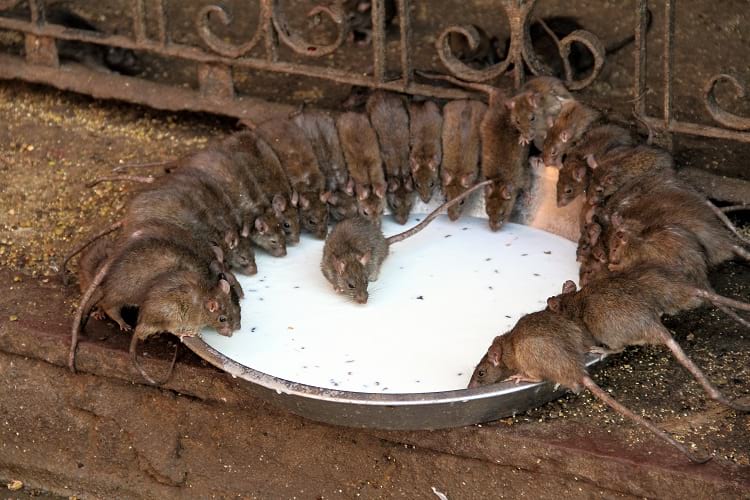
Rats drinking milk at Karni Mata Temple. (Bhups77 / Wikimedia Commons)
Located in Deshnoke, Rajasthan, around 30 km from the city Bikaner, is the extraordinary Shri Manshapurna Temple, commonly known as the Karni Mata Temple. This temple is also famously known as the ‘Temple of Rats’. It is a Hindu temple dedicated to the Hindu goddess Karni Mata who is an incarnation of the Goddess Durga. The Karni Mata Temple houses thousands of rats, and pilgrims from all over the country visit Deshnoke to worship these rodents with exceptionally long tails. These ‘holy’ rats are also known as ‘kabbas’, and aside from pilgrims, this temple also attracts many curious tourists from all over the world.
The legend of Karni Mata
During the 14th century Karni Mata, who was a part of the indigenous Charin clan, lived and performed many miracles during her lifetime. It is believed that she lived till she was 150 years old, and locals believe after her death she metamorphosed into a rat. According to legend, Laxman, the son of Karni Mata, drowned while he was trying to drink water from the Kapil Sarovar in Kolayat Tehsil. Karni Mata implored Yama, the God of Death to bring him back to life. He refused initially, but later relented and said that Karni Mata, being an incarnation of Durga, could restore his life. She did this and also decreed that members of her family would not die. Instead, their dynasty would be reincarnated as rats. Thus, the entire Charin clan believes that when they die, they will be reborn as rats.
The rats inhabiting the Karni Mata temple are revered by the followers of Charin and are believed to be the descendants of Karni Mata and her dynasty. High honour and good karma is said to be bestowed upon those who eat the food that has been gnawed at by the holy rats. If any of the rats are killed, they are immediately replaced by another one made up of solid silver or solid gold.

A man picking prasāda (a religious offering to the deities which is consumed by the worshippers) from a utensil while the rats feed on them. (Schwiki / Wikimedia Commons)
The temple of rats: An architectural marvel
The Karni Mata Temple was completed in the early 20th century by Maharaja Ganga Singh of Bikaner, and is influenced by the Mughal style of architecture. The Temple has solid silver doors and a beautiful facade made of marble to the front of the temple. The temple is also adorned with marble carvings that add to the charm of the structure. The solid silver doors inside the temple were donated by Maharaja Gaj Singh after he visited this magnificent temple he had himself sanctioned.

The entrance of Karni Mata Temple. (Jean-Pierre Dalbéra / Flickr)

Inside the temple. (Jean-Pierre Dalbéra / Flickr)
Across the doorway, there are more silver doors that have panels which depict several legends about the legendary Karni Mata. The image of the goddess is housed within the inner sanctum, along with holy items placed at her feet. There is a 75 cm tall image holding a trident (Trishul) in one of her hands and is surrounded by rats.

The statue of Karni Mata inside the temple. (Jean-Pierre Dalbéra / Flickr)
Her image also has a crown on her head and a garland of flowers around her neck. On either side, images of her sisters are also placed. The temple was beautified further in 1999, under the patronage of Kundanlal Verma who was a part of the Karni Jewellers based in Hyderabad.
White rats: The holiest of the holy rats
Among the many thousands of rats within the temple, there are a few white rats that are considered to be especially auspicious. These white rats are believed to be manifestations of the goddess Karni Mata herself and her sons. The sighting of these white rats is considered to be a special blessing. Visitors compete amongst themselves to try and lure these rodents out of their burrows by offering them food and sweets.
Karni Mata Temple: Daily administration and the bi-annual fair
The Karni Mata Temple is opened up to the pilgrims and tourists in the early hours of the day, around 4 o’clock in the morning. The priests of the temple perform ‘Mangla-Ki-Aarti’ and offer special food known as ‘bhog’ during worship. The devotees that come to the temple make offerings to the holy rats that roam around all over the premises.
Two types of offerings are made, known as ‘dwar bhent’ and ‘kalash bhent’. ‘Dwar bhent’ is an offering that is made to the priests and the workers of the temple. The ‘kalash bhent’, on the other hand, is an offering that is reserved for the maintenance of the temple and its development.
The Karni Mata Fair is held twice a year at the temple and is a major event. The first fair of the year is the larger one and takes place from March to April, i.e., from ‘Chaitra Shukla Ekam’ to ‘Chaitra Shukla Dashmi’.
The second fair of the year in Deshnoke is held in September – October, that is, between the ‘Ashvin Shukla’ to ‘Ashvin Shukla Dashmi’. This time of the year is known as Navratri and is auspicious in the Hindu calendar. Thousands of people travel to the Karni Mata Temple by foot during this season.

Reliefs found on the facade of the temple. (Jean-Pierre Dalbéra / Flickr)
Fascinating facts about the Karni Mata Temple
It is believed that even during the worst of the plague outbreaks, the town of Deshnoke which houses the Karni Mata Temple, is not affected. In fact, several pilgrims that travel to the temple not only go to worship the rodent inhabitants but also to heal their ailments. Devotees believe that these holy rats are endowed with healing powers. Legend claims that the rats living in the temple are immortal and never leave the temple premises. Another strange belief – devotees actually claim that it brings good luck if one of the rats of the temple runs across their feet.
The deteriorating health of rats
While devotees routinely partake on food tasted by the rats, which are deemed holy, there have never been reports of visitors falling sick. On the other hand, news of the rats themselves having health issues is not unheard of. The rats are regularly with way too much human food, including milk and sweets, for their own good. The highly sugary food and drinks have led to the rats ending up with stomach ailments and diabetes. The cumulative effects of these issues eventually leads to a major epidemic among the rats every few years, thus resulting in a horrific number of dead rodents lying around the temple complex. The lowered population of the holy rats of Karni Mata Temple, however, do not stay that way for too long, with the rats multiplying exponentially to reach the original population in no time.
Tourism industry around the Karni Mata Temple
Rajasthan is home to several tourist attractions- populated with renowned heritage forts, several exquisite temples, and offering exotic experiences like camel rides. The Karni Mata Temple holds its own as a marvellous structure with a rich cultural heritage, amidst the overwhelming atmosphere and exotic idiosyncrasies that is characteristic of India.
The best time to visit the Karni Mata Temple is said to be in the March-April or September-October phases when the fairs and festivities are at their best. However, devotees visit the temple throughout the year in order to seek blessings of the goddess and offer ‘bhog’. Tourists, both from around the country and international, come to visit the temple out of curiosity for the strange USP of the Temple of Rats.
Enjoyed this article? Also, check out “The Padmanabhaswamy Temple: The Richest Temple in the World with Gold Worth $22 Billion in Six Vaults“.
Fact Analysis:
STSTW Media strives to deliver accurate information through careful research. However, things can go wrong. If you find the above article inaccurate or biased, please let us know at [email protected].
 Recommended Read:
Recommended Read:
Guns and Glories: Rajputana Chronicles | By Pratap Singh Mehta
Genre:
Non-fiction > History & Politics
RELATED
The post Karni Mata Temple: Where Thousands of ‘Immortal’ Rodents Roam Free to Bless Visitors with Good Luck appeared first on .
]]>The post Iftikhar Ali Khan Pataudi – The Only Cricketer Who Played for Both England and India appeared first on .
]]>
Iftikhar Ali Khan Pataudi. (Wikimedia Commons)
Much is written about Mansoor Ali Khan Pataudi’s cricketing exploits, but not much is spoken of on his father Mohammad Iftikhar Ali Khan Siddiqui Pataudi. Iftikhar was one of the most talented batsmen who played cricket during the 1930s and 40s with much passion at all levels in England. Much later, he played Test cricket in India.
Sadly, the present generation has hardly heard about Iftikhar, the 8th Nawab of Pataudi. For those who don’t know him, Iftikhar happens to be the grandfather of Hindi film actor Saif Ali Khan, the 10th Nawab of Pataudi.
Iftikhar or the Nawab of Pataudi Sr. was the only Indian cricketer to have ever represented England and later British India in Test cricket during his short Test cricketing stint.
Before Iftikhar’s era
During and before Iftikhar’s era, cricket was the game of the royal families in England and British India. Kings, their princes and other elite people in England and British India used to spend their free time playing the game.
There were a couple of other Indian royals who had represented England in Test cricket before Iftikhar. They were the Jam Saheb of Nawanagar, KS Ranjitsinhji and his nephew KS Duleepsinhji. The first-class cricket tournaments in India, i.e. the Ranji Trophy and the Duleep Trophy, were named in the honour of the two.
Ranjitsinhji represented England in Test cricket
Ranjitsinhji represented England in Test cricket against Australia and played in first-class county cricket during the 1880s and 1890s. Ranjitsinhji never played Test cricket for India. Iftikhar was perhaps the first the only prince to have ever represented both England and India in Test cricket at different times.
Even as Iftikhar was busy playing first-class and Test cricket in England, his contemporary in India was another royal. He was the accidental player Lt. Col. Sir Pusapati Vijay Ananda Gajapathi Raju, the Maharajkumar of Vizianagram or simply Vizzy. Vizzy was a politician first, not-so-sought-after cricketer and a cricket administrator.
Iftikhar was born on May 16, 1910, in Pataudi, Punjab, British India. The Nawab, sometimes also known as IAK Pataudi, was the 8th Nawab of Pataudi. Today, however, the erstwhile and small princely state of Pataudi lies in the present-day state of Haryana.
Iftikhar related to great Urdu poet Mirza Ghalib
Iftikhar was born to Muhammad Ibrahim Ali Khan, the 7th Nawab of Pataudi and Shahar Bano Begum. He was related to well-known historical figures like the greatest Urdu poet Mirza Ghalib and Liaqat Ali Khan, Pakistan’s first prime minister.
During his schooling in India, Iftikhar learnt his basics in cricket from MG Slater, an Oxford University cricketer. Much later and during his early stay in England, Frank Woolley coached the promising lad. In Lahore, Iftikhar went to Chiefs’ College, which was later renamed Aitchison College.
The young Nawab arrived in Britain
In 1926-27, when the young Nawab arrived in Britain for further studies, he joined the Balliol College at Oxford University. While studying at Balliol College, he won the blues in both hockey and cricket for the University.
In 1932, Iftikhar qualified for the Worcestershire team. However, he played just three matches scoring only 65 runs in all the six innings. But in July 1932, he slaughtered Tich Freeman scoring 165 for the Gentlemen at Lord’s. His footwork was superb during the innings.
Iftikhar Ali Khan Pataudi played for England in the now infamous Bodyline series

Photograph of England cricket team 1932–33 where Iftikhar Ali Khan Pataudi can be seen in the back row, third person from the left. (Sydney Mail Special Photographer)
Following which, he bagged a place in the England Test team for the now infamous Bodyline 1932–33 Ashes series Down Under. The same year, Iftikhar was named the Wisden Cricketer of the Year. On his Test debut in Sydney, Iftikhar smashed a century (102) helping England win the Test by 10 wickets.
However, Iftikhar rubbed his captain Douglas Jardine on the wrong side by objecting to the bodyline tactics of Jardine and refused to move to his place in the leg-side field. Seeing this, Jardine is believed to have said His Highness is a conscientious objector.
The clash between Iftikhar and Jardine

Douglas Jardine. (Wikimedia Commons)
A peeved Jardine dropped the Nawab of Pataudi Sr. after the second Test in Melbourne on the pretext that he scored 15 and 5. Iftikhar never played in that series again. Some time by the end of the Bodyline tour, Iftikhar said of Jardine, “I am told he has his good points. In three months I have yet to see them.”
The year 1933 can be considered as the year of Iftikhar as it was the only full season of county cricket for him. In that year, batting spectacularly, Iftikhar plundered Tich Freeman at Worcester and smashed his way to two 200s. That year, he scored 1,749 runs and his average was 49.
In the same year, Iftikhar’s health broke down. He then managed to play just 10 games and recorded his career best batting average of 91.33.
Last played for England in June 1934
In June of 1934, Iftikhar played his third and last Test for England against Australia at Trent Bridge. As his health was failing him, he scored just 12 and 10 in his last appearance for England.
Between 1035 and 1938, the Nawab of Pataudi Sr. played just five times for Worcestershire.
Interestingly, even as he was playing Test cricket for England, the senior Nawab was being considered to lead India’s team in its first Test match against England at Lord’s in 1932. However, he withdrew his name from such a consideration.
Later in 1936, Iftikhar was in fact appointed the captain of the Indian team that was to tour of England. Sadly though, Iftikhar withdrew at the last moment on health grounds. It was during this period in 1939, that Iftikhar got married to Begum Sajida Sultan, second daughter of Hamidullah Khan, who was the last ruling Nawab of Bhopal.
He captained the India team during the tour to England in 1946
In 1946, however, he at last played for India. He captained the India team during the tour to England that year. On the tour, he scored just 55 runs in 5 Test innings with an average of 46.71.
His captaincy was also slammed. In spite of that in 1946/47, Iftikhar was named the Indian Cricketer of the Year. In 1948, when the princely state of Pataudi merged with independent India, Iftikhar worked with the Indian Foreign Office in Delhi.
Iftikhar died young while playing polo in Delhi
In 1952 Iftikhar planned to return to England county cricket and intended to play for Worcestershire. He, however, couldn’t as he died in Delhi following a heart attack while playing a polo match on January 5 that year. He was 41.
Iftikhar left behind his wife Sajida, three daughters and his son Mansoor Ali Khan, who was celebrating his 11th birthday. Iftikhar’s son, Mansoor, later known as Tiger, succeeded him as the 9th Nawab of Pataudi. Later, Tiger went on to serve Indian Test cricket as a successful captain. Bollywood actors Saif Ali Khan and Soha Ali Khan are Iftikhar’s grandchildren.
He was a hockey Olympian too
While writing in Frontline magazine, sportswriter Vijay Lokapally said Iftikhar was a hockey Olympian too. He then wrote that Tiger Pataudi is said to have missed his father’s guidance throughout his life.
In his racy autobiography titled ‘In Tiger’s Tale’, Tiger Pataudi spoke of his father as a man of very strong principles and a person who was used to having his own way. In addition to being a sportsman, Iftikhar Ali Khan was an accomplished speaker.
MCC commissioned the Pataudi Trophy in 2007
The Marylebone Cricket Club (MCC) is said to have commissioned a trophy in Pataudi’s name in 2007 and England and India were to compete for it in a Test series. This was in commemoration of the 75th anniversary of India’s Test debut.
Remembering Iftikhar in his titled ‘The story of Integration of Indian States’, senior Indian Civil Servant VP Menon said the Nawab was a great patriot who unfortunately died young.
To sum up, Iftikhar Ali Khan Pataudi did play a key role during the formative years of the game in India, i.e. in the 1930s and 1940s.
Enjoyed this article? Also, check out “Hakan Sukur – The Superstar Striker Exiled by Erdogan“.
Fact Analysis:
STSTW Media strives to deliver accurate information through careful research. However, things can go wrong. If you find the above article inaccurate or biased, please let us know at [email protected].
 Recommended Read:
Recommended Read:
Pataudi – Nawab Of Cricket | By Suresh Menon
Genre:
Non-fiction > Biography
RELATED
The post Iftikhar Ali Khan Pataudi – The Only Cricketer Who Played for Both England and India appeared first on .
]]>The post The Lonar Lake: An Astronomical Marvel appeared first on .
]]>
Lonar lake, Maharashtra. (Praxsans / Wikimedia Commons)
Located in Maharashtra’s Buldhana district at Lonar, is a “saline, soda lake”- the Lonar Lake. It is said to have been created during the Pleistocene Epoch due to the impact of a meteor. It happens to be a hypervelocity impact crater, consisting of basaltic rock on Earth. There are three other known basaltic impact structures like the Lonar crater, which may be found in the south of Brazil.
An overview of the Lonar Sarovar Lake
The Lonar Crater is said to be fifty-two thousand years old. It was formed when a meteor weighing at least 2 million tonnes crashed into the earth at an approximate speed of 90,000 kmph. The crater is 1.8 km wide and 150 m deep. The water in the lake is saline, as well as alkaline and is surrounded by hills that have many fascinating temples. Despite the rarity of this lake, very few people have heard of Lonar Lake apart from the locals of the place and some trekkers.
The Lonar Lake contains various sodas and salts. In times of dry weather, evaporation decreases the level of the water and soda is collected in large quantities. There are two small streams, called “Purna” and “Penganga” that drain into the Lonar Lake. A well having fresh water is also located on the southern side, close to the edge of the water.

Satellite photo of Lonar Lake. (NASA)
Home to diverse flora and fauna
The slopes of hills around the Lonar Lake are covered with trees. The savannah-like area houses teak, bastard teak, the Indian screw tree, and the Pala indigo (also known as dyer’s oleander). The surrounding shrub-savannah contains plants like the Egyptian acacia and Ziziphus spp. Along the shore of the lake, the “non-native Prosopis juliflora” can be seen growing. The alluvial terrace in the northeast along the Dhara River is used for agricultural purposes. Some of the main crops that are cultivated are maize, millet, okra banana, and papaya.

Lonar Crater during monsoon. (V4vjk / Wikimedia Commons)
Lonar Lake has two unmistakeably distinct regions that do not mix. The outer neutral region (pH level of 7) and the inner alkaline region (pH level of 11) each have its own flora and fauna. The lake serves as a haven for a diverse range of plant and animal life. Several resident and migratory birds are found on the lake. This includes the black-winged stilts, brahminy ducks, golden oriole, blue jays, red-wattled lapwings, hoopoes, tailorbirds, magpies and swallows among others.
Several reptiles like the monitor lizard, snakes, and scorpions are also found on the lake. The Lonar Lake is also home to several thousands of peafowls, chinkara, gazelles, langur, mongoose, barking deer and many insects and amphibians.
Lonar Lake has non-symbiotic bacteria that help in nitrogen fixation. Studies have shown microbes like Slackia sp., Actinopolyspora sp., Paracoccus sp., Klebsiella sp., and Halomonas sp. live only in alkaline conditions that have a pH level of 11.
Breathtaking sites around Lonar Lake
There are several places around the Lonar Lake that are visited by tourists throughout the year. The Ajanta and Ellora Caves, for instance, are UNESCO World Heritage Sites. Daulatabad, Khuldabad (also known as the Valley of Saints), the very famous Grishneshwar Temple, and the Pitalkhora caves are other famous spots. However, not many people visit the Lake itself, because not many know about its existence. This beautiful lake is a four-hour drive from the city of Aurangabad. The road has picturesque villages and paddy fields that provide a refreshing change from the dull greyness of the city.
The trek to this marvellous lake is a bit tricky owing to the quicksand on the banks, and the path itself is rather slippery. On your way to the lake through the jungle, you may come across various types of minerals. You could stumble upon ruins of temples which are now home to insects and bats. The forest area near the Lonar Lake is a paradise for nature photographers and those who love birds and ardent bird-watchers.

A temple at the banks of Lonar lake. (Rohanguj2 / Wikimedia Commons)
As mentioned earlier, there are a number of temples surrounding the lake, many of which are in ruins now. There is the Shankar Ganesha Temple which has a notable rectangular idol of Shiva. The Ram Gaya Temple and the Kamalja Devi Temple is full of life during Navratri.
There is a myth about the Dhara or Sita Nahani Temple, which is said to be the place where Sita is said to have bathed. There is nothing remarkable about the architecture, but there is a kund inside the temple. Into this, a perennial freshwater spring flows, that feeds the lake below.
The most significant temple is said to be the Daitya Sudan Temple which is dedicated to Lord Vishnu and is located in the town. Lord Vishnu is said to have slain the demon Lonasura who also lent his name to the village. Locals believe that the crater had been the demon’s den and that the lake had murky water which was a result of the spilt blood of the demon. The temple structure itself is said to be a remnant of the Khajuraho style, with erotic sculptures of couples and ferocious ravaging beasts.
A haven in danger
Unfortunately, this astronomical marvel is facing several environmental as well as anthropological problems that threaten its very existence. The lake’s underground water source has been disturbed by illegal excavation activities that are carried out. Tourist activities also cause severe damage to the surrounding land. The perennial streams, “Dhara” and “Sita Nahani”, are one of the sources of water for the lake. However, these streams are also used for bathing, washing cattle and clothes, and for other domestic uses by the local people, pilgrims and the tourists. The household wastes containing detergents are disposed into this lake.
The agricultural fields surrounding the lake use toxic materials like pesticides and fertilizers that pollute the lake water. The ecosystem of the Lonar Lake is getting damaged because of sewage being dumped into the waterbody. Commercial activities around the lake have also harmed the natural topography of the lake. The increasing pollution has greatly distressed the flora and fauna of the Lonar Sarovar.
Enjoyed this article? Also, check out “The Jewel of Manipur: The Loktak Lake is the Only Floating Lake in the World“.
Fact Analysis:
STSTW Media strives to deliver accurate information through careful research. However, things can go wrong. If you find the above article inaccurate or biased, please let us know at [email protected].
RELATED
The post The Lonar Lake: An Astronomical Marvel appeared first on .
]]>The post Adalaj Stepwell: A 500-Year-Old Architectural Masterpiece With a Tragic Tale of Unrequited Love, Sacrifice And Loss appeared first on .
]]>
Adalaj Stepwell. (Henry / Flickr)
A stepwell has always held an important position in the history of Indian architecture, with the semi-arid states of Gujarat and Rajasthan occupying top spots, where one is likely to find these in the vicinity. A stepwell, which is also called a baoli or bawdi in Hindi language, formed an integral part of a city’s foundation, providing year-round access to basic water-related needs for locals in the nearby areas. The city of Ahmedabad in Gujarat is home to a renowned stepwell called Adalaj ni vav or Rudabai vav, which is not only an example of fine architecture but is also an ancient yet functional masterpiece in itself.
Adalaj Stepwell history
Initially known as Rudabai ni vav, the Adalaj stepwell came to be known by its current name owing to the quaint village it is situated in. The village of Adalaj is located approximately 20 kilometres on the outskirts of Ahmedabad in Gujarat, which gave the vav (in Gujarati language it means a well, which is accessed through a flight of stairs) its name. Construction work on the magnificent stepwell began during the late 1490s under the supervision of Rana Veer Singh of the Vaghela dynasty, who ruled over a kingdom in Gujarat called Dandai Desh during those times. His little empire was prone to frequent dry spells and insufficient rainwater was the only way in which Dandai Desh could meet the needs.
Rana Veer Singh ordered that a huge well be constructed on the lands nearby that would end their water-related problems once and for all. And so construction work on Adalaj stepwell began, with skilled masons and artisans employed to finish the job for the king.
No sooner did work start on the stepwell than tragedy struck their realm and a war with their neighbouring province broke out. Rana Veer Singh died in the battle, losing his land to a Muslim ruler – Mahmud Begarha, who later rose to prominence as the Sultan of Gujarat during the fifteenth century. After Rana Veer Singh’s passing, his wife, Queen Rudabai decided to complete the work on the stepwell in the fond memory of her late husband, but Dandai Desh’s and Rudabai’s problems had not ended there.
The tragic story associated with the Adalaj stepwell
Queen Rudabai had wanted to jump into her husband’s funeral pyre and commit Sati, but she held back and decided to finish work on the stepwell herself. When Mahmud Begarha, whose actual name was Abul Fateh Nasiruddin Mahmud Shah I, conquered Dandai Desh, he was totally smitten by the beauty of the queen and proposed marriage to her. Queen Rudabai laid out a condition that she would marry him if he allowed work on the stepwell to finish off first. And so under Rudabai’s supervision and on the orders of Mahmud Begarha, construction work on the Adalaj stepwell began again and was completed in the year 1498. The cost of building the vav was an estimated five hundred thousand rupees of that time.
When Mahmud Begarha reminded the queen of the promise she had made to him, she jumped into the waters of the stepwell thus ending her life. Mahmud Begarha did not want to demolish the architectural marvel that he had helped build and decided to keep it intact. It is believed that the six tombs, which one encounters on their way towards the stepwell, are those of the masons who had toiled hard to build the stepwell during Mahmud Begarha’s reign. Legends also state that the queen can be heard weeping at the base of the stepwell on a full moon night.
Specifications of the Adalaj stepwell
The Adalaj stepwell is a square piece of architecture towards the bottom that transforms into an octagonal structure towards the top. Hewn in sandstone and built in brick and mortar, in the Indo-Islamic style of architecture, a colonnade of pillars support the ornate octagonal edifice that descends five stories deep into the underground from top to bottom. Each floor is spacious enough to house a large group of people together at one time. More than five hundred years ago, women would come to fetch water at the stepwell, chat and catch up on their daily lives, along with travellers and pilgrims, who would find a way to rest overnight at the massive stepwell and pray. It doubled up as a resting and trading place and also served ritualistic and practical purposes. Today, tourists gather at the underground level of the Adalaj stepwell to soak in its beauty and splendour.

Inside Adalaj stepwell. (Nandini / Wikimedia Commons)
There are depictions of the day-to-day lives of people on the walls of the stepwell, along with carvings of Jain and Hindu iconography. Fused together with these on the walls are the floral motifs and geometric patterns from Islamic architecture that adorn the entire structure. The amalgamation of Hindu and Muslim designs together in one structure stems from the fact that Rana Veer Singh began work on the stepwell and Mahmud Begarha completed it; each adding his own cultural touch to it. The balconies of Adalaj ni vav are delicately detailed, the pillars or columns on which the structure rests are intricately designed and niches in walls house Hindu deities, which are aesthetically done, adding to the beauty of the already stunning stepwell.

A decorated stone panel of the stepwell. (Itsmalay~commonswiki / Wikimedia Commons)
The Ami Kumbhor, which is also known as the pot that holds the water of life and the Kalpavriksha or tree of life (two important symbols from Hindu mythology) are the main attractions at the Adalaj ni vav, which have been elaborately carved out of a single slab of sandstone in the wall recesses. A few verses in Sanskrit are inscribed on the walls of the first storey, which narrate the tale of Rudabai’s sacrifice and her love for her husband.
The speciality of Adalaj ni vav
Apart from the many special attributes that the water shrine possesses, Adalaj ni vav has the distinction of being the only stepwell in Gujarat, which has three entrance staircases that lead to a stepped corridor. These three entrances converge in the underground pavilion at the first square-shaped storey, which rests just above the circular water tank. The well is connected to an underground aquifer that yields groundwater to the tank regularly. Cross beams run along the entire length of the corridors and passageways to support the structure above. The roof of the corridors has vents that keep the edifice well-lit and properly aerated. Small rooms at each of the landings have oriel windows for proper ventilation. Direct sunlight does not cast on the stairway landings except for a brief period of time during the noon.

The upper storey of the stepwell. (Koshy Koshy / Flickr)
Built as a site where travellers could seek refuge from the harsh sun, Adalaj ni vav provides just that by blocking out the sunlight for the most part of the day. As one descends into the heart of the earth, the air starts to get cooler and the interiors of the stepwell always remain cool with approximately six degrees lesser than the outside temperature. Even though the spiral staircases are narrow and steep, giving a feeling of being confined in a tight space to some, at no point of time does it become darker inside so as to give rise to a problematic situation.
On the upper floors, scores of carved animals are on display, which forms a part of the Hindu mythology, but none looks similar to the other. The stepwell was carefully built more than five centuries ago, keeping in mind the utility that it would serve over a period of time. The artisans’ hard work, expertise and patience were at play while the Adalaj ni vav was under construction and the tragic tale of sacrifice and endless love associated with the stepwell only goes on to show that the country is replete with such masterpieces that are yet to come out of the dark.
Enjoyed this article? Also, check out “Chand Baori: A Quaint Remnant of the Past“.
Fact Analysis:
STSTW Media strives to deliver accurate information through careful research. However, things can go wrong. If you find the above article inaccurate or biased, please let us know at [email protected].
RELATED
The post Adalaj Stepwell: A 500-Year-Old Architectural Masterpiece With a Tragic Tale of Unrequited Love, Sacrifice And Loss appeared first on .
]]>The post The Jewel of Manipur: The Loktak Lake is the Only Floating Lake in the World appeared first on .
]]>
Loktak Lake in Manipur, India. (Sharada Prasad CS / Flickr)
Situated near Moirang in the state of Manipur, India, Loktak Lake is the largest freshwater lake of North-eastern India. The unique phumdis, a heterogeneous mass of vegetation, soil and organic matter at various stages of decomposition found floating over it, characterises the waterbody. Loktak Lake’s claim to fame is its reputation as the only “floating lake” in the world.
An overview of the Loktak Lake
The Lake is located about an hour’s drive away from the capital city of Manipur, Imphal. The Loktak Lake houses more than 700 species of flora and fauna- aquatic as well as on the ground. Whether it is the diversity of migratory birds, or the unique indigenous animals, the natural wildlife of the region is truly astounding.
Loktak Lake was at first deemed as a Wetland of International Importance by the Ramsar Convention of March 23, 1990. The Montreux Record listed the site as a Ramsar site where changes in ecological character have occurred, are occurring or are likely to occur.
Keibul Lamjao National Park, the only floating national park in the world, is located near the Loktak Lake, which makes this belt even more interesting. The endangered brow-antlered deer of Manipur, known as the Sangai, also resides here. This majestic beast is the official animal of the state, and its hooves are perfect for walking on the native phumdis.
Home to diverse flora and fauna
Loktak Lake is a paradise for birds. Out of the 101 species of birds that are found in Loktak, three are globally threatened. Some of the rare birds found are the Common Pochard (vulnerable), Ferruginous Duck (near threatened), Japanese quail (near threatened), and Manipur Bush Quail (endangered). Also found, are the Northern Pintail, Gadwall, Greylag Goose, Red Collared Dove, Sarus Crane, Great White Pelican, Black Kite, Pied Kingfisher and the Oriental Skylark. Some of the gorgeous fauna inhabiting the region includes the Indian python, sambar, barking deer, rhesus monkey, hoolock gibbon, Indian civet, and Temminck’s golden cat.
An approximate of 1,500 tonnes of fish is sourced from the Lake per year. The State Fishery Department introduced several fingerlings of Indian and exotic major carps. The new varieties of fish introduced in the lake include silver carp and grass carp. Old varieties of local fishes like ngamu, ukabi, ngaril, pangba, tharak, and ngashap which were near decline have also been reintroduced into the system.
The lake has a rich biological diversity that includes more than 200 species of macrophytes that survive in water.
Boosting a growing economy
The Loktak Lake region is a source of exotic beauty that has allowed the local tourism industry to thrive. The role of the Lake goes much beyond this, however, and has an important role to play in other aspects of the economy of Manipur as well. It acts as a source of irrigation, drinking water supply, and also provides water for hydropower generation. The Loktak Lake also sustains the livelihood of the fishermen living in the area.

A fisherman out for a catch at the Loktak Lake. (Sudiptorana / Wikimedia Commons)

View of Loktak Lake and Phumdis. (Sharada Prasad CS / Flickr)
Breathtaking sites around the lake
One of the most exotic experiences in the region would be the early morning boat rides deep into the heart of Loktak Lake. Local long-tailed fishing boats are a popular mode of transport that is often let out for tourism purposes as well. Another interesting occurrence in the region is the peculiar mode of travel that often comes as a surprise to tourists- vehicles accommodating at least 4-5 on top of its roof.
The exquisite floating islands housed within the Loktak Lake are made of decomposed biomass. These islands have small huts with thatched roofing which the fishermen use as their homes on a regular basis. These islands embody the essence of the Loktak Lake region and the lifestyle of the inhabitants, thus making for a popular tourist attraction as well.
A haven in danger
The Loktak Lake, like most of nature’s havens, is now endangered due to pollution, decline in diversity of the fauna, and the thinning of phumdis. There has also been a loss of green cover in the area around the catchment. Deforestation and shifting cultivation has hastened the process of soil erosion, thus leading to the shrinkage of the Lake’s perimeter due to siltation.
The thickness of the phumdis has reduced significantly in the Keibul Lamjao National Park, which threatens the Sangai deer. This also affects the migration of fishes from the Chindwin-Irrawaddy River System of Myanmar. There has been a huge decrease in cultivated plantations, as well as major food plants, resulting in starvation of the endangered Sangai deer. Because of the thinning of the phumdis, the hooves of these deer get stuck in the marsh which often causes them to drown. The production of the edible fruit and rhizome of lotus plants has reduced by a huge margin. There has been a degradation of plants due to water pollution as well. The people whose livelihood depends on the selling of edible lotus plant products have greatly suffered from the sudden decline in their growth.
Despite the many threats that the Loktak Lake is currently facing, the locals still regard it as the crowning “jewel” of Manipur. The locals living in the area not only value the lake, but they also see it as a natural treasure. The lake has been home to them and provided them with their means of livelihood. The tourist attraction also adds to the growing economy of the state. However, much needs to be done in order to protect and preserve the Loktak Lake, as well as the sole floating national park across the world- the Keibul Lamjao National Park. If the pollution around the region is not kept in check, this treasure trove housing hundreds of unique flora and fauna will soon be extinct.
Enjoyed this article? Also, check out “The Lonar Lake: An Astronomical Marvel“.
Recommended Visit:
Keibul Lamjao National Park | Manipur, India
Fact Analysis:
STSTW Media strives to deliver accurate information through careful research. However, things can go wrong. If you find the above article inaccurate or biased, please let us know at [email protected].
RELATED
The post The Jewel of Manipur: The Loktak Lake is the Only Floating Lake in the World appeared first on .
]]>The post The Bengal Famine of 1943: The Man-Made Famine That Killed Around 3 Million Indians appeared first on .
]]>
Bengal famine,1943. (Unknown)
Between 1943 and 1944, while the Second World War was at its peak, a terrible famine ravaged Bengal and several other provinces in British India. The British government’s deliberate policies of ignoring the situation and not providing adequate relief measures exacerbated the situation. Over 3 million people died from starvation, disease, and other causes arising from this largely man-made famine.
The Bengal famine of 1943
A traditionally agrarian nation, India has faced famines throughout its long history. You will find mentions of these in many ancient folktales, epics, and other cultural instances. For the most part, these famines occurred due to natural events—lack of sufficient rainfall, a late Monsoon, pest infestation, and so on. Warfare and epidemics also often contributed to the famines.
Local rulers, however, usually managed to keep things from spiralling out of control. They had famine relief measures in place and these prevented mass starvations and deaths. Farmers could count on the rulers’ support in terms of decreased taxes and seed supplies from the state granaries.
To give an example, during the Mughal era, the Mughal emperors charged a 10-15% tax on the peasants. The grain they took from them was stored in the Mughal granary and, in times of difficulties, the government used this grain to sustain the population. So, if crops failed, the peasants always had a safety net they could depend on.
They lost this safety net after the British seized power from the Mughals. First of all, the British raised the taxation to 50%, and their main concern was with amassing a fortune for themselves. The condition of the peasants or the rest of the population didn’t trouble them too much. When the Bengal famine of 1769-1773 occurred, the government provided no relief at all and stood by as around 10 million people died. In fact, the British then proceeded to only increase the taxation to make up for the revenue lost due to the deaths of the farmers. So, in brief, the survivors were practically punished for surviving and had to work twice as hard to pay the taxes that their dead brethren would have paid.
In 1943, the situation wasn’t vastly different.
India was still a largely agrarian economy with the majority of the population living in rural areas. The province of Bengal, in particular, depended on agriculture, and large tracts of it was under rice cultivation. Rice was the principal crop of Bengal—as a government report on the famine later stated, it was a province of rice growers and rice eaters. The farmers grew three crops of rice per year and the winter crop was usually particularly bountiful.
In 1942, however, the winter crop failed, ravaged by a widespread outbreak of brown spot fungal disease. Plentiful rain that year, accompanied by cyclones and storms, contributed to the spread of the fungus. The crop failure was certainly a principal factor leading to the Bengal famine of 1943.
Additionally, the soil fertility was in decline and contributed to poor crop yields.

Vultures feeding on human remains during the famine. (Wallace / Wikimedia Commons)
Other factors contributing to the Bengal famine of 1943
Apart from natural reasons, let’s look at some of the other factors that led to the famine:
Socio-Economic factors
In 1943, Bengal was still a semi-feudal land, but the strictly drawn social boundaries were starting to unravel. The zamindars, who had traditionally been at the top, were losing their power, while the jotedars were gaining ascendency as landowners and usurers. The peasants, meanwhile, toiled on their meagre parcels of land and remained at the bottom of the social order. In fact, many of them saw their situation deteriorate further.
The grinding poverty forced them to take out monetary loans from the jotedars to meet even their basic daily needs. The jotedars charged them high interest rates for these loans, which essentially ensured that the peasants would never be able to repay the loans and would remain forever impoverished and in debt bondage. Many of them forfeited their lands and had to work as landless labourers on other people’s farms.
The peasant class was the worst hit and suffered the most during the Bengal famine of 1943.

A woman aiding a starving man. (Unknown)
The Second World War
The on-going war disrupted communication and transport. The British seized boats and barges that could have been used to transport food and burned them. This was done to prevent these vessels from being captured by the advancing Japanese. However, the policy prevented Indian farmers from transporting their harvest and led to monetary losses. It also prevented food from reaching the starving population.
Furthermore, wartime speculation and hoarding of rice stocks also contributed towards the famine.
The Japanese attack on Burma
In the normal course of things, the British government could have imported rice from neighbouring Burma for Bengal’s starving population. However, the Japanese advance and takeover of Burma prevented that.
The Quit India movement
The Indian National Congress, under Gandhi’s leadership, launched the Quit India Movement in 1942. While it was meant to be a non-violent mass resistance against the British, the arrest of the Congress leadership led to violent incidences throughout the country. Due to the efforts of the Indians to jeopardize the British war effort by sabotaging bridges, factories, trains, and so on, the British adopted a hardened and violent stance towards the population.
Governmental failure
As was the case in the 1700s, the British government followed a callous and unconcerned policy.
It would have been possible to alleviate the plight of the starving people and prevent millions from dying. The harvest in the rest of the country had been good and it would have been possible to send enough rice to Bengal to sustain its population. However, the British were more interested in supporting their war effort than in providing relief to the famine-struck province.

Malnourished orphans that survived the famine. (Bengal Speaks)
The food supplies that could have fed the starving Indian populace were diverted, instead, to feed the civilians in the UK and the British soldiers engaged in the war in other parts of the world.
In the British parliament, Prime Minister Winston Churchill ignored or turned down all official requests to import food to Bengal. He had no liking for Indians and, at one point, declared that it didn’t matter if they died since they seemed to breed like rabbits anyway. He inquired that if the famine was bad as everyone said, why was Gandhi still alive?
The British government also turned down offers from Canada and the USA to send food supplies to Bengal.
When the government did finally stir into action, the relief policies they implemented were inadequate and too late. The government then appointed a famine inquiry commission to investigate why the famine happened and make recommendations to prevent future famines.
The effects of the Bengal famine of 1943
Over three million people died in the famine. People lost their families, their homes, and their livelihoods. Diseases like typhoid, cholera, and malaria took a further toll of the population. Farmlands lay deserted and turned into wastelands. The tragedy rent the entire social fabric of Bengal, and the state took a long time to recover economically. As a result of the British government’s hard-hearted policies, the Indian freedom struggle gained further momentum.
Writer’s Opinion
Let us be clear about the causes of this famine. While natural factors certainly played a role, it was mainly a man-made famine. Except for the British government’s callous to the point of criminal conduct, it could have been possible to stave off the famine and save the millions that died. It is unfortunate that in modern-day India very few still remember this entirely avoidable tragedy.
Also, check out “The History of Breast Tax and the Revolt of Low Cast Women in 19th Century Travancore“.
Fact Analysis:
STSTW Media strives to deliver accurate information through careful research. However, things can go wrong. If you find the above article inaccurate or biased, please let us know at [email protected].
RELATED
The post The Bengal Famine of 1943: The Man-Made Famine That Killed Around 3 Million Indians appeared first on .
]]>The post Hyderabad State: When Nizams Held Control of an Indian Kingdom During Its Golden Period appeared first on .
]]>
Hyderabad state in 1909. (John George Bartholomew / Imperial Gazetteer of India, 1909)
The first thing that strikes us when we think of the Princely state of Hyderabad is wealth and opulence. At the time of his death, the Seventh Nizam was reported to have been the fifth wealthiest person in the world.
However, there is much more to the Asaf Jahi Nizams than mere wealth and opulence. The Asaf Jahis were one of the bravest warriors and excellent swordsmen of their time.
1655: Ancestors of the Nizams of Hyderabad
One thing, though, is very interesting. Did you know that the ancestors of the Nizams of Hyderabad state originally belonged to the Turkic dynasty from around Samarkand in today’s Uzbekistan? Turkic happens to be a subgroup of the Altaic family of languages that are spoken in the western and central parts of Asia.
The grandfather of the First Nizam was a person named Khwaja Abid who hailed from a village called Aliabad, which was close to Samarkand. In those days the region fell under the kingdom of Bukhara. Khwaja Abid was said to be a learned man, who was well-versed in the warfare techniques.
As per records of that era, Khwaja Abid is believed to have visited the Mughal India in 1655 AD. Shortly after that, he is said to have presented himself before Emperor Shah Jahan. Impressed with his skill sets, the emperor granted him favours and a position in the Imperial service.
Thus began the connection between the Mughals and the later Nizams. This association continued till the end of the Mughal rule.
1657: Nawab Khwaja Abid Siddiqi governor of Ajmer
Later in 1657, Khwaja Abid entered into the Imperial service under Aurangzeb, who was at that time the Viceroy of the Deccan. At that time, Aurangzeb was getting ready to wage a war of succession against his brothers and half brothers.
At such a crucial time, Aurangzeb appointed Khwaja Abid to an important position in the Moghul army. After Aurangzeb became the Mughal Emperor, he gave the governorship of Ajmer. Subsequently, he was made the governor of Multan and was also given the title Kilich Khan.
Khwaja Abid, a.k.a Kilich Khan is believed to have died in 1687 during the siege of Golconda, which was under the control of Qutub Shahi kings. At this stage, Kilich Khan had a grandson named Qamaruddin.
After Aurangzeb’s death in 1707 in Ahmednagar, the Mughal dynasty weakened and limped on for another 150 years. In the backdrop of a weak empire and unsettling political environment, rose the Asaf Jahi dynasty. Not willing to be subedars of a bigger kingdom, the Asaf Jahis made Hyderabad their own.
The Nizam of Hyderabad (1724-1948)
Khaja Abid’s grandson Qamaruddin
It all started with Kilich Khan’s grandson Qamaruddin. During Aurangzeb’s time, at the tender age of just 19, Qamaruddin earned his name as a skilful warrior. At that young age, he was even given the title Chin Qilich Khan or Boy Swordsman.
In 1713, Aurangzeb’s grandson emperor Farrukhsiyar gave the title of Nizam-ul-Mulk Fateh Jung to Qamaruddin. He was then appointed as the subedar of six provinces apart from the Faujdar of Karnatak.
Palace intrigues
Qamaruddin was troubled with palace intrigues thanks to the Sayyid brothers, who were powerful generals in the Mughal Empire. The two generals, alarmed by his rise, conspired against Qamaruddin. After the death of the Sayyads, Qamaruddin, by now fed up with palace intrigues, decided to become the viceroy of the Deccan region.
In a decisive battle with the then Subedar of the Deccan Mubrez Khan, Qamarruddin established his supremacy on the region. He immediately started to strengthen Deccan’s administration and finances.
The 1st Nizam: Mir Qamar-ud-din Khan, Asaf Jah I (1724-1748)

A posthumous portrait of Mir Qamaruddin Khan. (Unknown)
Qamarruddin conferred the title of Asaf Jah
Mughal emperor Muhammed Shah then invited Qamarruddin to Delhi. The emperor then extended an olive leaf and gave the title of Asaf Jah on Qamarruddin. Asaf Jah means equal to Asaf. The Grand Vizier of King Solomon’s court was named Asaf.
Asaf Jahi dynasty ruled Hyderabad from 1724
Though viewed as a subject of the Mughal Empire, in reality, Qamaruddin turned out to be an independent ruler. Thus, the Asaf Jahi dynasty ruled Hyderabad from 1724 till September 1948.
According to legend, before leaving Delhi, Qamaruddin is said to have called on a secret Saint and told him of his wish to leave Delhi and go to Deccan. The Saint is said to have blessed him and asked him to take some bread before embarking on the long journey.
Obeying the Saint’s suggestion, Qamaruddin is said to have taken seven pieces of the blessed bread. What happened next is unclear. However, the Saint is said to have indicated that the Asaf Jah dynasty will continue for seven generations.
Nizam-ul-Mulk Asaf Jah I’s rule
Qamaruddin or Nizam-ul-Mulk Asaf Jah I ruled over Hyderabad state for the next 24 years from 1724. Of course, his major achievement was to lay the foundation of Hyderabad, the princely state. As the head of the judicial, executive and defence department, the Nizam I drafted his own laws and set up his own armies. He also created a new flag for Hyderabad state.

The Asafia flag of Hyderabad state. The script on the top reads Al Azmatulillah meaning “All greatness is for God”. The writing in the middle reads “Nizam-ul-Mulk Asif Jah”. The bottom script reads Ya Uthman which translates to “Oh Uthman”. (Yenemus / Wikimedia Commons)
As part of his other initiatives to strengthen the revenues of the Hyderabad state, he split his state into three parts. This system laid the foundation for the growth of the Muslim nobles as jagirdars, zamindars and Deshmukhs. One of the important noble families was the Paigahs. This system remained unchanged until 1950.
During his 24 years of reign, Nizam I, except for the one year war with the Marathas in 1727, the Nizam I hardly waged a war or a battle. Therefore, the Nizam I is known to have laid a firm foundation for an important Muslim state outside West Asia. At that time, the Hyderabad state was estimated to be as large as France.
At the time of his death in 1748, the Nizam was 76 years old. He was buried at the mazaar of Shaikh Burhan-ud-din Gharib Chisti, Khuldabad. Aurangzeb is also said to have been buried close by.
The 2nd, 3rd & 4th rulers(1748-1762) are not counted among the Asafjahi Nizams by the historians although they were recognised by the Mughal emperors in Delhi.
After the death of Mir Qamarruddin, a power struggle ensued between the sons and grandsons of the Nizam I, British, Marathas and the French. During this unsettling period, three members of the Jung family held the kingdom intact for a period of 14 years.
The 2nd Nizam: Mir Nizam Ali Khan, Asaf Jah II (1762-1803)

Portrait of Mir Nizam Ali Khan. (Unknown)
Mir Ali Khan was coroneted as the Nizam II
In 1762, however, the fourth son of the Nizam, Mir Ali Khan was coroneted as the Nizam II. He came to be known as Nizam Ali Khan Asaf Jah II and went on to rule for the next 42 years till 1803. He was 28 years old when he assumed the title.
His reign was very important because he could not only save his dynasty from threats but also improved the state’s administration. He bought peace with the Marathas. He tied up with France and the British with alliances.
Most importantly, he shifted the capital to the more centrally located Hyderabad from Aurangabad in 1763. This shift proved to be crucial for the benefit of the Asaf Jahi rule. Nizam Ali Khan died in 1803. He was 69.
The 3rd Nizam: Mir Akbar Ali Khan, Asaf Jah III (1803-1829)
Mir Akbar Ali Khan Sikander Jah Asaf Jah III
The next Nizam was Mir Akbar Ali Khan Sikander Jah Asaf Jah III. He ruled from 1803 to 1829. Sikandar Jah can be credited for the new era in the progress of Hyderabad. The city expanded to the north in 1806. The expanded city was named Secunderabad after Sikander Jah. Till then, Secunderabad was known as Lashkar, meaning cantonment. After his death in May 1829, his eldest son named Nawab Farkhunda Ali Khan was coroneted.
The 4th Nizam: Mir Farqunda Ali Khan, Asaf Jah IV (1829-1857)
Mir Farkhunda Ali Khan Nasirud-Daula Asaf Jah IV
Mir Farkhunda Ali Khan Nasirud-Daula Asaf Jah IV ruled from 1829 till 1857. The Hyderabad state was in deep financial turmoil at the time of his coronation. The first act Nizam IV did was to tackle the mounting debt. For this, he ceded several border districts including Berar to the British.
Financial turmoil
To further overcome the financial turmoil, a new model of just revenue administration was introduced. He removed the systems of jagirs, zamindari and deshmukh and introduced the concept of taluqdar.
He divided Hyderabad state into 16 districts. Each district had a taluqdar. This system brought in improved transparency in administration. In this way, Nizam IV safely steered the Hyderabad state through a critical phase. During his reign, Hyderabad prospered with schools, business centres and bridges.
Nizam banned the practice of Sati
One year before his death in May 1857, the Nizam banned the practice of Sati in the kingdom. Thus, Hyderabad became the first princely state in India to do so.
The 5th Nizam: Mir Tahniyath Ali Khan, Asaf Jah V (1857-1869)
Mir Tahniyath Khan Afzal-ud-Daula Asaf Jah V
Sikandar Jah’s son, Mir Tahniyath Khan Afzal-ud-Daula Asaf Jah V, took over the reins from him in 1857 and ruled for just 12 years till 1869. Afzal-ul-Daula can be credited for giving land for the Bombay- Madras railway line, building the Afzalgunj Bridge, mosque and bazaar.
He died at the young age of 42. He was succeeded by his son Nawab Mir Mahbub Ali Khan. The VI Nizam was just about three years old at that time.
The 6th Nizam: Mir Mahbub Ali Khan, Asaf Jah VI (1869-1911)
Mir Mahbub Ali Khan Bahadur Asaf Jah VI

Nizam Mahboob Ali Khan. (Royal Collection Trust)
He became Mir Mahboob Ali Khan Bahadur Asaf Jah VI in 1869 and went on to rule for the next 42 years till 1911.
Till he attained the age of 17 in 1885, the youngest Asaf Jahi ruler’s co-regents Nawab Rasheeduddin Khan, Mir Turab Ali Khan, Sir Salar Jung I and Shams-ul-Umara III oversaw the administration.
Rapid development witnessed
After he assumed his sovereign rights, Nizam VI made rapid development in the fields of railways, revenue system and establishment of silk and cotton mills. Other fields that came under his spotlight include education, judiciary, police, excise, forest and health.
It was during this period, the Nizam’s brother-in-law (Viqar-ul-Umara) is said to have constructed the Falaknuma Palace and gifted it to the Nizam. However, sadly, during his short stay at the palace, the Nizam fell, suffered a paralytic stroke and died at the age of 46.

Falaknuma Palace, 1900. (Collection of Horatio Kitchener)
The 7th Nizam: Mir Osman Ali Khan, Asaf Jah VII (1911-1948)
Mir Osman Ali Khan Bahadur Asaf Jah VII

Mir Osman Ali Khan. (unknown)
On September 12, 1911, the world-famous Mir Osman Ali Khan Bahadur Asaf Jah VII got coroneted as Nizam VII. He was born in 1886. His first act as the Nizam was to abolish capital punishment for civilians. During World War I, he extended military, financial and material support to the British. He established the Osmania University in Hyderabad in 1917.

Osmania University students wearing Deccani sherwani and caps, circa 1939. (Cecil Beaton / Imperial War Museums)
He then separated the executive from the judiciary in 1921. In the rest of India, this was done in 1974. Several public buildings that are functional today were built by him.
Generously donated money to educational institutions
He generously donated money to educational institutions like Aligarh Muslim University, Benaras Hindu University, and Santiniketan. He then gifted away 14,000 acres of land for the Bhoodan Movement in Pochampally near Hyderabad city.
Last Nizam refused to merge Hyderabad state with India
In 1947, India became an independent nation and asked all the princely states to merge with the Union of India. However, the last Nizam Mir Osman Ali Khan refused to merge Hyderabad state with India. He desired to retain Hyderabad as an independent sovereignty.
However, India’s first Home Minister Sardar Vallabhbhai Patel, in no uncertain terms, told the Nizam that India will not tolerate this. After several negotiations, the Indian government signed a standstill agreement with the Nizam in November 1947. India hoped the Nizam will set up a representative government in Hyderabad which will then help in the merger process.
Three crucial developments
But, Mir Osman Ali Khan had different views. With a view to negotiating with the Indian government on his behalf, he engaged British lawyer Sir Walter Monckton. He wanted to buy time through negotiations in order to build up his armed forces to clash with India. In this connection, the Nizam was believed to have been in talks with the Portuguese administration in Goa and also Pakistan.
In June 1948, the last Governor General of India Lord Mountbatten proposed a deal called the Heads of Agreement. As per the deal, Hyderabad was to get the status of an autonomous dominion nation under India. Though India agreed to sign the deal, the Nizam is said to have refused it. On August 27, 1947, the Nizam actually declared he wanted complete independence. Or else, he wanted a dominion status under the British Commonwealth of Nations.
The Nizam is said to have issued a firman that Hyderabad would remain independent. It would not join the Constituent Assembly. Soon after the declaration, Kasim Razvi unfurled the Asafia Flag and exhorted Hyderabadis to defend the state to the last.

Kasim Razvi, the leader of Razakars a private militia that supported the rule of Nizam Osman Ali Khan. (Unknown)
In connection with the issue of joining the Indian Union, Mir Osman Ali Khan is believed to have rejected the advice of his constitutional advisors like Walter Monckton. Walter was a close friend of Lord Louis Mountbatten, who wanted to ensure that Hyderabad held a high status in the Union of India.
Meantime, three crucial developments took place in Hyderabad state. First, Muslim communal organization named Ittihad ul Muslimeen and its paramilitary wing, the Razakars grew by leaps and bounds.

The Razakars of Hyderabad state undergoing military training. (Unknown)
At the same time, The Hyderabad State Congress launched a mass struggle against the Nizam on August 7, 1947. Finally, the peaceful agitation of the Congress against the Nizam turned violent. Meantime, however, a parallel struggle took place. The communist-led peasant movement turned into an armed struggle in the Hyderabad state from 1946 onwards.
This chaos and the unclear negotiations failed to go down well with the Indian Government.
While referring to the idea of an independent Hyderabad state, Sardar Patel reportedly said an ulcer in the heart of India should be surgically removed. This was when he decided to annex Hyderabad. One person who also played a key role in the annexation of Hyderabad was Rao Bahadur Vappala Pangunni Menon, CSI, CIE. This Indian civil servant was simply known as VP Menon.
Operation Polo launched
With no hope of solving the Hyderabad problem until June 1948, an annoyed Patel launched Operation Polo on September 13, 1948. The operation, which was named after the 17 polo fields in the then Hyderabad state, was also referred to as “Operation Caterpillar”. The operation was also referred to as Police Action.
Major General Chaudhuri led 36,000 Indian troops into Hyderabad state in the early hours of September 13 of 1948. Operation Polo was a two-pronged advance. The main force marched along the Sholapur-Hyderabad road, while a smaller diversion marched along the Bezwada-Hyderabad road. Unable to counter the might of the Indian army, the Nizam’s Army surrendered on September 17.
Records show that roughly 32 Indian soldiers were killed and 97 were injured. Meanwhile, 1373 Razakars and 50,000 civilians were killed with some reports suggesting much higher in the five-day “Operation Polo”. Meanwhile, as the Indian government was apprehensive on how the rest of India would react, a state of Emergency was declared. At the time of the formal surrender of Hyderabad, the state had a population of about 1.60 crores.
In November 1948, the last Nizam formally acceded to the Indian Union, thus, bringing the Asaf Jahi dynasty’s rule in Hyderabad to an end after 225 years.
Enjoyed this article? Also, check out “Bibi ka Maqbara: The Taj of Deccan, Which Like the Original, Tells the Tale of Eternal Love“.
Fact Analysis:
STSTW Media strives to deliver accurate information through careful research. However, things can go wrong. If you find the above article inaccurate or biased, please let us know at [email protected].
RELATED
The post Hyderabad State: When Nizams Held Control of an Indian Kingdom During Its Golden Period appeared first on .
]]>The post Padmanabhaswamy Temple: The Richest Temple in the World with Gold Worth $22 Billion in Six Vaults appeared first on .
]]>
Padmanabhaswamy Temple in Kerala, India. (Pranav Yaddanapudi / Flickr)
Dedicated to Lord Vishnu — the Hindu God who is the Protector of the Universe — the Padmanabhaswamy temple is one of 108 main shrines where the Vaishnavities worship. It is also one of the richest temples in the world. The temple has an estimated wealth of over one lakh crore rupees ($22 billion). All the temple’s assets belong to Lord Padmanabhaswamy and a special trust, under the Travancore Royal Family’s chairmanship, manages these assets.
The Padmanabhaswamy Temple
In the temple, the deity is enshrined as Ananthashayi Vishnu. This literally means Vishnu lying in a supine position on the hooded serpent, Anantha Shesha Naga. And it is for this reason that the city in which the Padmanabhaswamy temple is located is called The Sacred Land of Anantha or Thiruvananthapuram. Also known as Trivandrum, the city is the capital of the Southern Indian state of Kerala.
The petition about the Padmanabhaswamy Temple’s wealth
In 2009, T. P. Sundararajan — a retired IPS of the 1964 cadre and, moreover, one who had been part of PM Indira Gandhi’s security staff — became concerned about the wealth of the temple after members of the Travancore Royal family claimed ownership of the temple. He was worried that the royal family would take all of the temple’s wealth into their own possession for their personal use.
As an ardent devotee of Padmanabhaswamy, T. P. Sundararajan took the matter to court. He filed a petition in the Kerala high court asking the state government to take over the management of the temple and its wealth. The royal family challenged this petition and the matter reached the Supreme Court.
In 2011, the Supreme Court stayed the petition to revoke control of the temple from the royal family. The Supreme court formed a seven-member team that included two former high court judges and a top state government official, authorities from the archaeology department and the fire services, and T. P. Sundararajan. The court directed the team to open the vaults where the wealth was stored and inventory it.
The vaults of Padmanabhaswamy Temple
Beneath the temple, there are six underground vaults and their antechambers. It is here that the temple’s management stores the temple’s hoard of gold. They have labelled the vaults A through F. Later, after the court appointed a team to check these vaults, they found that there were two more, previously unaccounted vaults. They labelled them as G and H.
The way to Vault A is through an opening in its granite floor. A granite floor slab must be moved first. There are stairs leading downward underneath. After going down these, the court appointed team found a chamber filled with gold coins, a variety of gold jewellery, and an assortment of precious gems. The treasures also included a diamond-studded gold throne, gold chairs, gem-encrusted gold crowns, gold chains, gold utensils, gold-threaded ceremonial attires, and more.
Nobody knows when Vault B was last opened, since the temple priests and the royal family refuse to say anything about it. The court appointed team encountered first a metal grille door and behind this, they came across a sturdy wooden door. Behind this wooden door, they found an iron door that was jammed shut. Before they could pry it open, the royal family got an injunction from the Supreme Court against opening vault B. Vaults G and H are also supposed to have remained closed for centuries.
Vaults C, D, E, and F are in the custody of two temple priests and they open the vaults at least eight times every year. They take out some of the gold for use on special ceremonial occasions such as temple festivals. Afterwards, they deposit it back into the vaults.
The priests and the Travancore Royal Family have not allowed a full inventory of the vaults so far.
The origins of the Padmanabhaswamy Temple treasures
Most of the temple’s treasures are believed to have been accumulated over a thousand or more years. Ever since the temple was built sometime before the 8th century, devotees have been donating gold and other valuables to the temple. Also, the Kings of the Chera, Pandya, Kolathiri, Pallava, Chola, and many other dynasties made generous gold offerings to the deity.
Furthermore, the Malabar region, known as Tamilakam in previous centuries, once had several major centres of trade and commerce, from Vizhinjam in the South to Mangaluru in the North. Traders from Mesopotamia, Rome, Greece, and other foreign locations regularly came and went. And they also made donations to the Padmanabhaswamy Temple.
Some of the temple’s treasures came from taxes collected by the Travancore Kings as well as from the bounty collected when they conquered other Kingdoms.
When Tipu Sultan invaded neighbouring Kingdoms, the royal families of those Kingdoms took refuge in Thiruvananthapuram. They also placed their wealth for safekeeping in the Padmanabhaswamy temple.
Between 1810 and 1813, Maharani Gowri Lakshmi Bai brought hundreds of temples that were mismanaged under the government control. Some of the wealth in these temples was transferred to the vaults of the Padmanabhaswamy temple.
The ownership of the treasures in the Padmanabhaswamy Temple
According to various Indian Acts and Laws, only the Central government has the right to manage any treasure of heritage value. This does not mean that the government can sell the treasure to make money. It has a constitutional obligation to preserve the treasure.
There are various suggestions floating about on what is to be done with the treasures in the Padmanabhaswamy temple. A scholar suggested that they should be placed in a museum near the temple for the public to view and historians to study. A former Supreme Court justice wants the treasure to be sold to raise money for social activities. Some conservation experts want to move the treasure from Kerala’s tropical climate and high humidity to a protected environment.
Hindu organizations say that the treasure belongs to the temple and should not be moved from its precincts.
Since there are documents that prove that most of the treasures were donated to the temple, neither the government nor the Royal family can lay claim to it. Everything belongs to the temple and to Lord Ananthashayi Vishnu.
Enjoyed this article? Also, check out “Batu Caves of Malayasia – The Largest Shrine to Lord Murugan Outside India“.
Fact Analysis:
STSTW Media strives to deliver accurate information through careful research. However, things can go wrong. If you find the above article inaccurate or biased, please let us know at [email protected].
RELATED
The post Padmanabhaswamy Temple: The Richest Temple in the World with Gold Worth $22 Billion in Six Vaults appeared first on .
]]>The post Chand Baori: A Quaint Remnant of the Past appeared first on .
]]>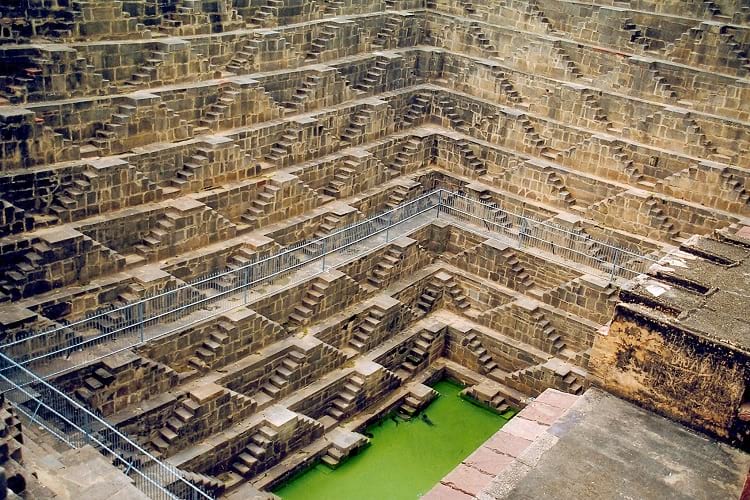
Chand Baori in Rajasthan, India. (Doron / Wikimedia Commons)
Located in the tiny village of Abhaneri in eastern Rajasthan, India, is the deepest stepwell in the world- the Chand Baori. This beautiful structure was built over a thousand years ago by King Chanda in the 9th century. Nobody is quite sure of its exact utility, apart from the obvious water-harvesting. Its location opposite the Harshat Mata Temple has led to the conjecture it might have had religious importance. Though the gigantic structure is not a functional well anymore, it has become a tourist attraction for its fascinating geometry. The stunning historical monument is under the protection of the Archaeological Survey of India (ASI).
What is baori?
The word ‘baori’ or ‘bawdi’ is used to refer to these unique stepwells found exclusively in this part of the world. Stepwells were a very popular method of water harvesting, along with the step-pond, back in the day. The stepwells usually have a very deep and well-rounded bottom to reach the low groundwater levels in the desert. Its narrow shaft is generally protected from direct sunlight by partial roof. A stepwell often developed into a mini-oasis with temples or shelters built into the complex.
The decline in the use of stepwells came about with the British Raj. The British colonists were appalled by the lack of sanitation. The same wells were used for bathing as well as to draw drinking water. Consequently, new stepwells were hardly built, and the existing ones were left to dry and decay. Soon, modern technology replaced the need for stepwells at all.

Inscription by the Archaeological Survey of India at Chand Baori. (Ajay Parikh 103 / Wikimedia Commons)
Structure of Chand Baori
The Chand Baori is a square structure, with each side measuring to 35 metres. From three sides, descend a series of 3,500 slender steps which go down 20 metres to the very bottom. This well has 13 levels and would have provided water year-round despite being located in an arid region. The mathematically precise geometrical structure of the baori is noteworthy, especially in that age. The symmetrically arranged steps create an intricate chiaroscuro effect that looks visually stunning. The stairs taper down to create an almost inverted pyramid shape. Interestingly, the temperature reduces as you go further down. The lower levels of the well are around 5 degrees cooler than the ones above.
The fourth side of the stepwell has a pavilion with a three-storeyed palace. It has intricately carved ‘jharokhas’ or hanging galleries, mounted on pillars, with two small balconies projecting out. This pavilion houses a lot of stunning sculptures as well. Incidentally, the rooms of this palace are inaccessible to tourists. The stairs have railings as well and visitors are not allowed to climb down beyond a point. The entire baori is housed within a rectangular complex, similar to a courtyard.

Chand Baori. (Mukamian98 / Wikimedia Commons)
The history behind Chand Baori
The stunning Chand Baori Complex was built by Raja Chanda of the Gujara Pratihara clan, whom it derives its name from. This clan claims to have descended from Lord Laksmana, the younger brother of Lord Rama. The Baori was built right at the cusp of the Golden era of this clan.
The adjacent Harshat Mata Temple, a shrine to the Goddess of Happiness, provides context to the stepwell’s construction. The baori facilitated the Hindu tradition of washing hands and feet prior to entering a place of worship. The temple itself was razed in the 10th century by Mahmud Ghazni. The ruins still provide an insight into the traditional architecture and sculpting techniques of Ancient India. A rebuilt temple within the complex is now dedicated to Goddess Durga. The complex had a lot of structural additions in the later periods by the Mughals. The compound wall around the baoli, galleries, and cusped arches in the palace on the pavilion are all Mughal structures. These provide a very stark contrast to the sculpting style and trabeated arches used by the Chauhan rulers.

The entrance to Chand Baori. (Mukamian98 / Wikimedia Commons)
Folklore behind Chand Baori stepwell
Apart from its stellar architectural and historical significance, the Chand Baori is also known for the folklore attached to it. Over the years, it has garnered quite the reputation as a haunted spot. The hundreds of shrieking bats inside the well’s shaft only add to the atmosphere. The famously haunted Bhangarh Fort is also on the route to the stepwell, just a few kilometres away. Thus, the Chand Baori has become a popular spot for horror enthusiasts and paranormal researchers. Legend has it that this monumental structure was built over the span of a single night- clearly inhuman feet. The locals put it down to the handiwork of a Djinn. Another lore says that a person going down the stairs cannot use the same steps to climb back up. Seemingly impossible, eyewitness accounts prove it is indeed impossible to climb back up using the same set of slender steps.
The interesting architecture of the Chand Baori has featured in popular movies such as Bhool Bhulaiya in Bollywood and The Dark Knight Rises in Hollywood. Its marvellous geometry has been a part of many notable accounts, such as that of Louis Rousselet, the famous French world traveller, and Morna Livingston, in her book Steps to Water: The Ancient Stepwells of India. Yet, it has hardly found a spot in the annals of history, for posterity to remember it by. The Chand Baori is definitely one of the hidden gems worth checking out in the historic city of Rajasthan, brimming with culture and heritage.
Enjoyed this article? Also, check out “Adalaj Stepwell: A 500-Year-Old Architectural Masterpiece With a Tragic Tale of Unrequited Love, Sacrifice And Loss“.
Fact Analysis:
STSTW Media strives to deliver accurate information through careful research. However, things can go wrong. If you find the above article inaccurate or biased, please let us know at [email protected].
RELATED
The post Chand Baori: A Quaint Remnant of the Past appeared first on .
]]>The post The History of Breast Tax and the Revolt of Lower Cast Women in 19th Century Travancore appeared first on .
]]>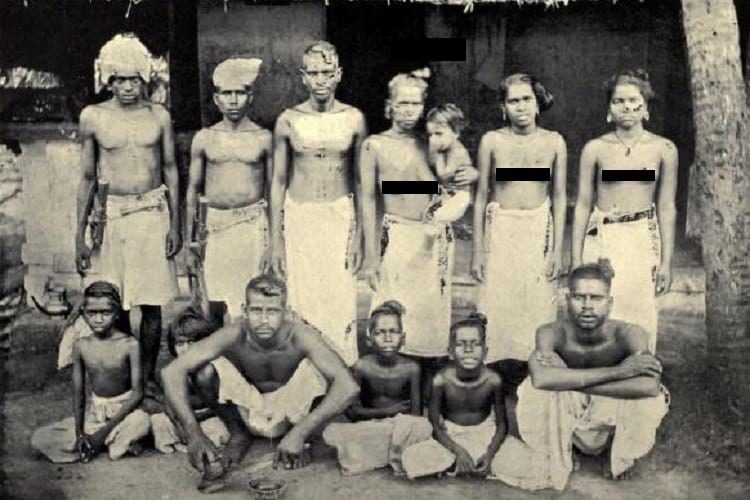
Censored Photo: A Thiyya/Tiyya family, 1900s. (Edgar Thurston)
Throughout history, kings and governments had imposed some weird taxes. You may have heard of a Bachelor Tax, a Cowardice Tax or even a tax on beards. But have you ever heard of a tax on a woman’s breast? Believe it or not, such a tax was imposed on women of lower caste in Kerala during the early 19th century.
The breast tax or locally known as Mulakkaram, which was prevalent in the Travancore Kingdom, was imposed on Dalit and backward class women. It was especially slapped on Avarna women, who belong to the lower caste.
These women were forced to pay a tax on their breasts if they desired to cover their breasts with an upper cloth. In those days, women of low cast baring their breasts were considered as showing respect to superior castes like the Namboodiris (Brahmins).
During the reign of Balarama Varma I
During the reign of Balarama Varma I (1798–1810), Queen Gowri Lakshmi Bayi (1810–1815) and even Uthradom Thirunal Marthanda Varma II (1846–1860) Breast Tax were prevalent. Both men and women of the lower castes like the Ezhava and Nadar communities were not permitted to cover their chests before members of the upper caste.
As the caste system in Kerala of that time was oppressive, people of the lower castes were not entitled to wear any upper cloths. Upper cloths were a sign of prosperity and wealth in those days.
Writing in his book, ‘Native Life in Travancore’, author Samuel Mateer claimed that lower castes were burdened with taxes and remained in debt and poverty. Whereas, the upper caste people like the brahmins and the Nairs prospered.
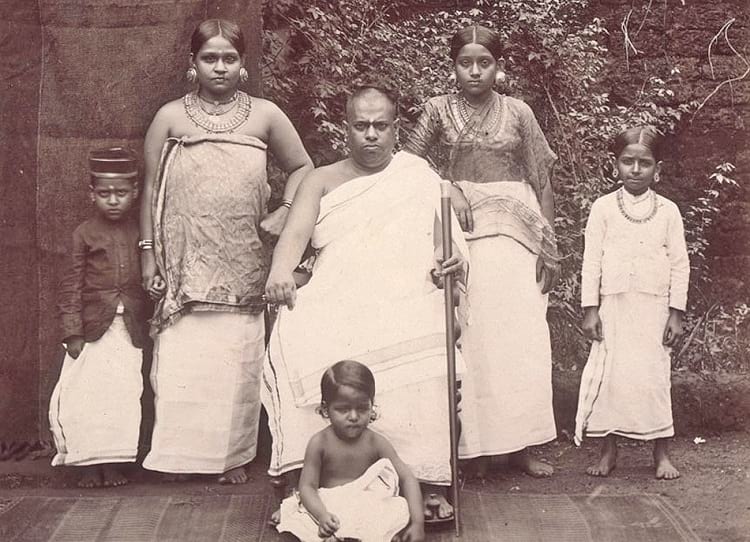
A Brahmin family in Kerala, 1902. (Clain and Perl studio, Madras)
Nair women were also not permitted to cover their breasts
According to an article, Travancore officials would visit every house to collect Mulakkaram from any low caste women who passed the puberty age. There also reports that claimed the tax amount depended on the breast size.
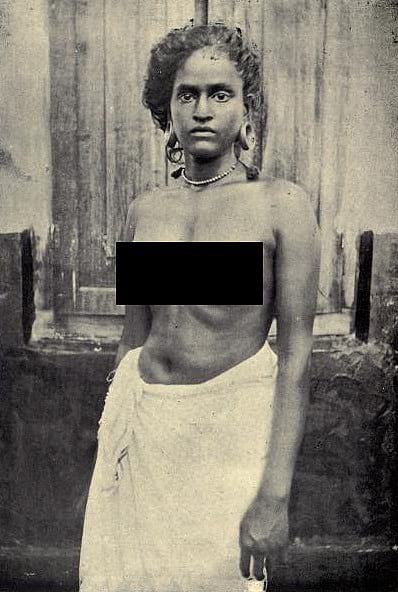
Censored Photo: A woman from a lower caste in Kerala. (Edgar Thurston)
However, it is interestingly to note that Nair women were also not permitted to cover their breasts while entering temples or in front of the Brahmins. There was, therefore, all-around oppression of the people of the lower caste in the Kingdom of Travancore.

Nair Women, circa 1914. (Clain and Perl studio, Madras)
Namboodiri women could cover their breasts
In total contrast to the lower caste woman, Namboodiri women could cover their breasts with an upper cloth. These women were, however, mostly confined to the inner rooms of their homes. Hence, they were known as antharjanam.
Namboodiri women could not talk to anybody except to their husbands and immediate families. On a rare occasion, when they are allowed to go out they were to cover their face with a palm umbrella.
Writing a book on Nair women, R Raman Nair and L Sulochana Devi said when a Nair woman with an upper cloth appeared before the Zamorin, her breasts were chopped off. R Raman Nair and L Sulochana Devi’s book is titled “Chattampi Swami: An Intellectual Biography”.
The rise of the Syrian Christian or Roman Catholic communities
The early 19th century also witnessed the rise of the Syrian Christian or Roman Catholic communities. In 1813, during the reign of Queen Gowri Lakshmi Bayi, Colonel John Munro was the Dewan of Travancore court.
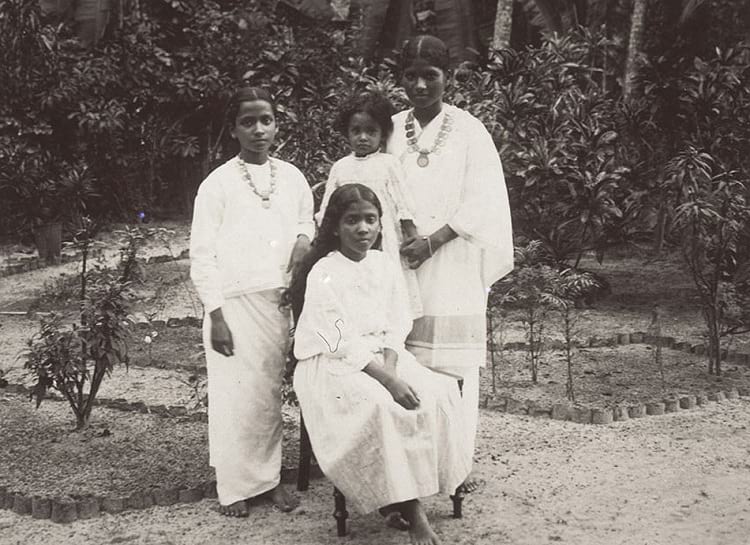
Syrian Christian women in Kerala. (Clain and Perl studio, Madras)
In his bid to propagate Christianity and gain the confidence of the Nadars, Colonel Munro proposed a solution to the oppressive Breast Tax. As Dewan, he issued an order saying that if Nadars convert to Christianity their women can cover their breasts with upper cloth.
This order irked the Queen and her court. Their protests went partially unheard. As a result, the Nadar women were since then permitted to wear a long blouse similar to the Syrian Christians and the Muslims.
Converted to Christianity
Later, however, to escape the royal oppression lower caste people increasingly converted to Christianity to lead an honourable life. Since then women Christian converts had the freedom to cover their breasts with kuppayam or outer cloak.
Yet, the upper castes denied permission to Christian Nadar women from wearing an upper-cloth similar to the Nair women. The Nair women had the privilege of wrapping a cloth around their torso in a particular style.
The idea was to retain caste hierarchy
The idea was to retain the hierarchy between the two communities in a distinct manner. But Christian Nadar women rose in protest. They demanded that they are permitted to wear a cloth similar to the Nair women. With the increasing influence of Christianity, resentment started growing against the upper castes. Following which violent clashes took place across the Travancore kingdom.
Channar Revolt
These protests and clashes came to be known as the Channar Revolt or Channar Lahala. The revolt was also known as Maaru Marakkal Samaram. During the violence that followed, low caste women who wore upper cloth or blouse were stripped naked. Churches and houses of low caste people were also raised to the ground.
According to the book “Religion and Social Conflict in South Asia”, following the intervention of the then British governor located at Madras, the Kings of Travancore issued two proclamations. The first was in 1859. It was issued by Maharaja Utram Thirunal. The second was issued by Maharaja Ayilyam Thirunal in 1865.
Proclamations abolished the Breast Tax
Both the proclamations abolished the Breast Tax and lifted all restrictions on wearing the upper cloths. But these proclamations came too late.
The bravery of a low caste woman named Nangeli
Because, in 1803 the bravery of a low caste woman, named Nangeli, turned symbolic of the struggle for the upper cloth. She belonged to a village called Cherthala in central Kerala. In that 19th century year, Nangeli ferociously defied the tax collector, who reached her house to collect the breast tax.
When the tax collector exerted pressure on her, she unflinchingly chopped off her breasts and placed them on a banana leaf in front of the tax collector. She eventually bled to her death. On coming to know of this, Nangeli’s husband too committed suicide.
Later, the land where she stayed was named Mulachiparambu, simply meaning ‘the land of the breasted woman’.
No mention in the official history of Kerala
Though the story of Nangeli’s sacrifice spread across the state, it has no mention in the official history of Kerala.
The upper cloth mutiny can be considered as one of the pioneering struggles for the liberation of women in the whole of Kerala. Writing on the impact of the revolt in his book titled ‘Vaikuntaswamiyum Samoohika Navothanavum’, historian Joy Balan Vlaathangara said this revolt triggered more agitations across the state.
Some of the other agitations were for the right to walk on public roads, entry into temples and against oozhiyam vela (work without pay). As a result, the face of Kerala changed for the better. It is also sad to note that CBSE deleted a section on Kerala’s caste history in its social science textbook.
Also, there is no mention of the breast tax in the book ‘A Hundred Years in Travancore, 1806-1906: A History and Description of the Work Done by the London Missionary Society in Travancore, South India, During the Past Century’. This is a reflection of the official apathy towards a revolt that changed the very caste structure of Kerala today.
Enjoyed this article? Also, check out “In Tsarist Russia Members of the Secret Skoptsy Sect Believed in Self-Castration“.
Fact Analysis:
STSTW Media strives to deliver accurate information through careful research. However, things can go wrong. If you find the above article inaccurate or biased, please let us know at [email protected]
RELATED
The post The History of Breast Tax and the Revolt of Lower Cast Women in 19th Century Travancore appeared first on .
]]>The post Kuldhara, the Abandoned Village of an Aggrieved Indian Community appeared first on .
]]>
Kuldhara village, Rajasthan. (Suryansh Singh / Wikimedia Commons)
Rajasthan, the Indian state with desert land, scrub forests, high rocks and hills, is also the land of the esoteric and the paranormal. Its folklores are flush with stories about ghosts and how the spirits live on to wreak vengeance, even after the physical body dies. Kuldhara, a village in Jaisalmer district is one such story. A prosperous community of this village was forced to leave their village. They did it under duress, with a heavy heart.
History of Kuldhara
The incident happened in 1825. Kuldhara was a stronghold of Paliwal Brahmins who had made their mark in business and agriculture. Even in water-scarce of desert land, they grew wheat and other water-intensive crops. They were good animal raisers and did business with Sindh (now in Pakistan) and other countries through the old silk route. They traded in food grains, poppy, indigo, ivory, and dry fruits on camel back. All was going hunky dory for the community till the Diwan of Jaisalmer, Salim Singh, came on the scene. He was Diwan of Jaisalmer, and a corrupted one. His lecherous gaze fell on the daughter of the village chief. The chief must marry his daughter to him; else face disastrous consequences, by way of punitive taxes.
For Paliwal Brahmins, it was a second major migration
The village chief had a Hobson’s choice. Marry his daughter to a debauch, or suffer a crushing tax burden. A council was held. The council of Kuldhara and neighbouring villages ruled that their daughter wouldn’t be given to a lout who already had 7 wives. Nor would they accept the taxes. They would rather move out with whatever they can carry easily. This was a second such crisis for the community. First happened at their erstwhile abode in Pali, Jodhpur. The king of Jodhpur, envious of their prosperity, increased their tax burden inordinately. That had forced their first migration. Now was the time for the second migration. Their tumultuous history was repeating itself.

Remains of houses in Kuldhara village. (Archan dave / Wikimedia Commons)
They left their homes and cursed village to remain deserted forever
So, on a dark night, there was a mass exodus of about over 1500 people from Kuldhara and adjoining 85 villages. They left their homes, and most of their belongings, and walked out in the wilderness. So discreet was the march that it went unnoticed. It is believed that the community moved to Madhya Pradesh, Uttar Pradesh and Maharashtra. But while departing, they cursed the land they left behind. That it will never be populated. And, whosoever will try to settle here, will suffer their curse.
Most villages around Kuldhara, with their names altered, are colonized now. But Kuldhara and partly Khaba (home to Hindus displaced from Pakistan) still remain desolate.
Haunted looks and an eerie ambience
The curse of the oppressed Brahmins of Kuldhara has worked. There is a prevailing belief that whosoever tried settling in Kuldhara, was rattled by paranormal forces. With sunset, the place is closed for visitors. People in the neighbouring areas believe that supernatural forces descend in the village at the night time. The fact is corroborated by investigation of the paranormal society, New Delhi. Weird sounds, spooky shadows, damage to the parked vehicles and more such bizarre incidents occurred with people staying here beyond the day time.
The area is a promising tourist spot
The deserted sandstone houses of village bespeak of good architectural design. The remnants of 600 living homes, temple, wells, water reservoir, water ponds and public places reveal that the community had an aesthetic sense of living. The site is now supervised by the Archaeological Survey of India. Plans are underway for renovations to make this village visitor – friendly and an enjoyable tourist destination.
Enjoyed this article? Also, check out “Dhanushkodi: Where a Cyclone Ripped Apart an Entire South Indian Town, Rendering it Uninhabited“.
Fact Analysis:
STSTW Media strives to deliver accurate information through careful research. However, things can go wrong. If you find the above article inaccurate or biased, please let us know at [email protected].
RELATED
The post Kuldhara, the Abandoned Village of an Aggrieved Indian Community appeared first on .
]]>The post How Air India Carried Out the World’s Largest Civilian Evacuation in 1990 appeared first on .
]]>
File photo of Air India. (Caribb / Flickr)
When Iraq invaded Kuwait on 2 August 1990, the Indian expatriates in the latter country were left without the means to leave from the war zone. The Indian government sprang into action to rescue their citizens. Over a period of two months, between 14 August 1990 and 11 October 1990, Air India evacuated over 170,000 civilians from Kuwait and Iraq. It was the world’s largest civilian evacuation in history.
Iraq’s invasion of Kuwait
There were several reasons for Iraq’s invasion of neighbouring Kuwait. Iraq believed that Kuwait was purposely keeping its petroleum production at high levels to lower Iraq’s petroleum revenues. Further, Iraq was convinced that Kuwait was stealing its petroleum to the tune of $2.4 billion through slant-drilling across the international border into Iraq’s Rumaila oil field.
Kuwait, on its part, was unwilling to forgive the $15 billion loan it had given Iraq to finance its war with Iran between 1982 and 1988.
As a result, diplomatic relations between the two countries grew strained, and Iraq’s solution to the problem was to annex Kuwait. The Kuwaiti armed forces were unable to counter the Iraqi army’s assault, and, within two days, Iraq was able to proclaim Kuwait to be the 19th province of Iraq.
The Indian expatriates in Kuwait
The high-income economies of the Persian Gulf countries, particularly Kuwait and Iraq, had long attracted highly-qualified Indian professionals. Engineers, management consultants, and retail traders, as well as labourers, flocked to these countries to work in the booming construction industry. Most of these people were from the southern Indian state of Kerala. By 1990, the Indian expatriates constituted a significant community in Kuwait, and many of them had lived there for more than a decade, some even for several generations.
They did not at first comprehend that the impact of the Iraqi invasion would unsettle their lives. The Iraqis had traditionally had friendly relations with Indians, and so the presence of the Iraqi army did not pose a threat to the lives of the Indians in Kuwait. However, the breakdown of the Kuwaiti civilian government left the people at the mercy of thieves and armed looters. Soon, there was food scarcity everywhere in the country and water and electricity were also in short supply. These factors put an end to the illusion of normalcy.
As the Iraqi occupation continued, the Iraqis began to indiscriminate against and harass non-Kuwaitis. They jailed them for not getting Iraqi residence permits and Iraqi registration for their cars. By the time the realisation dawned on the Indian expatriates that it was no longer safe for them to continue living in Kuwait, it was too late to make a planned exit with all their possessions. They had to flee, some with only the clothes they were wearing, leaving their homes, their belongings, and everything else that they had worked so hard for over the years. For some people, even leaving with nothing became problematic as their employers had their identity documents, and, in the reigning chaos, they could not find or contact them.
The Indian Government assumes responsibility
The governing Kuwaiti royal family had fled to Saudi Arabia at the beginning of the Iraqi invasion, and there was now an Iraqi-appointed government in Kuwait. Since the government of India took it upon itself to bring its citizens safely back home, it had to negotiate with Iraq for their transfer.

Inder Kumar Gujral, the then Minister of External Affairs. (Biswarup Ganguly / Flickr)
The government sent I.K Gujral, the then Minister of External Affairs, to Baghdad to assure the Iraqi authorities that India’s only concern in the conflict was the safety of its citizens. Mr. Gujral met with Saddam Hussein, the Iraqi President, to discuss the situation as well as to discuss the bilateral trade relations between India and Iraq in the backdrop of the blockade by Western countries.
Getting the necessary air space clearances to use military aircraft to transport a large number of people was a cumbersome process, so civilian aircraft were the only option. It was, however, not possible to use the airports in Kuwait and Iraq as the Iraqi government had banned all incoming and outgoing flights.
Eventually, the Jordanian authorities agreed to allow India to operate flights out of Amman for the evacuation, and India’s national airlines Air India and its domestic counterpart Indian Airlines headed for Amman.
The task of organizing the entire operation fell upon M P Mascarenhas, who was Air India’s regional director in the Gulf & Middle East. He and his Air India team conducted the operation from a small hotel room in Amman. The Indian Embassy and the Ministry of External Affairs called for emergency assistance from its officers in India, Lebanon, and Bahrain to process the passports of the evacuees and to issue travel documents to those who needed them. The local Jordanian authorities helped the Indians in the evacuation operation with customs officials resolving the identity problems that cropped up at the border crossing.
Largest civilian evacuation
After the Indian embassy announced the government’s decision to undertake the evacuation, an exodus began towards Amman. Those who had vehicles and could get fuel started on the road to Amman. Every day, over the next two months, thousands of Indian nationals crossed Iraq to reach Al Ruwishied, the solitary outpost on the border between Iraq and Jordan.
When Iraq issued a directive to all diplomats to leave Kuwait, forcing the Indian embassy staff to relocate to Basra in Iraq, some Kuwait-based Indian businessmen, like the Malayali entrepreneur Mathunny Mathews and the architect Harbhajan Singh Vedi, formed the Indian Citizens Committee to coordinate the evacuation operation.
Shaji John Verghese, an electronics engineer, helped to set up a clandestine ham radio in the Indian school in Salmiya, a middle-class suburb in Kuwait. Through the ham radio, the Citizens Committee was able to communicate with the Ministry of External Affairs in Delhi and the Indian ambassador in Baghdad. They got approval from the Iraqi authorities and transporters to use buses to transport people from Kuwait via Basra and Baghdad to Amman in Jordan. The problem was the limited number of available buses, far too few to fit the entire gathered mass of desperate people.
Many of the evacuees that arrived in Amman crowded into the compound of the Indian embassy there. They waited on the embassy lawns, rolling out rugs and mattresses and even erecting makeshift tents. Others camped in the airport and the more fortunate found rooms in the local hotels. Tempers were frayed all around from the anxiety of their ordeal, from the lack of proper sleep, food, and water, and from not knowing exactly when they would be able to secure flights back to India.
In the end though, despite all the problems, the Indian government managed the whole operation with resounding success. It took around two months and 488 flights to transport over 100,000 people from Amman to Bombay. No other country had ever attempted a civilian evacuation of this magnitude before and Air India made it into the Guinness Book of World Records as the only civil airlines to have evacuated so many people.
As unrest erupted further in the Middle-East in the coming years, India was to undertake a few more mass evacuations to bring Indian nationals out of strife-ridden regions.
Enjoyed this article? Also, check out “Battle of Saragarhi: When 21 Valiant Indian Soldiers Held Their Ground, Fiercely Fighting Against Thousands of Afghans“.
Fact Analysis:
STSTW Media strives to deliver accurate information through careful research. However, things can go wrong. If you find the above article inaccurate or biased, please let us know at [email protected]
RELATED
The post How Air India Carried Out the World’s Largest Civilian Evacuation in 1990 appeared first on .
]]>The post Maharajas’ Express: An Ultra-Luxury Indian Train That Redefines the Experience of Travelling appeared first on .
]]>
Maharajas’ Express. (Simon Pielow / Flickr)
Train journeys have always held a special place in the heart of people, giving them fond memories to recount. Travelling across villages and cities and watching the lush green countryside and colourful cityscapes roll by, is an exceptional experience for travelers all over the world. But Indian Railways’ Maharajas’ Express is one luxury train that literally goes the extra mile to make sure its patrons have a royal experience of a lifetime on their trip, as the express makes its way through more than twelve choicest destinations in the country.
History of Maharajas’ Express
A joint venture between the public-private organizations of Indian Railway Catering and Tourism Corporation Limited (IRCTC) and Cox and Kings India Ltd. respectively, Maharajas’ Express was started in the year 2010 with a view to boost tourism in North India. The two corporations signed a deal and set up a new company called Royale Indian Rail Tours Ltd., which was to supervise the entire management of Maharajas’ Express. But few months into the partnership and the companies were already running into financial losses, for the business was not very lucrative in its initial days. Cox and Kings India Ltd. had invested a huge sum of money into the venture, while IRCTC claimed that it could bring in more profits if it was given the upper hand in the management duties. This led to a dispute between the two parties and the matter was taken to court.

Maharajas’ Express at a station. (Simon Pielow / Flickr)
Following the Supreme Court orders, it was finally decided that IRCTC would take full charge of the operations of Maharajas’ Express alone and with lowered prices, it would offer the same services as it had promised initially. The contract between the two companies was then terminated a year later in 2011. Ever since, IRCTC took over the operations of Maharajas’ Express and is now being managed exclusively by the Indian Railways, becoming the most expensive luxury train in the world.
Tour Packages of Maharajas’ Express
Depending on the itinerary, the Maharajas’ Express covers several destinations in the country, mostly traversing the northern part of India, centering on Rajasthan. The best part about this train travel is that it allows a traveler to enjoy a royal experience only on wheels. The express generally starts its journey at night and travels to places mentioned on the tour package in a span of nine days at a maximum, which is part of its longer route. The shorter trip package includes only a three-day tour on board the luxury train. Although the train travels through several routes, the one that passengers enjoy the most, not only from India but also from foreign lands, is called the Princely India, wherein the express train journeys through the major cities of the state of Rajasthan.

Maharajas’ Express route map. (Simon Pielow / Flickr)
The package called Indian Panorama includes a tour of the country’s breathtakingly beautiful landscapes starting from Delhi and covering Rajasthan’s Jaipur and Ranthambore and going all the way from Fatehpur Sikri to Varanasi, Lucknow, Agra, Khajuraho and Gwalior. Another route called The Indian Splendour journeys from Delhi and covers Udaipur, Bikaner, Jodhpur and Mumbai, along with Agra, Jaipur and Ranthambore. Other itineraries, which cover almost the same cities, are called The Heritage of India, The Indian Panorama, Treasures of India and Gems of India.
The Southern Sojourn tour package covers Ratnagiri, Goa, Mysuru, Hampi, Trivandrum and Cochin, while the Southern Jewels include a tour of South Indian cities like Chettinad and Mahabalipuram, along with cities from the Southern Sojourn package.
Facilities provided by Maharajas’ Express
With a total of twenty-three luxury coaches, the Maharajas’ Express offers four categories of cabins, including a Presidential Suite, a Junior Suite, a Suite and a Deluxe Cabin. All the coaches are named after precious stones like Heera (diamond), Moti (pearl), Panna (emerald), Pukhraj (topaz), Neelam (sapphire), Firoza (turquoise) etc. The artfully crafted coaches and thematic décor complement the ambience inside each luxurious cabin. Even the details in every cabin, including its color, are such that they match the royal theme perfectly. The Presidential Suite is elegant and very richly decorated, with space enough for two bedrooms and a grand living room too. Out of the twenty-three coaches, one is reserved entirely for the staff and members of the management, which also has a travelling doctor on board in case of any emergency during the course of the journey. One coach can carry at least eighty-eight passengers travelling together.

Junior suite. (Simon Pielow / Flickr)

Lounge of the presidential suite. (Simon Pielow / Flickr)
Amenities inside the Maharajas’ Express
Each cabin measures around 112 square feet and has room enough for a double bed, a foldable writing desk and a luggage storage space underneath the bed, a wardrobe, an electronic safe for personal belongings and an air conditioner. The lavish interiors also have a smoke detection system, CCTV cameras and pneumatic suspension for a smoother journey. The state-of-the-art cabin also provides a plasma television set that plays satellite channels, Wi-Fi facilities, carpeted floors and climate control system to make the journey more memorable. The luxury bathroom in each suite is well-equipped and has a shower cubicle, an elegant bathtub, a water closet and a wash basin with a continuous supply of hot and cold water as per the need. The twenty-four hour valet answers to guests’ calls whenever made.

A bathroom from one of the suite. (Simon Pielow / Flickr)
The coaches also have boutiques, bars and restaurants, which offer nothing less than a five-star dining experience on wheels. The plush lounge bar called The Rajah Club offers an exquisite range of drinks for its patrons. It also offers games tables for a more entertaining and relaxed trip. Comfortable seating arrangements in this luxury lounge, along with corporate bars for meetings on board are also included in the list of amenities on the Maharajas’ Express.

Maharajas’ Express – Bar. (Simon Pielow / Flickr)
A well-equipped kitchen offers an eclectic mix of meals ranging from Indian cuisine to Western dishes. Two restaurants called Mayur Mahal and Rang Mahal offer seating capacities for forty-two guests at a time and serve food from an international platter. All onboard meals are served in the two eateries. Expensive cutlery and tableware adorn each dining table for a more fine dining experience.

Dining at Maharajas’ Express. (Simon Pielow / Flickr)

Cutlery and tableware. (Simon Pielow / Flickr)
Awards received by Maharajas’ Express
While in service since the last nine years, the Maharajas’ Express has added quite a lot of feathers to its already brimming cap. It has been consecutively voted The World’s Leading Luxury Train for five times between the years 2012 to 2017 at the World Travel Awards held in different countries. It won the CNBC Travel Awards in the years 2015 and 2010, and was also adjudged winner of the Seven Stars’ Luxury Hospitality and Lifestyle award in the years 2016 and 2015. It was the first runner-up at the Conde Nast Travellers Readers’ Choice Award in the year 2011 among other recognitions that it has earned since its inception.
The Indian luxury train that charges a whopping fare for a week-long journey to world heritage sites in the country, offering several facilities akin to a stay at an opulent hotel is what makes its tour even more special. Providing a world-class travel experience on wheels, the royal journey on Maharajas’ Express is definitely a once-in-a-lifetime tour one can ever undertake.
Enjoyed this article? Also, check out “The Idea Behind the Rotary Snowplow Train was Conceptualised by a Dentist“.
Special thanks to Simon Pielow, co-founder of The Luxury Train Club for releasing the above images under creative commons.
Fact Analysis:
STSTW Media strives to deliver accurate information through careful research. However, things can go wrong. If you find the above article inaccurate or biased, please let us know at [email protected].
RELATED
The post Maharajas’ Express: An Ultra-Luxury Indian Train That Redefines the Experience of Travelling appeared first on .
]]>The post IAF Mirage 2000: The French-Made Fighter Aircraft that Answers India’s Call of Duty appeared first on .
]]>
Dassault Mirage 2000. (Airwolfhound / Flickr)
The military preparedness of any nation is judged by its loaded arsenal. And if it has the best in its collection to supply to its army, navy and air force, that country no longer lags behind in war. In light of the ghastly terror attack in Kashmir, the Indian Air Force, which recently carried out a surgical strike on Pakistan, is the proud owner of a fleet of aircraft that only some of the superpowers of the world possess. The Mirage 2000, an impressive and deadly aerial beast, is a fighter jet that has come to India’s rescue in all her times of need.
Mirage 2000 in brief
Designed in the late 1970s and manufactured in France by Dassault Aviation, the Mirage 2000 is a multirole combat aircraft, which can perform a wide range of tasks. Right from aerial combats to dropping bombs, long-range missiles at specific targets and also carrying out air-to-ground strikes, the light-weight fighter plane is undoubtedly a force to reckon with. It was initially pressed into service in the French air force in the year 1984 after it took its maiden test flight in the year 1978. In service with nine other countries, including Brazil, Egypt, France, Greece, Peru, Qatar, Taiwan and the UAE, the fleet of Indian Air Force’s Mirage 2000s came to be inducted in the year 1985. Together with the advanced and heavy fighter jets like the Russian-made Sukhoi and MiG-29 and the indigenously-developed Tejas, the aircraft was put into Indian service during the Kargil War of 1999.

Countries that use Mirage 2000. (Wikimedia Commons)
While Pakistan purchased North American-made Lockheed Martin F-16 fighter planes, India went a step ahead and ordered thirty-six single-seater and four twin-seater Mirage 2000s in the year 1982. Since then named ‘Vajra’ from the Sanskrit word for thunderbolt, the Mirage 2000 is an ultra-modern warplane that mostly delivers with hundred per cent accuracy. The aircraft readily served in India’s favour against Pakistan at the line of control in Kashmir.

IAF Mirage-2000. (Tech. Sgt. Keith Brown / U.S. Air Force)
Specifications of Mirage 2000
Despite a dry weight (which includes the weight of crew and passengers, fuel, other necessary fluids and scientific equipment) of around 7,500 kilograms and a maximum takeoff weight (maximum weight at which an aircraft is allowed to make an ascent) of 17,000 kilograms, Mirage 2000 still remains a light-weight aircraft. It measures approximately forty-seven feet in length and has a wingspan of around thirty feet. The delta wings (triangular wings shaped in the Greek alphabet Delta) allow the jet to manoeuver smoothly and maintain its stability mid-air. The IAF Mirage 2000 is available in single or twin-seater options as per the requirement of the air force. The fighter jet with a single-shaft engine can ascend at a maximum speed of 60,000 feet per minute and can reach a maximum speed of 2,335 kmph or Mach 2.2.

The Dassault Mirage 2000 is capable of aerial refuelling. (US Gov)
The Mirage 2000 hits targets with precision and remains the most reliable aircraft in the Indian Air Force. Even the state-of-the-art pilot helmets of Mirage 2000 come equipped with a display inside them. These allow the pilots to see superimposed radar data directly inside, without having to refer to information relayed in the cockpit. This feature enables the pilots to aim weapons at targets by simply turning their heads, without manoeuvering the entire fighter plane in that particular direction.
As many as twelve fighter jets flew into Pakistani airspace recently and the combat aircraft, which also happens to be India’s most preferred war plane, is the country’s trusted aide that thunders in its skies, delivering with a success rate like no other, answering all the calls of duty whenever made.
Enjoyed this article? Also, check out “Hughes H-4 Hercules | The Largest Flying Boat That Flew for Only 26 Seconds“.
Fact Analysis:
STSTW Media strives to deliver accurate information through careful research. However, things can go wrong. If you find the above article inaccurate or biased, please let us know at [email protected]
RELATED
The post IAF Mirage 2000: The French-Made Fighter Aircraft that Answers India’s Call of Duty appeared first on .
]]>The post Tipu’s Tiger: Tipu Sultan’s Macabre 18th Century Mechanical Toy That Doubled Up As a Pipe Organ appeared first on .
]]>
Tipu’s Tiger at V&A Museum. (Victoria and Albert Museum / Wikimedia Commons)
No one would like to keep the memory of his sworn enemy in his living room. If one does, there must be a strong reason behind it. Tipu Sultan, the ruler of Mysore from 1782 to 1799 had a memento about his bitter enemy being ravaged by a life-size tiger. It was a mechanical toy called ‘Tipu’s Tiger’. After his death, the British, the enemy, took away this contraption and used it to their advantage. They displayed it to justify why they had to wage a war against Tipu and liquidate him.
‘Tipu’s Tiger’ says a lot about pre-colonial India and its general response to British imperialism.
Rivalry with the British came to Tipu as an inheritance
Battle of Plassey, 1757, gave British a foothold in Bengal to colonize India for the next 100 years. Tipu Sultan’s father, Haider Ali, defeated the British in 1st Anglo-Mysore war in 1767. The second Anglo-Mysore War (1780-84) was inconclusive, but the third (1792) gave the British a clear victory. Postwar negotiations demanded half of Mysore’s geographical territory and a big chunk of the state treasury. To ensure transfer of the negotiated bounty, two sons of Tipu Sultan, Prince Abdul Khaliq (8 years) and Prince Muza-ud-din (5 years), were taken hostage by the British. The pawn though was shown as an act of British benevolence towards young-ones of the vanquished King. No wonder Tipu Sultan was deeply hurt with the double whammy of losing his kin and kingdom. What could soothe his frayed nerves?
The toy tiger
Tipu found solace in a mechanical contraption he got custom made to show his angst against the British duplicity. The tiger was his state-symbol. He ordered a life-size wooden tiger mounted on a supine British soldier. A metal frame was put in place to close and open a window on the tiger’s left flank. Putting tiger into play mode activated a music system fitted within. The sounds that came out of the system were an admixture of tiger growling and the victim moaning. At the same time, the soldier’s left hand moves like last minutes of a dying person.

Tipu’s Tiger front view. (Victoria and Albert Museum / Wikimedia Commons)
This indeed was an apt release of Tipu’s pent-up emotions. The British referred to him as the Tiger of Mysore and the Toy tiger became a euphuism for Tipu Sultan ravaging the British Imperialism represented by the prey, the white soldier. Tipu toiled hard to put ravaged Mysore back into shape. Adopting European technologies, reforming the military and strengthening foreign relations was part of his action plan. Nevertheless, the British juggernaut overwhelmed him.
Tipu met his nemesis
In the 4th Anglo-Mysore war in 1799, Tipu went down fighting valiantly. His capital city, Seringapatam, was taken over by the British. White soldiers ransacked and looted the vanquished property till the Duke of Willington intervened a few days later to restore law and order. State treasury, precious metals and jewellery looted from the king’s palace were distributed as rewards in the British army. Tipu’s golden throne was gifted to the East India Company Directors in London. His mental solace, the mechanical tiger, was also dispatched to Britain. It was displayed in East India Company’s New Indian Museum. When the museum closed, it was sent to South Kensington Museum in London, which was subsequently renamed as Victoria and Albert Museum.
Tipu’s Tiger became an emblem for both the British and colonial India to justify their animosity for each other in different ways
Needless to say, British Used Tipu’s mechanical tiger to demonstrate that Tipu was a cruel aggressor and they the poor sufferers like the mauled white soldier in the contraption. A press report on it said: “… a sufficient proof (if any were yet wanting) of the deep hatred of Tippoo Saib towards the English nation.”

The head of the automaton. (Victoria and Albert Museum / Wikimedia Commons)
Tipu’s toy became a symbol of the bitter rivalry between the British and the Indian rulers, with dual meanings. For the British, it indicated how cruel the Indian rulers were to them. To the Indians, it represented how India responded to the highhandedness of British Imperialism.
Enjoyed this article? Also, check out “Peacock Clock: An 18th Century Automaton Marvel“.
Recommended Visit:
Victoria and Albert Museum | London, UK
Fact Analysis:
STSTW Media strives to deliver accurate information through careful research. However, things can go wrong. If you find the above article inaccurate or biased, please let us know at [email protected].
RELATED
The post Tipu’s Tiger: Tipu Sultan’s Macabre 18th Century Mechanical Toy That Doubled Up As a Pipe Organ appeared first on .
]]>The post The Egyptian Vultures of Tamil Nadu’s Vedagiriswarar Temple appeared first on .
]]>
A priest feasting the sacred Egyptian Vultures. (Edgar Thurston / Madras Government, India)
Some of India’s temples are famous not only for their architectural finesse, their beautiful surroundings, and the piety they invoke in believers but also for certain quite inexplicable happenings that continue to baffle onlookers. The Vedagiriswarar Temple is a fine example of this. For several centuries, the temple was famous for hosting a remarkable pair of birds that appeared exactly at noon to accept prasad from the temple’s priest.
The birds of Vedagiriswarar Temple
Nobody knows exactly when the birds started arriving at the upper temple, but they came regularly for many centuries. They alighted on a rock near the temple at noon on the dot and then the priest would feed them a prasad of ghee, sugar, rice, and wheat. If on occasion, the Egyptian Vultures did not show up, it was on account of the presence of sinners amongst the crowd (or) onlookers.
The Temple authorities and the devotees do not consider the Eagle Vultures to be ordinary birds, but there are differing folklores about what they actually are.
According to one version, the Eagle Vultures are the eight sages or Asthavasus who once displeased Lord Shiva and the quick-tempered God then cursed them to live as birds until they had performed penance. Lord Shiva ordered them to visit his temple in Vedagiriswarar to pray to him and receive prasad from the temple priests. The birds lived for three yugas or epochs, with six of the sages getting mukti (emancipation) and the last two surviving to the present epoch.
By another version, the Eagle Vultures are Sage Poosha and Sage Vruddha. They once prayed long and hard to Lord Shiva in order to obtain the elevated Sharoopa status. Lord Shiva, however, was willing to grant them only the Sayujya status at that time and said that he would consider granting them the Sharoopa status later perhaps when he thought they were worthier of it. Instead of accepting what Lord Shiva offered them, the two Sages argued with him and insisted on being given the Sharoopa status right then and there.
Angered by their insistence, Lord Shiva cursed them and turned them into Eagle Vultures and informed them that they would remain birds until the end of the Kali Yuga. In the meantime, they were to worship him at the Vedagiriswarar Temple. For generations, the birds followed his diktat and appeared at the temple. In the Thretha Yuga, they went by the names Sandan and Prasandan. In the Kritha Yuga, they called themselves Sambathi and Jadayu. In the Dhawapara Yuga, they called themselves as Sambhukthan and Mukundan. Now, in the Kali Yuga, they are Pusha and Vidhadha.
The local lore tells us that the birds daily fly across a distance of some 3218 km from Varanasi to Thirukazhukundram to feed at Vedagiriswarar Temple at noon and then first fly southward to Rameswaram and then northward to Chidambaram to spend the night there for some much-needed rest. The next morning, they fly to bathe in the Ganges in Varanasi and the return again by noon to Vedagiriswarar Temple.
Perplexing bird behaviour
Egyptian Vultures are birds that normally congregate in flocks and feed on carcasses. For only a pair to appear on a regular basis at Vedagiriswarar Temple and that too to feed on food that is not the natural food of Vultures is odd behaviour, if you consider the matter from a scientific point of view. Some bird researchers think that if the birds have been coming to the temple for centuries it is on account of learned behaviour that the parent birds have passed down to their progeny or from bird relatives to other birds.
The Egyptian vultures stop visiting Vedagiriswarar Temple
Since 1998, the Egyptians Vultures have stopped showing up at Vedagiriswarar Temple. It may be because there are too many sinners flocking in the area. Or it may be that the last pair of Ashthavasus has finally attained moksha. Or, more prosaically, the last pair of Egyptian Vultures failed to either raise a new generation or failed to point them in the direction of the temple or failed to cultivate in them a taste for the temple prasad.
No one knows what the reason is exactly, but the priests at Vedagiriswarar Temple continue to scan the skies and keep vigil in the expectation that the birds may one day return as they did in past centuries.
Vedagiriswarar temple
Dedicated to Lord Shiva and located in the town of Tirukalukundram, also called Thirukazhukundram, in Tamil Nadu, the Kings of the Pallava Dynasty built the temple and it displays some of the best elements of ancient Dravidian architecture.

Vedagiriswarar temple. (Simply CVR / Flickr)
Vedagiriswarar Temple is actually a temple complex that has two temples. One of the temples is at the foot of the hill and the other one is at the top of the hill. You must climb over 500 steps to reach the upper temple.
Lord Shiva resides in the upper temple and his consort, Parvati, resides in the lower temple. Vedagiriswarar is one of Lord Shiva’s many names and Parvati, in this instance, goes by the name of Thiripurasundari Amman.
Her temple, the Bakthavatchalaeswarar Temple, covers a large area of around 10 acres and has exquisite architectural features that include four gopurams, curved mandapams, and a high compound wall. The architectural style is similar to that of the Annamalaiyar Temple. There is also a huge water tank called Sangu Theertham that looks almost like a lake. The water contains minerals that confer it with health-giving properties and the priests use it to perform the abhishek rites on the temple deities. Devotees can drink this water.
Another remarkable thing about the Sangu Theertham is that every 12 years a Sangu or Couch Shell emerges from the depths and floats on the water surface. The priests have collected these Couch Shells and made them available for public viewing.
According to Hindu Mythology, Vedagiriswarar Temple sits on top of the tallest of the four Vedic hills – hence the name Vedagiri or mountain of the Veda – that Lord Shiva created to fulfil Sage Bharadhwaja’s wish to master the four Vedas. The Sage wanted to live for a very long time, so he would be able to learn everything in the Vedas.
Shiva granted him his wish but informed him that learning was a never-ending process and no matter how long one lived one could never know everything there was to know in the Vedas. Spending years learning the verses in the Vedas, therefore, wasn’t the proper way to attain to salvation. For true salvation, one needed genuine devotion or Bhakti.
In addition to being called Vedagiriswarar, devotees also call the temple Kazhugo Koil, which means an Eagle Temple, and they call the surrounding town Pakshi Theertham or a Pilgrimage Place of Birds. Interesting, the official name of the town, Thirukazhukundram, also pertains to birds in the Tamil language. Thiru means respectful, Kazhu means an Eagle or a Vulture, and Kundram means mount. So Thirukazhukundram means Respectful Mount of the Eagle or Vulture.
Thirukazhukundram is a very famous pilgrimage destination for Hindus and is about 15 km away from Mahabalipuram and 15 km away from Chengalpattu.
Enjoyed this article? Also, check out “Dhanushkodi: Where a Cyclone Ripped Apart an Entire South Indian Town, Rendering it Uninhabited“.
Fact Analysis:
STSTW Media strives to deliver accurate information through careful research. However, things can go wrong. If you find the above article inaccurate or biased, please let us know at [email protected].
RELATED
The post The Egyptian Vultures of Tamil Nadu’s Vedagiriswarar Temple appeared first on .
]]>The post Pamban Bridge: A Historic Indian Sea Bridge That Was Built on Modern Principles appeared first on .
]]>
Pamban Bridge. (Ashwin Kumar / Flickr)
India is a culturally rich country and South India, in particular, is very different from the rest of the nation. Lined by the blue waters of the ocean and dotted by palm trees, the southern part of India has diverse climatic conditions as compared to the whole of India. Falling on the eastern coast of the country, the southernmost state of Tamil Nadu has a unique and first-of-its-kind bridge in India, which till date, not just inspires but also fills every Indian with a sense of pride. The approximately 2.3-kilometre-long Pamban Bridge is the first ever Indian sea bridge, connecting the port town of Rameswaram on Pamban Island to Mandapam on the Indian mainland in Tamil Nadu.

Overview of Pamban Bridge. (Shubham Gupta / Wikimedia Commons)
Basics of the Pamban Bridge
Way back in the 1870s, when the colonial British wanted to open trade with Sri Lanka (then known as Ceylon), they came up with the idea of a bridge for transport purposes. However, the plan was only put in motion in the year 1911 and the first ever Indian part-cantilever-part-conventional bridge was opened in the year 1914. More than a hundred years old now, the Pamban Bridge was the only way of getting to Rameswaram, until a parallel road bridge was constructed in 1988, easing transport further. Designed as per the specifications patented by German-origin American engineer William Donald Scherzer, the movable drawbridge or double-leaf bascule bridge can be rolled up vertically to allow movement of ships underneath. Six men on each side manually roll up the two spans to clear sea traffic below. This bascule feature was one of the firsts for any Indian bridge constructed during the British times.

The movable drawbridge on Pamban Bridge. ([email protected] / Wikimedia Commons)
The Pamban Bridge has as many as 143 fixed spans in total and one pair of navigation spans, on which the concrete railway overpass rests, supporting train movement day in and day out. Sitting on an artificial reef, it required nearly 5,000 tonnes of cement, 2,600 tonnes of steel and 98,000 cubic feet of rocks and crushed stones to construct the bridge. Standing on the Palk Strait between the countries of India and Sri Lanka, The Pamban Bridge is located in one of the most corrosive environments in the world. It is also the location of high-velocity winds, which the historic bridge has withstood for over a century. This corrosion-causing climate, along with the windy weather, poses a great threat to the structure every now and then, making its maintenance a little too difficult.
Mythological significance of the Pamban Bridge
Experts argue that Ramayana, which is the epic tale of victory of Lord Rama over the demon king Ravana, has Pamban Bridge’s mention in it. As per the Ramayana, it is nothing but Rama Setu, which the future king of Ayodhya had built. It is said that Rama Setu was manually constructed by Lord Rama, employing Lord Hanuman’s Vanar Sena and many other animals to get to Lanka, where Ravana had held his wife Sita captive. It is also said that the ghost town of Dhanushkodi, situated in south-eastern Pamban, is where the Rama Setu originates and can be seen from space.

Pamban bridge (on the right) next to the Annai Indira Gandhi Road Bridge (on the left). (ShakthiSritharan / Wikimedia Commons)
Accidents on and off the Pamban Bridge
Completed in a span of fourteen years, the Pamban Bridge once fell into the eye of a storm literally during the 1964 Rameswaram Cyclone. The powerful typhoon not only overturned a train carrying 150 passengers, killing all of them and breaking a part of the bridge too; but it also ripped apart Dhanushkodi, which till date remains in shambles and uninhabited ever since. In the year 2013, a barge belonging to the Indian Navy collided with the Pamban Bridge, but thankfully, the damage it had caused was very little. Repair and maintenance works had briefly halted railway services to Rameswaram from Tamil Nadu.
Initially functioning as a meter-gauge railway line, the bridge only got a major facelift in 2007, when a broad-gauge line was introduced, allowing even goods trains to ply between the two towns. As recently as 2016, the Indian Ministry of Railways has sanctioned approximately 3.5 million US dollars to replace the heavy manually-operated Scherzer spans by a mechanically-operating one. The engineering marvel has become a tourist attraction of late, which initially was only used by the railways to ply pilgrims to and fro from the holy Hindu town of Rameswaram.
Considered one of the scariest yet most beautiful train travels in the world, made with limited technology available back then, the historical Pamban Bridge is now vying for a UNESCO world heritage tag, which it rightly deserves so.
Enjoyed this article? Also, check out “Puente Nuevo: The Bridge That Spans Across a Gaping Canyon to Join the City of Ronda“.
Fact Analysis:
STSTW Media strives to deliver accurate information through careful research. However, things can go wrong. If you find the above article inaccurate or biased, please let us know at [email protected].
RELATED
The post Pamban Bridge: A Historic Indian Sea Bridge That Was Built on Modern Principles appeared first on .
]]>The post Kumbhalgarh Fort: Not Only China But India Too Has Its Own ‘Great Wall’ Built Centuries Ago appeared first on .
]]>
Kumbhalgarh Fort and its boundary wall. (Sujay25 / Wikimedia Commons)
Kumbhalgarh Fort was built by Rana Kumbha in the 15th century. It is located 82 kms northwest of Udaipur, in Rajsamand town of Rajasthan in India. Close on heels of Chittorgarh Fort, it is the 2nd largest fort in Rajasthan. Surrounded by a huge serpentine wall, called the Great Wall of India, the fort was declared one of the UNESCO World Heritage Sites of Rajasthan in 2013.
Two historical icons of Rajasthan, father and son duo, had a fateful bonding with this place. Maharana Udai Singh II was 14 years old when he was running for his life and found shelter at this place. Subsequently, he became king of Mewar in 1540, right at this place and his eldest son, Maharana Pratap, the legendary hero of the battle of Haldighati, was born here.
An architectural marvel
The first fort of the Kumbhalgarh complex is believed to have been built by Samprati, a descendant of King Ashok in 2nd century BC. The subsequent additions till 15th century took the number to 84 forts. Among these, 32 were designed by Rana Kumbha and Kumbhalgarh fort is most outstanding of his creations.
Situated 3600 ft. above the sea level on a hilltop, Kumbhalgarh is surrounded by an uninterrupted 36 Km wall which is second only to the Great Wall of China in continuous fortification. Though 700 years old, it stands firm and strong as ever. Running like a snake in hilly terrain, the wall is thin at some places and exorbitantly thick at other sites. It is 15 to 25 feet wide and folklores say that 8 horses could run side by side on top of it. Construction of the wall took more than a hundred years and it was enlarged in the 19th century. Huge lamps lit on wall emitted enough light for the farmers of the valley to work at night time. Kumbhalgarh Fort separated Mewar (It extended from Ranthambore to Gwalior, including the vast area of the present day Rajasthan and Madhya Pradesh) from Marwar (Jodhpur region, Southwestern Rajasthan lying partly in Thar desert) and served as a refuge for the kings of Mewar in difficult times.
Fort has 7 imposing gates named, Aret Pole, Halla pole, Hanuman Pole, Ram Pole, Vijay Pole, Nimboo Pole and Bhairon Pole. While there are many gates in the fort, Ram Pol is said to be a piece of architectural wonder as almost every building inside is visible from there.

Ram Pol, the most prominent gate of Kumbhalgarh Fort. (Aryarakshak / Wikimedia Commons)
Surrounded by 13 mountain peaks, it is home to temples of Hindu and Jain faiths, numbering 60 and 300 respectively. The palace top gives bird’s eye view of the surrounding Aravalli hills where, from walls, one can have a clear view of Thar Desert. A notable structure is Lakhola tank built by Rana Lakha in 1382-1421 CE. It is 5 km long, 200 meters wide and 60 ft. deep. Another water tank, Badshahi Bavdi, equipped with staircase, was built by Akbar in 1578.

One of the temples inside the fort. (Uncle Alf / Wikimedia Commons)
Kumbhalgarh Fort: The tumultuous past
The Fort was attacked by Ahmad Shah I, the ruler of Gujarat in 1457. The attack was a failure but the temple of Banmata deity was destroyed. It was believed that the deity protected the fort from invaders. Conceived and built as hidden-fort for safety and battle advantage, it is visible only on a close approach.
Again in 1535, Bahadur Shah, from Gujarat, attacked and ransacked Chittor. Post this attack, efforts were made to put Chittor back on rails. Prince Udai Singh being too young for the crown, Banvir, a distant cousin was made interim ruler in 1536. But Banvir wanted to rule Chittor for long and hence, decided to kill Udai Singh. Panna Dai, the nursemaid of prince got an intimation of it and shifted Udai to a different location. When furious Banvir came searching for young Udai, she pointed to her own son sleeping on bed, his face covered. Her son, Chandan, was of the same age as Udai. Banvir killed the boy assuming it was Prince. Panna then left Chittor searching for a safe haven. Banvir was widely feared; hence none dared to help Panna and her charge, Prince Udai. In the long last she found shelter in Kumbhalgarh, several kilometres west of Chittor.
The saga of sacrifice, valour and carnivals
By sacrificing her son to save Udai Singh, Panna Dai saved the future of Mewar. Young Udai Singh became Maharana Udai Singh II of Mewar and went on to establish a township, named after him, Udaipur. His son, Maharana Pratap became a legend in his lifetime for his valour and patriotism.
A 3-day festival is organized every year by The Tourism Department of Rajasthan to highlight Maharana Kumbha’s passion for art and architecture. The festival is marked with concerts, dances, fort walk, turban tying, tug-of war, use of mehendi and many events of popular interest.
Rich cultural heritage, glorious history, marvellous architecture and scenic beauty of Aravalli hills make Kumbhalgarh a unique tourist destination in India.
Enjoyed this article? Also, check out “Fort Montgomery: When North America Made a ‘Monumental’ Mistake on the Other Side of the Border“.
Fact Analysis:
STSTW Media strives to deliver accurate information through careful research. However, things can go wrong. If you find the above article inaccurate or biased, please let us know at [email protected].
RELATED
The post Kumbhalgarh Fort: Not Only China But India Too Has Its Own ‘Great Wall’ Built Centuries Ago appeared first on .
]]>The post Vaimanika Shastra – Treatise on Ancient Indian Flying Machines or Pseudoscience? appeared first on .
]]>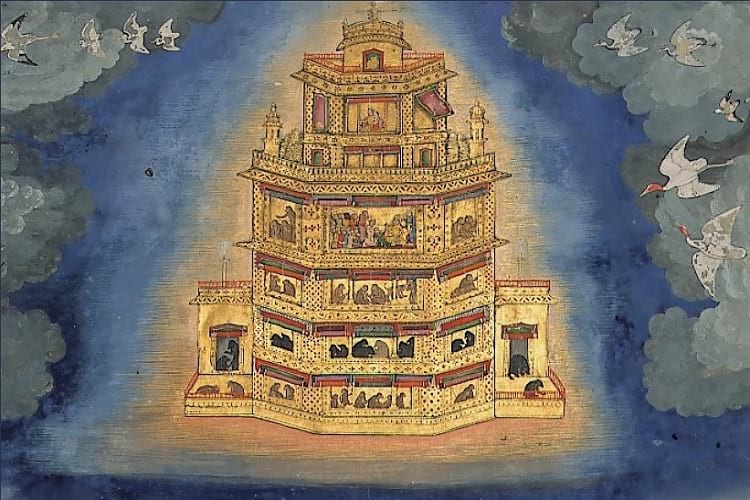
The Vaimanika Shastra is a Sanskrit text about ancient Indian flying machines or vimanas. While many ancient Indian scriptures mention vimanas and give elaborate descriptions of their workings, this is a more recent text that describes the ancient flying machines in detail. Yes, the Vaimānika Shāstra is not an ancient text. Or, at least, it is supposed to be by an ancient author, but comes to us through a modern medium. An Indian mystic Pandit Subbaraya Shastry claimed he had received the book as a divinity from the ancient sage Maharshi Bharadwaja and he then dictated it to his associate Shri G. Venkatachala Sharma. The dictation and transcription of the book lasted from 1918 to 1922. It was translated into Hindi in 1959 and into English in 1973.
The Vaimanika Shastra
Vaimanika Shastra means the science of aeronautics. To understand aeronautics, we need to understand aerodynamics, propulsive devices, materials, and metallurgy. In Vaimanika Shastra, there is much about propulsive devices, but next to nothing about aerodynamics.
The book’s focus is on the vimanas that were mentioned in many ancient epics like the Rigveda, Mahabharata, Ramayana, and others. According to the Vaimanika Shastra, these vimanas were not flights of fantasy of the ancient authors, but actual and aerodynamically viable flying machines. The ancient Indians not only knew how to fly, they also flew in highly sophisticated machines with many capabilities. Using mercury vortex engines, these vimanas could become motionless in mid-air and could make themselves invisible. When used in war, they could render the enemy forces unconscious and spy into the insides of enemy crafts.
The text includes information about piloting these vimanas and the aerial routes that could be taken. It mentions the food that could be eaten and the clothes that could be worn aboard the vimanas. It states the metals that were used to manufacture the vimanas and explains how these metals were produced. It describes mirrors fitted on the vimanas and their use in wars. It talks about different airplane machineries as well as different plant categories like mantrik, tantrik, and kritak. It also lists four planes – Shakuna, Sundara, Rukma, and Tripura – from the kritak category.
Origins of the Vaimanika Shastra
According to Pandit Subbaraya Shastry, Maharshi Bharadwaja is the real author of the work; it is indeed written as such. Apparently, Panditji was only the conduit for presenting the book to humankind. The verses would come to him in sudden flashes of inspiration and his associate Shri G. Venkatachala Sharma would then immediately transcribe them. This continued over a long period until the entire book was written. Sometime between 1900 and 1919, Panditji asked Ellappa, a draughtsman from an engineering college, to illustrate the manuscript with technical drawings of the vimanas.
Shri Shivkar Bapuji Talpade, who was a technical instructor at the J.J. School of Art in Bombay, became acquainted with Pandiji and created models of the planes with Panditji’s direction. He was unable to make them fly, however. Incidentally, Talpade was first modern Indian to build a flying machine that he named Marutsakha and flew on the Chowpatty beach in Bombay in 1895.
Panditji’s son, Shri Venkatrama Shastry, kept the original, illustrated manuscript after his father’s death in 1941, but Panditji’s followers distributed copies of the book amongst themselves and their circles. An Indian air force officer, Air Commander Goel, first read it in 1944, and apparently gave it to the Baroda University Library.
In 1951, a certain Shri Josyer founded the International Academy of Sanskrit Research and organized an exhibition of rare Sanskrit manuscripts at its inaugural event. Shri M.C. Krishnaswamy Iyengar, who knew Panditji, provided a copy of the Vaimanika Shastra for this exhibition and it generated a good deal of interest. Shri Josyer then contacted Shri Venkatrama Shastry and acquired the original manuscript. He translated it into English and made it available to the wider public.
Pandit Subbaraya Shastry
Pandit Subbaraya Shastry was born in Hosur taluka in Madras District in an impoverished family. He was married by the age of eight, as was the custom in those times, and several years afterwards, his parents died and the responsibility of supporting his many siblings fell upon his young shoulders. The only way he could do this was by begging. For a brief while, his father-in-law took in the family, but then they had to leave and fend for themselves once again. In these dire circumstances, they contracted smallpox and Panditji lost his sisters and one of his brothers to this disease. He himself became gravely ill and his surviving brothers abandoned him.
He would probably have died if he hadn’t been rescued and treated by a certain Guruji Maharaj near Kolar in Karnataka. Under the Guruji’s care, he recovered from the illness and took his first steps in the realms of spiritualism and mysticism. He never received any formal schooling, but learned to read and write Telugu and Kannada while he was with Guruji.
When he had completed recovered, he went to Anekal and lived there with his wife and the son they adopted some years later.
It should be mentioned that Panditji was an individual with an unassuming and unpretentious disposition. Over the years, he developed a wide circle of acquaintances, including the Indian scientist Jagdish Chandra Bose, and none of these people ever cast a doubt on his intrinsic sincerity.
He never took personal credit for the Vaimanika Shastra but insisted all the while that the real author was Maharshi Bharadwaja. He did not claim to understand the shlokas that he was divinely inspired to quote, nor did he claim to understand the practicalities of the flying machines in the Vaimanika Shastra.
The problems with the Vaimanika Shastra
While it would be a stretch to call Panditji a trickster or a charlatan – since he never showed any such traits in his entire life and the people who knew him appear to have regarded him with nothing but respect – there are several problems with the Vaimanika Shastra that cannot be disregarded. In the first place, if it had really been an ancient text, it would have used ancient Sanskrit. The text, however, is in modern Sanskrit with a sprinkling of ancient terms.
According to many aeronautic experts, there are several practical problems with the planes depicted in the Vaimanika Shastra. Let us look at some of the planes:
Shakuna Vimana
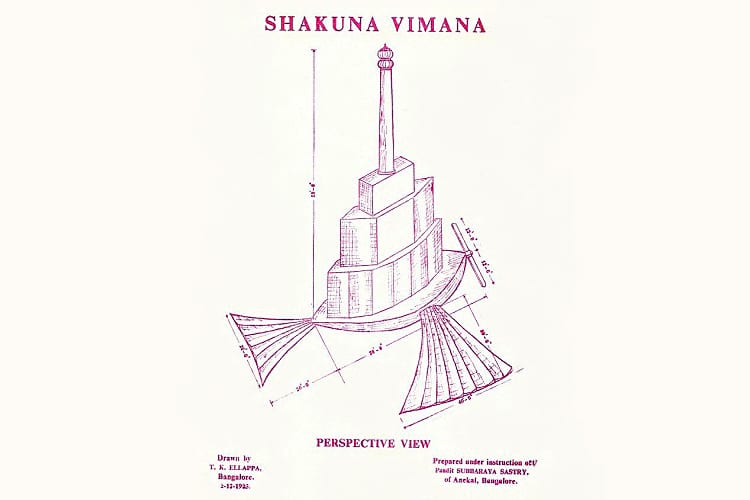
A reproduced page from Vaimanika Shastra of Shakuna Vahana. (T.K. Ellappa / Wikimedia Commons)
It is shaped like a bird and is made up of a floor board, a hollow mast, three hinges, four heaters, air suction pipes, heat engine, cylinder, piston gear, pumps, two wings, and one tail portion. The latter is apparently essential for lift-off. It is made of ‘raja loha’, an alloy made of several different materials, and has an 80-foot height and 56-foot length. The exact principles of operation are not mentioned, but the height and width dimensions of the vimana are likely to make it unstable.
Sundara Vimana
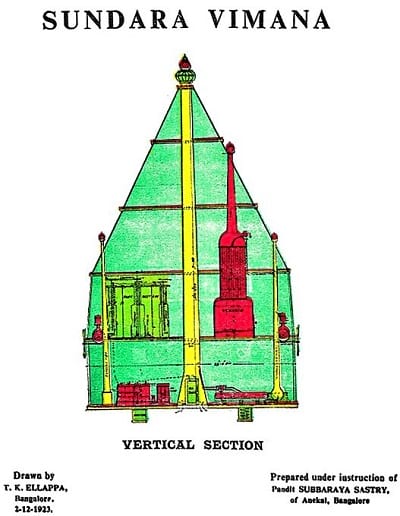
Section of Sundara Vimana. (T.K.Ellappa / Wikimedia Commons)
This is a cylindrical cone, three-tier vimana possessing a ground plate and an outer cover. It has a heater, an electricity generator, and five gas engines. There is also a metal pipe wind blower.
The electricity generator produces electricity by means of friction, heat, solar power, and water power; the text also mentions 16 ‘drona’ of donkey urine for electricity generation. The electricity vaporises oil. The vimana also generates steam. The steam and the oil vapor mix to produce 500 ‘kaksha’ heat which passes through a ‘shundala’ or elephant trunk pipe and creates propulsion forces.
The plane is supposed to lift off by sucking hot air from the bottom and releasing it from pipes at the top, which contradicts Newton’s Laws of Motion. If it manages to fly, however, it can, according to the text, cover 400 yojanas in one ghatika.
Rukma Vimana
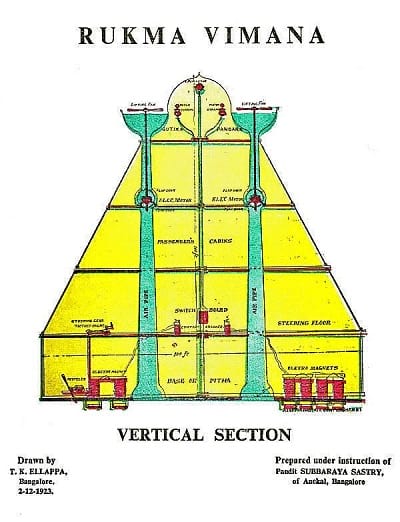
Vertical section of Rukma Vimana. (T.K.Ellappa / Wikimedia Commons)
A five-tier vimana, with passenger facilities on the third tier, the Rukma vimana comes in a cylinder cone shape, with a 100 or 1000-foot base dimension, a 20-foot height, and an 80-foot cone height. It is made of raja loha and various other materials and has electrical tube wheels and lifting fans. Its power generator operates on solar power. It can attain a speed of 105 krosha per ghatika.
Tripura Vimana
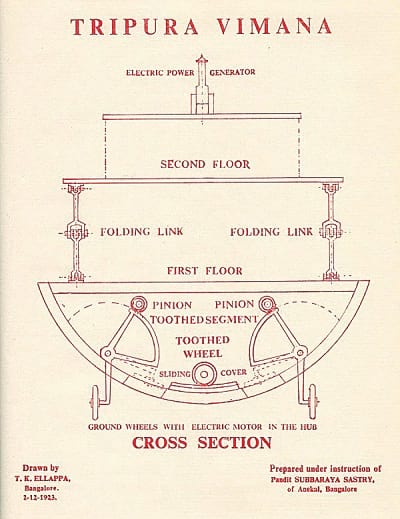
Vertical section of Tripura Vimana. (T.K.Ellappa / Wikimedia Commons)
Along with flying in the air, the Tripura vimana can move on land and water. It has wheels for land travel and these wheels are retracted when it moves in the water. The text does not provide its exact operational principles, but its power generator utilizes solar energy. It is an oval-shaped vimana, with a 100-foot length, 24-foot width, and 30-foot height. It is made of a light, fire resistant alloy.
So, can the Vimanas fly?
The researchers from the Indian Institute of Science in Bangalore, who carried out a study of the Vaimanika Shastra in 1974, expressed scepticism about the flying abilities of these planes. According to them, the geometries and the propulsion principles of the planes are too bizarre to make flying a possibility. At least, not by any currently known flying methods. Who knows, maybe the ancient Indians had advanced methods that we haven’t yet discovered. It is a pity that these weren’t clearly delineated in the text of the Vaimanika Shastra.
The Vaimanika Shastra in popular culture
In 1878, Dayananda Saraswati wrote a commentary on the Rigveda, which was published in 1929 as “Rigveda Bhashya Bhumika”. In this, he describes how flying machines operate and these descriptions are more in line with Newton’s Law of Motions.
In January 2015, the Vaimanika Shastra was mentioned in presentations made by a pilot Anand J. Bodas and Ameya Jadhav, a researcher with an M.Tech and an M.A. in Sanskrit at the 102nd Indian Science Congress at the Mumbai University. Shri Bodas informed the news media that, in Vedic times, huge-sized vimanas could fly in a variety of modes from country to country as well from planet to planet. This declaration riled the NASA scientist, Ram Prasad Gandhiraman, and he started an online petition to throw out this ‘pseudo-science’ presentation.
The Vaimanika Shastra is mentioned in ‘Prapaatha’, a 2015 Kannada film, and in ‘Hawaizaada’, a 2015 Hindi film.
Enrico Baccarini, an Italian journalist, has written several articles and books on ancient Indian vimanas.
Enjoyed this article? Also, check out “The Curious Disappearance of the Baghdad Battery: A Parthian Period Relic, An Oopart“.
Fact Analysis:
STSTW Media strives to deliver accurate information through careful research. However, things can go wrong. If you find the above article inaccurate or biased, please let us know at [email protected].
RELATED
The post Vaimanika Shastra – Treatise on Ancient Indian Flying Machines or Pseudoscience? appeared first on .
]]>The post Battle of Saragarhi: When 21 Valiant Indian Soldiers Held Their Ground, Fiercely Fighting Against Thousands of Afghans appeared first on .
]]>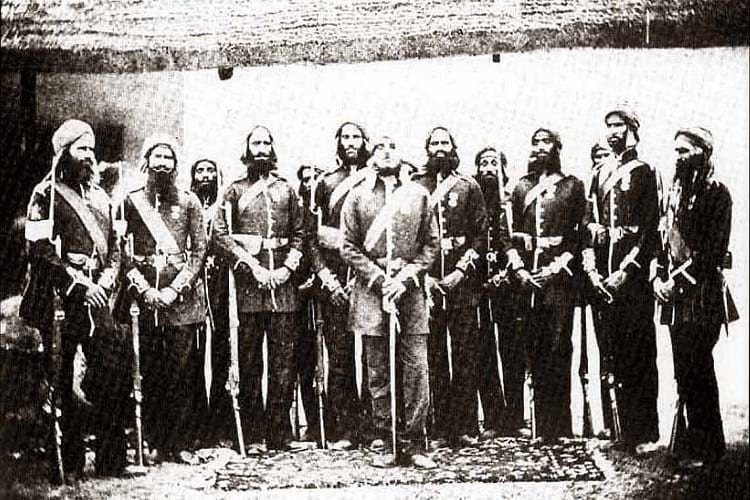
Battle of Saragarhi: Members of the 11th Sikh Regiment of the British Indian Army. (Profitoftruth85 / Wikimedia Commons)
India is an independent nation and also the largest democracy in the world. But before she became a sovereign state, a lot of battles have been fought on her soil to achieve freedom. One such heroic saga of undaunted bravery and unmatched courage dates back to the year 1897. The Battle of Saragarhi, named after the village of Saragarhi, was an epic act of valour in the history of India that fills every Indian with a deep sense of veneration and great pride.
When Afridis rose in rebellion at Tirah Campaign
Between the years 1897-1898, India was under the British rule and Pakistan had yet to become a separate state. The government of British India had given the Afridi tribe (of Pakistan) subsidy to safeguard the Khyber Pass – a mountainous pass, which borders between Pakistan and Afghanistan. The government had also assigned the local Afridis occupation of the Pass to defend the nation when the time came. However, as misfortune had it, they rose in rebellion together with their tribesmen, along with the Pashtun Orakzais (basically from Afghanistan) and intruded Tirah Expedition. But the bloodbath at the Battle of Saragarhi was only the precursor to the Tirah Campaign, fought at the North-West Frontier Province, which is now officially occupied by tribal Pakistanis.

Afridi tribe, 1866. (Library of Congress)
Saragarhi and the 36th Sikhs of the British Indian Army
Just a month before the Afridis and Orakzais infiltrated the Tirah Campaign, in September, 1897, the Pashtun Orakzais waged war with the British Indian Army, leaving a bloody trail in its wake. In the North-West Frontier Province, modern-day Pakistani Province, more than 10,000 Afghani tribesmen fought with only twenty-one Sikh soldiers, who did not leave the battlefield, despite knowing that their fates were already sealed. The 36th Regiment of the British Indian Army, also known as the 36th Sikhs (now known as the 4th Battalion of Sikh Regiment of the Indian Army), were posted at Saragarhi, who did not know what destiny had in store for them, early in the morning of September 12.
Part of British India back then, Saragarhi was an outpost located between Fort Lockhart and Fort Cavagnari. It acted as a communication outpost that relayed messages between the two British forts by means of heliography. On 12th of September, Havildar Ishar Singh and Gurmukh Singh observed that the Pashtun Orakzai tribesmen were heading towards Saragarhi in the thousands, to make way ahead to Fort Lockhart. Gurmukh Singh, who was the signalman, immediately sent a message to the commanding officer Lieutenant Colonel John Haughton at Lockhart. Not prepared for a siege, they expected help to come in from all corners. But Lt. Col. Haughton requested them to hold their positions until reinforcement could be summoned. Havildar Ishar Singh and his men complied with the orders and prepared for what lay ahead.
The Battle of Saragarhi
As the Pathans marched forward towards Saragarhi, the twenty-one men at the outpost, who only acted as messengers, knew the time had come for them to rise to the occasion. They held the ground and tried to delay the enemy from infiltrating further towards the next outpost, but it was obvious they had been clearly outnumbered. The enemy came in the thousands. Not sure exactly how many Pashtun Orakzais were in the enemy camp, but records state there could have been approximately between ten to fourteen to even twenty thousands of them. And these Afghani men were challenged by only a handful of gallant Sikh soldiers of the British Indian Army.
By now it was clear that one Sikh soldier had to take on at least 500 Afghanis, but there was another hitch. Each soldier had 400 rounds of ammo for their 4.5 kg Martini-Henry, which meant they couldn’t just rely on firepower alone. They tried to fight off the over ten thousand Afghani enemies for hours but were heavily under assault. As the Orakzais attacked, they received stiff competition from the 36th Sikhs and as many as sixty of their men were killed. They launched a second attack, but it was thwarted again by the Sikh soldiers. By noon, one British Indian soldier had died fighting and another left wounded. Gurmukh Singh forwarded the message to the Lockhart Fort but Lt. Col. Haughton’s back up had yet to come.
Defeated the second round too, the Pathans then set the nearby bushes ablaze hoping to ambush the Sikh soldiers inside, by camouflaging themselves, but the defenders had not admitted defeat yet. Another Sikh soldier was charred to death, trying to protect the guard door. It was only when the enemy had begun getting inside that Havildar Ishar Singh decided to engage in a hand-to-hand combat instead of wasting precious ammunition. But then it had been too late.
The Pathans had breached the Saragarhi outpost and there was very little that Havildar Ishar Singh or anybody else could do. Gurmukh Singh, who had requested to get into action instead of only relaying messages, also died fighting. Ishar Singh fought till the very end, mortally wounded at that time. However, the twenty-one brave Sikh soldiers did not let down their lives for nothing. Despite no backup in sight, they decided to take on the enemy in the thousands and heroically took down more than six hundred of them. Historians are still of the opinion that Havildar Ishar Singh’s brave act of heroic courage in the face of adversity, is one of history’s most supreme military last-stands.
The delay tactic had worked in the martyrs’ favour and Lt. Col. Haughton could buy enough time to muster reinforcement in the next two days, which finally worked at Lockhart. All the 21 brave soldiers with unprecedented courage were posthumously awarded the Indian Order of Merit, which in today’s times, is equivalent to the Param Vir Chakra. Also, September 12 is observed as Saragarhi Day in memory of the bravehearts with unflinching guts who stood their ground.
Not part of folklore or fiction, the Battle of Saragarhi was truly an act of valiance that 21 mighty Sikh soldiers put up in defence And to pay homage, literary works and pop culture have narrations of this gallantry in great detail. Karan Johar’s Dharma Productions is all set to produce an upcoming movie titled ‘Kesari’, which will be directed by Anurag Singh. Featuring Akshay Kumar in the lead as Havildar Ishar Singh, the movie will be a fictionalized account of the factual Battle of Saragarhi, which is truly the greatest example of rare Indian heroism.
Enjoyed this article? Also, check out “The Tragedy of Jallianwala Bagh“.
Fact Analysis:
STSTW Media strives to deliver accurate information through careful research. However, things can go wrong. If you find the above article inaccurate or biased, please let us know at [email protected].
RELATED
The post Battle of Saragarhi: When 21 Valiant Indian Soldiers Held Their Ground, Fiercely Fighting Against Thousands of Afghans appeared first on .
]]>The post Dhanushkodi: Where a Cyclone Ripped Apart an Entire South Indian Town, Rendering it Uninhabited appeared first on .
]]>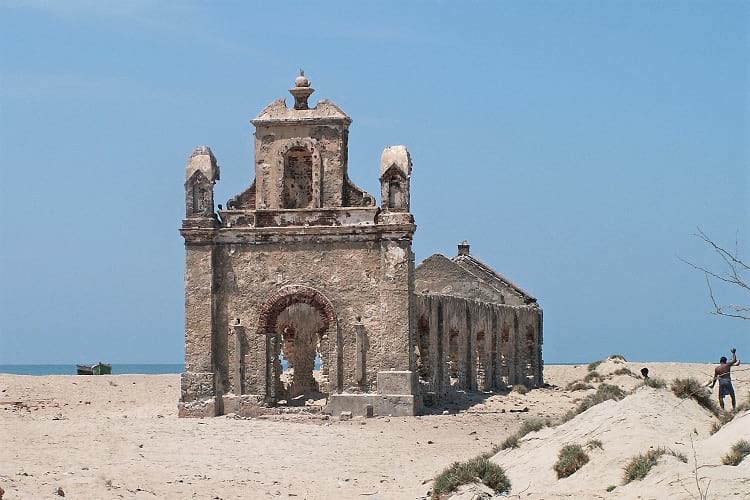
Church ruin at Dhanushkodi. (Clt13 / Wikimedia Commons)
The people who were in Dhanushkodi on the night of 22 December 1964 would never forget it as long as they live. On this night, a sudden cyclone from the South Andaman Sea, blown in by tremendous winds of velocities of 250 kilometres per hour and accompanied by 23 feet high tidal waves smashed into the town and destroyed it.
In one night, the entire town was wiped out and parts of it submerged as the sea rushed three kilometres inland. Over 1,800 people perished in the cyclone and the town was never rebuilt. The government of Madras declared it a ghost town; that is, a place not fit to live in.
Dhanushkodi: The town that was never rebuilt
Dhanushkodi is located on the south-eastern tip of Pamban Island in Tamil Nadu (state of India), about 20 km from Rameswaram (town). Its pristine beaches overlook the narrow Palk Strait that separates India and Sri Lanka – Sri Lanka is only about 30 km away – and it shares the only land border between the two nations. The town also watches over the confluence of the Indian Ocean and the Bay of Bengal. If you stand on the beach and look seawards, you can clearly see the green turbulent waters of the Indian Ocean on the right and the calm, blue waters of the Bay of Bengal on the left. It is almost as though this were an indication of the town itself, a place with a turbulent past and an almost eerily calm present.
The history of Dhanushkodi goes back to mythological times. The name Dhanushkodi can be broken up into two words: Dhanush, which means bow, and Kodi, which means end. So, Dhanushkodi means bow’s end. Whose bow though? Well, Lord Rama’s bow of the Hindu Epic, Ramayana. He pointed his bow end at Dhanushkodi twice. Once to indicate that this was where he, his brother Lakshmana, and their allies, Vibhishana, Hanuman, and the Vanar Sena were going to start building the Ram Sethu from, connecting Bharatvarsha to Lanka to rescue his abducted wife, Sita, from the clutches of the Rakshasa King Ravana. The second time was on his victorious return from Lanka, when, on Vibhishana’s urging, he used his bow end to destroy the bridge that they had just crossed on the journey back.
The nearby Kothandaramar temple, which is surrounded by the sea on three sides, also has a relation to Lord Rama. It was here that Lord Rama, having killed Ravana, crowned his younger brother Vibhishana as the next King of the Rakshasas.
Due to these associations with the Ramayana, the Hindus of India consider Dhanushkodi a holy town and frequent it on pilgrimages.
The Ram Sethu, incidentally, is also called Adam’s Bridge. It is clearly visible in the aerial view, remote sensing photographs that NASA astronauts took from space, and, according to NASA, it is a formation of naturally occurring sandbanks and not the mythological manmade bridge of floating stones. It is not unique, there are many such sandbank formations around the world. The public sentiment in India, however, is not going to be swayed anytime soon by NASA’s rebuttal. For centuries, we have called it the Ram Sethu bridge and we will continue to call it the Ram Sethu bridge. According to the local fishermen of Dhanushkodi, what remained of the Ram Sethu after Lord Rama destroyed it, was swept away by a cyclone in the 15th century. Like Dhanushkodi, it was never rebuilt.
Dhanushkodi in the British Raj
Dhanushkodi was quite a prosperous town during the British Raj. It was an important port town and the British used it to ship tea, spices, and other goods from India and Sri Lanka, then called Ceylon, to Europe. There was a regular ferry service between the town and Talaimannar on Mannar island in Sri Lanka. Dhanushkodi was also connected by railway to various parts of India. The Boat Mail train regularly came to Dhanuskkodi from Madras Egmore to let off passengers on Dhanushkodi’s southeastern side, from where many of them took the steamer to Sri Lanka. The town had a hospital, a school, a post office, a church, a railway station, customs and port (or post) offices, hotels and dharmshalas, textile shops, and all the other amenities that a flourishing town has.

Dhanushkodi old railway station. (D Kartikeyan / Wikimedia Commons)
The night of the cyclone
The cyclone had been brewing for a while. It began with a depression in the South Andaman Sea on 17 December 1964 and it gathered force and moved landwards. The people of Dhanushkodi were caught unawares.
On the night of 22 December 1964, as the cyclone was about to strike Dhanushkodi, the Pamban-Dhanushkodi Passenger, a six-coach train that provided a daily commuter service between Pamban and Dhanushkodi, was nearing Dhanushkodi railway station. It was the last train of the day and there were 110 passengers on board this train, along with five railway staff members. As it approached Dhanushkodi, the driver did not see the expected signal in the pitch darkness of the night, and he blew a long, piercing whistle. At that juncture, the cyclone struck. An enormous tidal wave crashed into the train and flung it as if it were a toy into the roiling sea and destroyed the Pamban bridge. There were no survivors on the train.
Dhanushkodi itself was devastated, with heavy loss of human life and a near complete destruction of all the town buildings. Parts of the town went under water and those that remained above water level were isolated from one another.

Buildings devastated during 1964 cyclone. (Shubham Gupta / Wikimedia Commons)
The storm continued unabated until the evening of 25 December 1964. The outside world remained unaware of what had happened in Dhanushkodi as it was impossible to establish any kind of contact until the storm had blown over.
The aftermath of the cyclone
After the devastation wrought by the cyclone, the coastguard evacuated the survivors and what remained of the town was abandoned. As mentioned earlier, the Madras government declared the town to be a ghost town and, except for some fishermen whose livelihood depended on the sea and who therefore stayed put, the rest of the surviving inhabitants of the town left and did not ever return. The parts of the town that the sea had claimed remained submerged underwater. According to the locals, these submerged parts were briefly revealed in the 2004 tsunami when the sea receded some 1,600 feet before rushing back in and reclaiming the town.
The railway links to Dhanushkodi, which once had railway connections to different parts of the country, were entirely destroyed and never restored. Since the town was now abandoned, the government cut off the electricity and water supply as well.
Dhanuskodi today
Apart from the ruins of the town’s stone buildings, there are no other buildings in Dhanushkodi. The fishermen and their families, numbering around 500, who remained put, live in ramshackle with no electricity and running water. The fishermen eke out a meagre livelihood with their fishing and their wives collect water from springs that they claim came into being after Lord Ram shot an arrow into the ground.

Tourist at Dhanushkodi. (D Kartikeyan / Wikimedia Commons)
Until 2017, Dhanushkodi remained an isolated, nearly forgotten place. It was frequented mainly by tourists looking for a back of beyond destination and determined religious pilgrims. The main reason for this isolation was the difficulty in reaching the town. The railway connection was gone and there was no bus service. If you wanted to get to the town, you had to take a bus from Rameswaram to a village some 4 km away and then hire a van there for a rather pricey sum to take you the remainder of the way to the site.
When you reached the erstwhile town, there was nothing to do at Dhanushkodi. You might walk about amidst the stone ruins of the church, the post office, the medical college, the railway station, the hospital, the water tank, the school, and the other still-standing structures. Or you might gaze wide-eyed at the surpassing beauty of the pristine beaches, the green-blue sea, and the deep-blue sky.

Ruins of post office and hospital. (Mike Prince / Wikimedia Commons)
After a few hours, the waiting van would summon you for the return journey. Nobody can remain in Dhanushkodi after 6 p.m.
In 2014, the Indian government decided to connect Dhanushkodi to Rameswaram with a tar road. This was ostensibly done to improve a lot of the impoverished fishermen. The road connection was completed in 2017 and now you can drive right up to the former town.
Even so, the place retains its almost otherworldly charm. If you can, visit Dhanushkodi early in the morning and spend an entire day on the beach. If you are lucky, you will get an entire isolated stretch of beach to yourself. Wade into the shallows and watch a breathtakingly beautiful sunrise. Walk on the soft sand until you are tired and then lay back to gaze up at the sky and listen to the music of the rolling waves. You will feel completely unconnected from the world and completely at peace.
What one gets from Dhanushkodi is a story of human resilience and a warning to not underestimate the might of nature. We remain at the mercy of natural forces like all living creatures on this planet. With one sweep, we could lose everything.
Enjoyed this article? Also, check out “The Disappearing Aral Sea and its Abandoned Ships“.
Fact Analysis:
STSTW Media strives to deliver accurate information through careful research. However, things can go wrong. If you find the above article inaccurate or biased, please let us know at [email protected].
RELATED
The post Dhanushkodi: Where a Cyclone Ripped Apart an Entire South Indian Town, Rendering it Uninhabited appeared first on .
]]>The post Green Boots: Dead Climbers Not Brought Back from Mount Everest Now Serve as Milestones appeared first on .
]]>
The body of a dead Mount Everest climber, which is now referred to as Green Boots. (Maxwelljo40 / Wikimedia Commons)
The fascination that Mount Everest offers to climbers comes at a price. There is always a lurking danger of one falling to eerie depths, dying from lack of oxygen or a fatal hit by boulders falling. There is also a possibility that dead bodies may not be brought back for last rites in view of harsh weather. Yet Mountaineering goes on with unabated fervour and enthusiasm. Dead bodies that stay put where they fall become beacon lights to guide climbers. The mortal remains become milestones telling climbers the altitude on their way to Mount Everest. Some 200 such bodies stay put on the Himalayas and act as a guidepost for the intrepid mountaineers of future.
The story of Green Boots
‘Green Boots’ used to be a popular milestone on the way to the summit. These were green coloured shoes purportedly worn by an Indian climber named Tsewang Paljor. He was part of an expedition in 1996 which had only one survivor, Harbhajan Singh. Sensing imminent danger, Singh had urged his three colleagues, including Paljor, to give up and turn back to camp. But the team ignored him and reached the summit. However, on return, they fell to blizzard and zero visibility. Paljor’s body lay frozen near a cave, his green shoes being most conspicuous of all remains. Hence the name, Green Boots. In 2014, Green Boots, like many other fallen climbers, were reverentially dropped on the lee side of the mountain.
Upon passing Green Boots, mountaineers enter ‘death zone’, the top end of the Himalayas, almost 26,000 feet above the sea level. It has only one-third of oxygen compared to plains. This, coupled with high atmospheric pressure makes the death zone extremely hard for climbers. They feel numb, tired, disoriented and can barely thrive beyond two days. No wonder, the mountaineering protocol prescribes leaving the dead on ground zero rather than risk more lives in rescue and recovery. Where survival of self is a grim challenge in itself, saving others would naturally be a second priority.
The tragic death of David Sharp
Another mountaineer, David Sharp had joined Green Boots at the same cave. Making a solo attempt against peer advice did him in. He sat at cave distressed and frostbitten and died with head resting on his bent knees. Unlike Green Boots, he was lucky enough to be seen alive by at least 40 people, but none helped. Sharp’s death triggered a wide-ranging debate on whether mountaineering was all about reaching the summit and neglecting comrades in danger. Sir Edmund Hillary, the first man to summit Everest criticized climbers for ignoring David Sharp. Calling such an apathy ‘horrifying’, he emphasised that a colleague must be helped even if it meant cancelling expedition. The mad rush to reach to the top (summit fever) regardless of the wellbeing of fellow climber was widely condemned. On the flip side though there were salvos saying climbers may have confused David for Green Boots. And that, some mountaineers did indeed try to help him but gave up on finding that his condition was too precarious to be restored to normal.

Aerial photo of Mount Everest. (shrimpo1967 / Flickr)
Death of other prominent climbers
With nearly 200 deaths, and many bodies still lying in the mountain range, Himalaya has acquired a dubious distinction of being the world’s largest open-air graveyard. After first ever conquest of Everest by Edmund Hillary and Tenzing Norgay in 1953, over 4000 mountaineers have tried to scale the mountain, braving harsh climate and daunting terrain of death zone; all for tasting the glory of reaching world’s highest summit. Some of them never came back and became part of the mountain body, preserved in ice.
Hannelore Schmatz’s story is another one of this trail. She reached the peak in 1979 but died on her way down. The first woman and the first German citizen to scale Mount Everest, she was warned by her Sherpa not to set up camp in the death zone. But she did and braved snowstorm during the night. However, just 330 feet short of base camp, she fell down exhausted, never to get up again. Her body remained well preserved in sub-zero temperatures on the southern route. Resting against withered backpack, eyes open and hair blowing in wind, the corpse was subsequently pushed off the mountain by strong winds.
Why are the dead bodies not retrieved?
Horrendous weather conditions on Everest, especially in the death zone, make it almost impossible to retrieve a dead body. Lack of oxygen and treacherous terrains make the task all the more formidable. Bodies when found, are seen inextricably merged with the frozen ground. The same factors which kill mountaineers, make it difficult for the rescue team to help the needy. Rescue operations may, in fact, add to the overall tragedy. Two rescuers died while trying to recover Hannelore Schmatz’s body, the lady mountaineer from Germany. Many lives were lost in the process of helping out distressed climbers. Like Sergei trying to save his wife Francys Arsentiev, and both losing their lives in 1998. Their team tried hard to save the lady but gave up on realising it was impossible. Her husband Sergei though persisted with the ominous result. Marker role of Francys Arsentiev on snowy terrain ended in 2007 as her mortal remains were reverently shoved to a lower face of the mountain.
As long as the mountains are there, to paraphrase George Mallory differently, Mountaineers will keep climbing them regardless of dangers to their life. The show, as they say, must go on.
Enjoyed this article? Also, check out “Roopkund Lake: What are Hundreds of Bones Doing Around a Lake in Uttarakhand?“.
Optional Visit:
Mount Everest | Mountain in Asia
Fact Analysis:
STSTW Media strives to deliver accurate information through careful research. However, things can go wrong. If you find the above article inaccurate or biased, please let us know at [email protected].
RELATED
The post Green Boots: Dead Climbers Not Brought Back from Mount Everest Now Serve as Milestones appeared first on .
]]>The post North Sentinel Island: Home to an Uncontacted, Hostile and Primitive Tribe appeared first on .
]]>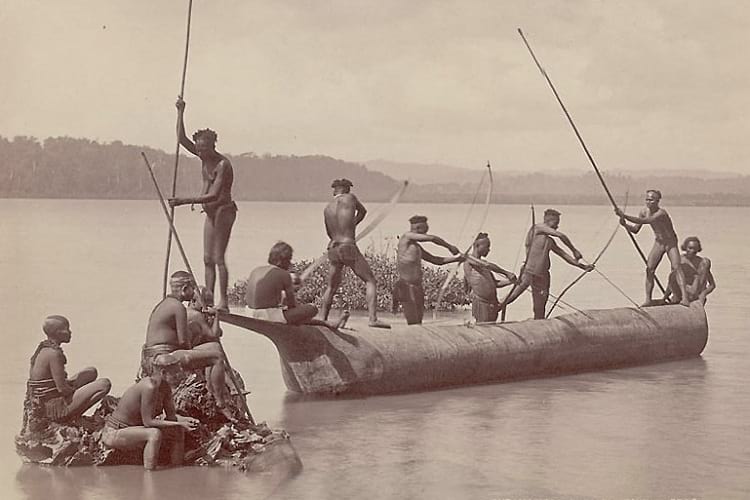
Sentinelese people catching sea turtles, 1903. (Smithsonian Institution / National Anthropological Archives: NM 40922 04421302)
The North Sentinel Island in the Andamans is currently in the news for all the wrong reasons. Located in the Indian Ocean, this island is where the Sentinelese tribe resides, which is an ethnic group of the last uncontacted people to ever live in the world. Not wanting to establish any contact with the outside world, this secluded tribe wishes to be left alone. But what is so special about these islanders, which has suddenly put them under the spotlight, making waves across the globe?
History of the Sentinelese tribe and North Sentinel Island
Situated in the Andaman Islands, a part of the Indian union territory of Andaman and Nicobar, the North Sentinel Island lies far off in southeastern Bay of Bengal. It is roughly a small, square-shaped remote island, which is covered with dense forests and flanked by coral reefs in abundance. It is said that the Sentinelese tribe has been living on this island for more than 60,000 years, without attempting to contact the outside world ever since. Speaking their own Sentinelese language, these indigenous people are said to have descended from the Negrito race, which though are closely related to the African tribes, are quite distinct in their genetic makeup. Standing approximately five feet, five inches tall, these dark-skinned aborigines could possibly have been the first Africans to set foot on the North Sentinel Island thousands of years ago.

Aerial photo of North Sentinel Island. (Medici82 / Wikimedia Commons)
As per the Indian Government Census, the Sentinelese tribesmen are said to be an off-shoot of the more forthcoming Jarawa-Onge tribe (also from the Andaman Islands), but their self-imposed isolation over all these years indicates that they could be an ethnic group in themselves, with their own special ways and means to communicate with each other. The natives often turn hostile and turn away people, who try to make their way inside their protected land, hoping to interact with them. Still using bows and arrows to hunt and kill, it is believed that these Stone Age hunter-gatherers might surprisingly not be able to make fire till date.
The way of life of Sentinelese people
They rely heavily on fish and coconuts for food and as per government bodies that keep an eye out on them, no case of consuming human flesh has ever been reported on the island so far, implying that the Sentinelese do not practice cannibalism. They fish in the shallow waters in narrow canoes and live in houses, sizes of which depend on the number of family members. The Sentinelese make use of metals washed ashore from shipwrecks in order to make spears and tips of arrows for hunting. The women tie strings of fibre around their waist, neck and head, while men wear thicker waist belts, along with necklaces and sometimes headgears. They are even said to apply a yellow paste all over their bodies.

The Jangli hut at Rutland Island, a very similar structure to that used by the Sentinelese people. (Maurice Vidal Portman / Wikimedia Commons)
Having cut themselves off from any form of foreign contact for all these years, the aboriginals are susceptible to several common viruses, including fever, cough and cold and the slightest contact from an outsider could wipe off their entire population. Since they do not allow foreigners to step on their tiny island, reacting with resentment to any possibility, the exact number of tribals actually living on the island is unclear. However, as per the Indian Census of 2011, the population of Sentinelese could be anywhere between 50 and 150.
Indian Government rules, regulations and laws regarding the Sentinelese
In the year 1967, with the help of Indian anthropologist Trilok N. Pandit, the Government of India tried to initiate contact with the Sentinelese people, offering a hand of friendship and leaving gifts for them. But they were turned away with humiliation. In 1970, an attempt to contact them was thwarted again, this time, with much hostility and embarrassment from the tribal women.
The last known contact with these indigenous people was back in 1996, after which the government left them as is. Despite being let down previously, the Government of India tried to assess their situation post the Indian Ocean tsunami of 2004 from afar, but the Coast Guards’ helicopters were shot with a volley of arrows and spears and were driven away forcefully. In 2006, two fishermen, who had inadvertently drifted too far away towards the North Sentinel Island, were killed mercilessly at the hands of this primeval ethnic tribe.

A Sentinel shooting an arrow at the helicopter. (Mr Minton / Flickr)
The Government of India has since been very particular about the Sentinelese, leaving them the way they are. The tribe is protected under the Indian law and it is a criminal offence to enter within a 5 kilometre radius of the island. The government only monitors the activities of the primitive islanders from a distance, never going too close to the island. The strict laws even necessitate a ban on tourists trying to venture far off into the North Sentinel Island, while the tribal people are never prosecuted for killing non-Sentinelese people. Under the Section 8 of The Andaman and Nicobar (Protection of Aboriginal Tribes) Regulation of 1956, and Amendment of 2012, provisions for stringent punishment, including a jail term of up to 3 and 7 years and fine have been made for exploitation of tribal communities in the Andaman and Nicobar Islands.

Communal huts made by Andamanese people, people of a similar indigenous ethnic group and living in the close proximity of the Sentinelese people, ca. 1886. (Edward Horace Man / Wikimedia Commons)
The recent event at the North Sentinel Island
While there have been several previous misfortunes occurring at the North Sentinel Island, with the Sentinelese tribesmen executing those trying to intrude, one incident has particularly rocked the world recently. A 26-year-old American evangelist, John Allen Chau, who wished to spread the word of God and convert the Sentinelese, visited the island thrice before he was killed with arrows, meeting a tragic end. Having visited the island before in 2015 and 2016, the interloper missionary, who was also an adventurer and international soccer coach, illegally travelled to the island, with the help of local fishermen and ventured inside, recording his entire journey, eventually getting killed by the unreceptive Sentinelese on November 22, 2018.

Distribution of indigenous and no-indigenous settlements at Andaman islands. (CJLL Wright / Wikimedia Commons)
Other uncontacted tribes in the world
An NGO – Survival International – a global human rights organization formed in 1969, campaigns for the rights of the uncontacted and indigenous tribes all over the world. As per its survey, there are as many as 100 uncontacted ethnic tribes in the world, out of which 77 live in Brazil alone. A tribe from Rondonia, Brazil, has only a lone man left, who has resisted contact from the outside world. He is popularly known as the ‘Last of his Tribe’. Another uncontacted tribe is the Awa in Brazil, which is the most endangered tribe in the world due to settlers returning to colonize their land. The members of this group remain hidden most of the time during the day and hunt monkeys at night.
The few dozen people of Kawahiva make up another tribe, the members of which are constantly on the run, for fear of losing their land to deforestation and lumbering activities in their region. The native people of the Mashco-Piro tribe are hunter-gatherers who have actively shunned outside contact and live deep inside the Amazon rainforest. The tribal people from Brazil’s Acre rainforest area are nomadic people, who face severe threat of extinction due to the illegal logging businesses and the diseases the lumberjacks bring in with them. Apart from these Brazilian tribes, there are the ethnic groups of New Guinea, living in the dense jungles. Indonesia is also home to some 40 odd indigenous groups, along with some more in Congo, Botswana, and some in Peru too.

2009: Sightings of isolated people in Acre, Brazil. (Gleilson Miranda / Secretaria de Comunicação do Estado do Acre)
Even though the Sentinelese continue to make news headlines every day after the death of the Christian missionary, they have managed to remain untouched from the impact of modernization in the 21st century. Their seclusion and constant prehistoric ways of living baffles us and they remain a mystery and subject of great intrigue, answering our pressing questions that there still exists a world where civilizations live in ways, man left behind millenniums ago.
Enjoyed this article? Also, check out “Juana Maria: The Isolated Woman of the Remote San Nicolas Island“.
Recommended Watch:
A Blank in the Map | A BBC Documentary presented by Sir David Attenborough
Fact Analysis:
STSTW Media strives to deliver accurate information through careful research. However, things can go wrong. If you find the above article inaccurate or biased, please let us know at [email protected].
RELATED
The post North Sentinel Island: Home to an Uncontacted, Hostile and Primitive Tribe appeared first on .
]]>The post Water Wives of India: Denganmal in Maharashtra, Where Men Have Multiple Wives to Fetch Water appeared first on .
]]>
An Indian women carrying water taken from a well. (Dylan Walters / Flickr)
Water is a basic necessity and one of the most important elements present on Earth. However, every continent today is facing water scarcity in some form or other during a certain period each year.
Many people all over the world do not have access to clean drinking water and sometimes, even water. This situation is seen, year after year, in drought-hit areas of India. Maharashtra is one of the states in the country where several districts experience drought, every year. One village came up with an unusual solution to the shortage of water – indulging in polygamy. Having more than one wife to procure water, termed as the ‘water wives’.
The tradition of ‘water wives’
A small village in the western province of Maharashtra, Denganmal, is a parched land surrounded by rocky terrain. With a population of roughly 500, the village has no water pipeline connections. Add to it the fact that it lies in the region which experiences drought in the hot summer months.
Cut off from other villages, the only source of water available to the villagers is the Bhatsa dam on a river or a well. Both are situated so far away that, a to-and-fro journey takes nearly 12 hours. Not only is the trip arduous and long, but also time-consuming, leaving little or no time for other chores.
Most men of this village, are farmers or farm hands. With the men away from home the entire day, all household chores fall upon the woman. Taking care of children, cleaning, cooking, and other everyday jobs become impossible to attend to by the women if fetching water takes up most of their day. Moreover, the women and children are also expected to help out in the farms during the cropping season, July to October. This led to the most convenient solution at hand, marrying another woman whose sole responsibility is to fetch water for the entire family. Hence the term, ‘water wives’ or, as they are more commonly referred to, ‘paani bai’.
The exigent life of a ‘paani bai’: boon or bane?
As per the government’s estimate, more than 19,000 villages in Maharashtra did not have any access to water in 2014. Each year, the situation only gets worse. In 2018, Maharashtra Chief Minister Devendra Fadnavis in his Independence Day speech claimed that the state government had successfully made 16,000 villages drought free out of 25,000 villages. Having achieved this under the Jalyukt Shivar Abhiyaan (farm full of water scheme), Maharashtra will be drought-free by 2019, according to him.
Meanwhile, people of this small village have chosen the ‘paani bais’ to resolve their problem of water scarcity. The water wives leave at sunrise, trudging through the rocky terrain, through the hills, to the river or well; all this in the smouldering heat of summer. Each vessel holds 15 litres of water and each woman carries 2 to 3 such vessels.
The first wife is the lady of the house who shoulders the responsibility of bearing children, taking care of their needs, other household chores and duties. Whereas, the water wife is often, either a widow or, an unmarried woman whose dowry could not be afforded by her family. These women lead an ostracized life in the Indian society, discriminated and not allowed to participate in social norms. By becoming water wives, they regain their marital status and are accepted as a part of the society, again. Whether it is a boon for them or not, is something that does not cross their minds, as long as they are provided for and accepted in the family.
A tale of three wives
The largest family in the village is of Sakharam Bhagat. Along with his first wife Tuki, he has six children, three sons and three daughters. Quite evidently, it became increasingly difficult for Tuki to manage the water procurement with a growing family. Being away from home and children for 12 hours a day was definitely not feasible.
Sakharam approached Sakhri, who had been deserted by her husband. The arrangement being that in lieu of a respectful marital status and her needs taken care of, Sakhri would fetch water for the family.
Sakhri would diligently traverse the distance to ensure there was sufficient water every day, for the household. Being a part of a large family of 9 people, there were days when she was getting nearly 100 litres of water in one day. Unfortunately, age began to take its toll on Sakhri and she gradually found it difficult to execute her daily water task. Sakharam decided to take in a third wife, a young widow of 26, Bhaagi, became a part of the household as a water wife, and Sakhri started helping out on the farm.
The village panchayat saw no reason to object as it meant the start of a normal respectful life for the two women who had otherwise been cut off from society. Moreover, Sakharam was not the only man to have more than one wife. There were others in the village who were known to indulge in the practice of a ‘paani bai’. Though she is looked after by the husband and his family, she has no share in his property.
The one thing that keeps an unusual family like this, together, is water.
Enjoyed this article? Also, check out “The History of Breast Tax and the Revolt of Lower Cast Women in 19th Century Travancore“.
Fact Analysis:
STSTW Media strives to deliver accurate information through careful research. However, things can go wrong. If you find the above article inaccurate or biased, please let us know at [email protected].
RELATED
The post Water Wives of India: Denganmal in Maharashtra, Where Men Have Multiple Wives to Fetch Water appeared first on .
]]>The post 2004 Indian Ocean Earthquake & Tsunami: Remembering the 230,000 People Killed in Its Wake appeared first on .
]]>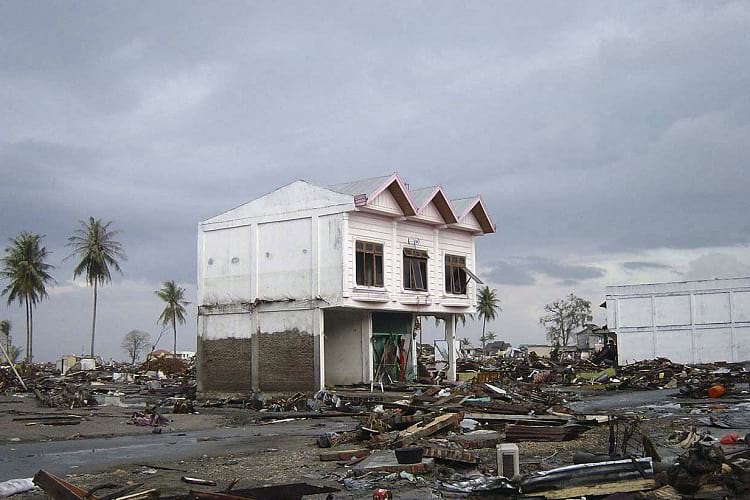
Aftermath of 2014 tsunami disaster in Sumatra, Indonesia. (Michael L. Bak / U.S. military)
On December 26, 2004, one of the most fatal natural disasters ever recorded in the 21st century, shook the core of our planet. An earthquake took place in the middle of the Indian Ocean which caused numerous tsunamis to hit the coastline of the ocean. The quake measured a powerful 9.3 on the Moment Magnitude Scale and a terrifying IX on the Mercalli intensity scale where XII means total destruction.
It caused a colossal amount of destruction and loss of life. 14 countries including Indonesia, Sri Lanka, India, and Thailand were affected, of which Banda Aceh, a city in Indonesia, was the most affected with more than 200,000 deaths. Smaller tremors were also felt in Bangladesh, Malaysia, Myanmar, and the Maldives. Contrary to what one might expect, not just the areas closest to the earthquake were affected. Tremors of the quake were felt in remote areas as far as Alaska which is over 10,000 km away from the epicentre.
The science behind the events
Seismologists were quite shocked at the unusualness of this earthquake. It took place just three days after a magnitude 8.1 earthquake rocked an uninhabited area between New Zealand and Australia. Earthquakes higher than 7 on a moment magnitude scale are known to occur only once per year. The impact of this earthquake was so intense that it is said to have vibrated our entire planet by as much as 1 cm. The quake also changed the speed of Earth’s rotation, causing a trivial shortage of 2.68 microseconds. The effects of the quake were reportedly felt for more than 4 months after it occurred.
This earthquake is termed as a ‘megathrust’ quake because they occur in subduction zones where one tectonic plate is forced below the other. These quakes are some of the most impactful ones where reaching a minimum of 9.0 on the moment magnitude scale is considered quite normal. This megathrust earthquake took place just below the sea causing the topmost layer of land in the deep sea to slide below the topmost layer of land in the shallow sea. The movement of tectonic plates was mostly vertical, however, some lateral movement of the plates was also detected. Due to this, some coastal areas have moved below sea level after the quake.

(Coinmanj / Wikimedia Commons)
Due to a massive amount of water being displaced during earthquakes, tsunamis are an expected part of the package. In this particular case, it was a shocker. Firstly, tsunamis are extremely rare in the Indian Ocean, despite the fact that earthquakes occur quite frequently in this subduction zone. Secondly, there are no warning systems that exist in the Indian Ocean since tsunamis occur more often in the Ring of Fire region of the Pacific Ocean. Although, it was quite lucky that two NASA satellites that were out on an oceanographic mission just happened to pass over the Indian Ocean and they have radars that help them measure and detect inconsistencies in the height of water waves. And lastly, there was a significant amount of time delay between the earthquake and tsunami. It took about 7 hours to reach the coastlines.
On another note, it is generally quite hard to detect tsunamis in deep water. The waves of a tsunami in deep water are barely noticeable and are just broad, shallow humps of water. These broad, shallow humps travel quite fast between approximately 500-1000 kmph. The behaviour of tsunami waves in shallow water changes; they reach great destructive heights but travel at much slower speeds of 90 kmph. The highest tsunami wave triggered during this event was recorded to be at a gigantic 30 m in shallow water but only 50 cm in deep water.
Aftermath of 2004 Tsunami

Aerial photo of a village near the coast of Sumatra after the tsunami. (Philip A. McDaniel / U.S. Navy)
This earthquake is listed as one of the deadliest natural disasters to ever take place. This quake triggered the largest humanitarian response with people across the world donating more than USD 14 billion to the affected countries. The only other earthquakes that have been recorded larger than this on the Moment Magnitude Scale were the Alaskan Earthquake in 1964 with a magnitude of 9.2 and the Chilean Earthquake in 1960 with a magnitude of 9.6, although the number of casualties was nowhere close to the one in 2004.
There are accounts of saviours who recognized the events taking place and warned people in coastal areas to evacuate as soon as possible. One such account was of a 10-year-old girl who had learnt about tsunamis just 10 days earlier in school. She alerted her parents, who understood the gravity of the situation and quickly alerted coastal guards.
It is during such events that we truly understand the importance of just being alive. It is certainly frightening to imagine how nature is capable of near-complete destruction in a matter of seconds. In the blink of an eye, the planet lost 230,000 precious human lives on that day.
Enjoyed this article? Also, check out “Krakatoa Volcano: An Earth-Shattering Explosion That Ruptured the Eardrums of Many“.
Fact Analysis:
STSTW Media strives to deliver accurate information through careful research. However, things can go wrong. If you find the above article inaccurate or biased, please let us know at [email protected].
RELATED
The post 2004 Indian Ocean Earthquake & Tsunami: Remembering the 230,000 People Killed in Its Wake appeared first on .
]]>The post Allahabad to Prayagraj: A Journey of a Historical City into the Modern Times appeared first on .
]]>
Allahabad Junction railway station. (Superfast1111 / Wikimedia Commons)
The Greek philosopher Heraclitus once said that – nothing is permanent except change – and that is the absolute reality of the universe. Change is the way of life and that is how living individuals grow and develop. Humans make changes in and around them, in their surroundings, in nature and in every little thing they come across.
Without change, there is no future and had there been no change in the past, there would have been no present. Speaking of which, in recent times, the one thing that has kept most Indians talking is the renaming of the historic city of Allahabad in the Indian state of Uttar Pradesh, which will now officially become Prayagraj.
A brief history of Allahabad
As per the verbal folklore in Bundelkhand region, Allahabad derives its name from the ballads of a twelfth-century brave general called Alha, who served in King Parmal’s army. Alha fought against Rajput king Prithviraj Chauhan, the stories of which went on to be popularized as poetic narrations that spoke of his great valour. This led people into believing that the ancient city got its name from the Hindi ballads of Alha named Alha-Khand and that subsequently led to the city’s name – Allahabad
Some others believe that the city was initially named Kaushambi by Hastinapur rulers during 1200 to 900 BCE, until the Mughals invaded the country and changed the city’s name. Emperor Akbar in his chronicles – Akbarnamah – mentions the naming of the city in 1583. It is said that the Mughal Emperor first visited the city in the sixteenth century and was so greatly impressed by its location that he named it Allahabad or Alahabas, which literally translates to ‘Residence of God’. He built a fort named Ilahabad on the banks of the confluence of three rivers Ganga, Yamuna and Saraswati, which were and still are collectively known as Prayag. It was only when his grandson Shah Jahan took the throne, he renamed the city from Ilahabad of Allahabad, which until a few days ago, stuck with its identity.

Allahabad Fort. (Vyomtripathi / Wikimedia Commons)
History of the name ‘Prayag’
As per the Hindu mythology and scriptures, when Lord Brahma created the universe, it was at this specific place in the country that he offered his supreme sacrifice, which came to be known as prayag or ‘‘place of offering’. It is also said as per the Vedas, that when the three sacred rivers Ganga, Yamuna and Saraswati met at a point, that particular place came to be known as Triveni Sangam. And hence the place came to be known as prayag, which can also mean a ‘place of confluence’. Whatever the story, the name Prayag remained in the end.
The man behind the new name
A Hindu cleric named Ajay Mohan Bisht, who is popularly known as Yogi Adityanath in India, was sworn in as the Chief Minister of the northern Indian state of Uttar Pradesh. Renouncing his family life and home when he was only 21 years of age, Yogi Adityanath became a disciple of Mahant Avaidyanath, from whom he also received a few tips in Indian politics. Becoming a Member of Parliament at the young age of 26, Yogi Adityanath slowly rose in the political scenario of the country, finally landing the prestigious CM seat of Uttar Pradesh in March 2017.
Yogi Adityanath is the person who has been instrumental in changing the name of the historical city of Allahabad, on the request of his cabinet members in 2018, which currently awaits confirmation. His cabinet ministers had tried to forward a renaming proposal to the Centre on two occasions, once during CM Kalyan Singh’s reign between 1991 and 1992 and the other during current Home Minister Rajnath Singh’s tenure as CM of Uttar Pradesh between the years 2000 and 2002. Prior to the proposal of renaming Allahabad came into force, Yogi Adityanath was also instrumental in renaming another place in Uttar Pradesh. Weeks before Prayagraj was conceptualized, Yogi Adityanath, along with his cabinet ministers, forwarded the suggestion of rechristening Mughalsarai Railway Station as Deen Dayal Upadhyay Junction, naming it after the titular RSS ideologist. The official renaming ceremony of Mughalsarai station was held in August 2018, with a long list of BJP leaders present at the occasion.
The process of changing a city’s name
After the end of the British Rule in India in 1947, several Indian cities were renamed in due course of time, since people believed the names were more anglicized and sounded English. Procedures of changing an Indian city’s official name differ from state to state and it is the duty of the State Legislators to look into it. First, an MLA would raise a request in the form of a resolution, which has the proposal of changing a city’s name. The proposal is then carefully thought upon and finally when the resolution is deliberated and cleared from the State and Centre, the State Legislation makes necessary changes and gives a new name to the city, finally making it public.
Public reaction and after-effects
A lot of flak was received from all corners of the country, once the Yogi Adityanath-led UP government decided to finalize on a new name for the city of Allahabad. Scholars and politicians alike were of the opinion that changing the names of cities randomly do no good and that change was unnecessary and uncalled for. Not only would it affect the Allahabad University, Allahabad Bank or other prestigious institutions bearing the city’s name, but it would also add to the woes in the name of the Allahabad High Court. It would add an extra financial burden on the state government to rename the educational or financial institutions in accordance to the new name of the city. And that in turn, would pinch the pockets of the taxpayers in the state.
Historically the city has its own importance with places of great interest. The Triveni Sangam has its own cultural and religious significance, where the Kumbh Mela is held every twelve years. It is also the site where various national leaders’ ashes after their cremation have been immersed. Allahabad is also the site where the aftereffects of the Sepoy Mutiny of 1857 during the British Rule had taken place, with the massacre of countless Indians. The Allahabad Museum, which is one of the four national museums in the country, holds its own importance with rare collections of unique artworks, prehistoric paintings, and archaeological finds put up on display, talking of the city’s historical prosperity.
The city of Allahabad with its biodiversity of flora, fauna and culturally-different people thriving together in the same region, along with a national prominence is also a historically wealthy place, which has migrated towards a modern world, with its heart still in the right place.
Fact Analysis:
STSTW Media strives to deliver accurate information through careful research. However, things can go wrong. If you find the above article inaccurate or biased, please let us know at [email protected].
RELATED
The post Allahabad to Prayagraj: A Journey of a Historical City into the Modern Times appeared first on .
]]>The post Mowgli was Real: Dina Sanichar, the Indian Boy Raised by Wolves appeared first on .
]]>
Dina Sanichar photo from a newspaper. (Coll. Serge Aroles / Wikimedia Commons)
Mark Twain once said, “Truth is stranger than fiction“! It is also the belief that fiction has its roots in reality and often one has influenced the other. Do the words “man-cub” sound familiar? These words were used to describe the famous character, Mowgli of Rudyard Kipling’s The Jungle Book written in 1894. It was all about a boy or “man-cub” who was raised by wolves in a forest in India.
Discovering the Dina Sanichar, the feral child
Rewind to 1867. Location: A forest in the Bulandshahr district of Uttar Pradesh in India. A group of hunters froze in their tracks, unable to comprehend the vision in front of their eyes. A pack of wolves running in the forest had amongst them an extraordinary being. A part of the pack was a 6-year-old-boy walking on all fours. The wolves had adopted and raised the boy.
There have been several incidents in the history of infants raised by animals in the wild. Such children are known as feral children. The term feral child technically is for a human child who has lived in the wild or cut off from civilization. Some are locked up by another human being with no human contact. And some grow up in the wild, probably raised by animals. These children not only lack basic social skills but also have trouble walking upright.
The hunters saw this unnatural family go into a den and decided to extract the feral child from there and take him back to civilization. They smoked the cave and had to kill the female wolf to capture the boy, whom they took to the Sikandra Mission Orphanage near Agra in India. He was baptized at the orphanage, run by Father Erhardt, a missionary living in India, and since it was a Saturday, he was thus named Dina Sanichar, Hindi for Saturday. It has been documented Father Erhardt observed, “He cannot talk, and though undoubtedly pagal (imbecile or idiotic), still shows sign of reason, and sometimes actual shrewdness”
What do we know about feral children?
Eminent child psychologist, Wayne Dennis noted in his paper, The Significance of Feral Man, in the 1941 American Journal of Psychology, several characteristics of a feral child/man derived from studies. According to Dennis, feral children (man) were untidy and uncivilized in their habits of eating. He also considered them incapable of forming bonds with humans and fairly oblivious to temperature changes. Though this was true for most feral children, Dina Sanichar established a close relationship with another feral child brought to the orphanage on March 5, 1872. Father Erhardt observed, “A strange bond of sympathy attached these two boys together, and the elder one first taught the younger to drink out of a cup.”
Sanichar was not the only wolf child to be rescued. There were cases of four other wolf children found in various parts of India around that time, and many more cases of feral children surfaced in the years to come. In fact, the discovery of feral children all over the world has been a significant topic of study and discussion.
When a feral child was found in Aveyron, France in 1800, a young physician, Jean-Marc Gaspard Itard named the boy Victor and observed him for five years, developing innovative ways to teach him speech. Victor became the subject around whom eminent scholars and psychologists debated and tried to decipher the differences between civilized man and wild animals.
Many people noticed that Victor’s behaviour was uncivilized and more in tandem with the behaviour of wild animals. It was, similarly, observed in many feral children that they displayed behavioural likeness with wild animals as opposed to people of a civilized society.
Sanichar, in the same way, growled and grunted like a wolf, walked on all fours, ate raw meat, sharpened his teeth by gnawing on bones like an animal and detested wearing clothes. People of the orphanage tried to work patiently with him to rid him of his wilderness, and with the passing of time, he became more open to eating cooked food and wearing clothes but showed no progress in speech. Though he wasn’t mute, he only made animal noises.
Studies have shown that feral children cannot incorporate the norm of the society, thus continue to live in a black hole between civilization and wilderness. They say the bridge between the two is language. It was later analyzed and concluded by researchers that apparently, there is a “critical period” for learning a language. If during that period, there’s no form of communication, it is almost impossible to grasp words or comprehend speech.

Dina Sanichar. (Photos of the Past / Flickr)
Avram Noam Chomsky, known as “the father of modern linguistics“, in his 1957 publication Syntactic Structures, wrote that it is a language which enables human experience. According to Chomsky, if people knowing no language are deserted on an island, they would generate a language of their own in a couple of generations.
In his book, Wolf Children and the Problem of Human Nature, philosopher Lucien Malson wrote that Sanichar had put together “cruder, less specifically human” forms of communication. Like many other feral children, he was prone to barking, growling, howling and attacking; probably picked up from the actions of the animals he lived with.
Death of Dina Sanichar
Dina Sanichar lived a short life, dying at the young age of 34. He lived in the orphanage his entire life, showing very little improvement. He could stand erect and walk, dress with a little difficulty, and could monitor his cup and plate. And he had also learned to eat from a plate but would always sniff his food before putting it in his mouth and steered clear of anything that was not meat. Sanichar eagerly took up one human habit, smoking, and turned into a chain smoker. It is speculated that he died of tuberculosis in 1895.
Do you think Rudyard Kipling’s Mowgli could have been inspired by Dina Sanichar?
Enjoyed this article? Also, check out “Victor of Aveyron – The Feral Boy from France“.
Recommended Read:
Wolf Children and the Problem of Human Nature | By Lucien Malson
Fact Analysis:
STSTW Media strives to deliver accurate information through careful research. However, things can go wrong. If you find the above article inaccurate or biased, please let us know at [email protected].
RELATED
The post Mowgli was Real: Dina Sanichar, the Indian Boy Raised by Wolves appeared first on .
]]>The post India’s Jharia Coalfield, a 100 Years of Simmering Greed appeared first on .
]]>
Open-cast mining in Jharia coalfield. (International Accountability Project / Flickr)
Earth began her celestial journey as a ball of fire. She still carries fire in her belly is aptly proved by volcanic eruption world over. What if this fire erupts in erratic, low to high-intensity outbursts of smoke and flame in a particular area? This is a daily sight in the coalfields of Jharia, 7 KMs from Dhanbad district in the state of Jharkhand; peril to inhabitants of the 450 Sq. km area can well be imagined.
The problem is over a hundred years old. Illegal mining, corruption in public life, and world treaty on global warming for minimising thermal energy (produced by burning coal) to check carbon emissions in the environment have made it all the more vexing for the Indian state.
Mining disaster at Jharia Coalfield
Mining was started in this area by the British in 1890. Subsequently, private players forayed into this business. Greed for profiteering made mine owners lax to safety measures and that in course of time made Jharia a burning field emitting greenhouse gases like carbon monoxide, sulphur dioxide and arsenic, polluting air, water and soils to no end.
Large underground mines were passé’ and the premium coke coal (Unique Selling Point of these mines) was increasingly dugout through a quicker and more cost-effective technique of surface blasts open-cast mining.
New shafts dug for quick reach to coal, connected the large underground mined spaces of past era to the air above the ground. This set in motion the spontaneous combustion of coal leading to a trail of infernos playing havoc with on ground flora and fauna, a phenomenon first noted in 1916 and continuing till date.
Fires are not only causing loss of coking coal by way of burning it but also by denying access to untapped reserves of good coal (an estimated total loss of about $ 220 billion). Cardinal railway link to Andra-Gomoh runs through this terrain and its snapping, if deemed inevitable in future, would be huge commercial set back to the state.
Notably, Dhanbad-Patherdih rail line was shut down following land subsidence in 2007, and Adra (West Bengal) Gomoh track was altered to a different route for safety reasons.

Children at work in the dangerous coal field of Jharia. (David Alexander Elder / Flickr)
Efforts from government
Nationalisation of mines in early nineteen seventies aught to have improved situation but didn’t. Large-scale opencast mining brought outside air directly in touch with residual coal inside which acquired a coating of inflammable minerals, causing auto combustion and chain of fire and smoke blitzkrieg.
Loss of life and property mounted by the day, and a need was felt to shift affected population to safer locations; 7 lakh people have already been shifted. The Government of India roped in services of DMT group of Germany to contain the fire but the group complained of poor cooperation from government officials and the task remained largely in limbo.
Coal meets 2/3rd of India’s energy needs, and most of it comes from Jharia coalfield. Unable to tap her own resources, India is forced to import coke coal from outside. Even as China and America are the biggest environmental polluters, global warming protocols mandate India to cut coal consumption to reduce carbon emission.
India must spend a whopping 400 crores per year to buy coke coal from outside to sustain her steel and iron industry. Amount of premium coke that gets burnt to ashes in fires, and the amount that remains undug because of perilous land conditions, is huge. If this is saved somehow, it can be a great boon for the Indian economy. But the situation on the ground is dismal.
Jharia Rehabilitation and Development Authority (JDRA) is engaged in the onerous task of shifting people from singing fields and give them safe base at a distance. Central Institute of Mining and Fuel Research has come up with ways to douse raging fires using nitrogen foam. Smoking ravines and billowing flames though tell a different story. Notwithstanding damage control measures, Jharia seems to be heading to ruin.
JCF (Jharia Coal Fields) may become safe for mining, environment and human habitation, but only if a century-old abuse of nature and natural resources is accounted for. This though is easier said than done.
More photos by Jhonny Haglund.
Enjoyed this article? Also, check out “Ever Heard About the Darvaza Gas Crater That has Been Burning in Flames for the Last 50 years?“.
Optional Visit:
Jharia | Jharkhand, India
Fact Analysis:
STSTW Media strives to deliver accurate information through careful research. However, things can go wrong. If you find the above article inaccurate or biased, please let us know at [email protected].
RELATED
The post India’s Jharia Coalfield, a 100 Years of Simmering Greed appeared first on .
]]>


